By Jim Hammonds and Ed Travis
The North Georgia Relic Hunters Association held its 45th Annual Southeastern Civil War and Antique Gun Show on August 12 and 13. The show was held at the Cobb County Civic Center, in Marietta, Ga., just off Marietta Square.


As the crowd arrived at the show on Saturday, they were greeted by a band playing Civil War period music for the enjoyment of those at the event.
As a special tribute to those who have served our country and community, military personnel, veterans, and first responders were given free admission to the show.
Proceeds from the show help support the club’s yearly operations and our annual charity donations to organizations such as the Marietta Confederate Cemetery, Marietta Parks and Recreation, Calvary Children’s Home, Wreaths Across America, to name a few.
Dealers from around the country had a variety of items for sale; and while the listing were immense, they included dug relics, guns and swords, Civil
45th Annual Southeastern Civil War & Antique Gun Show News
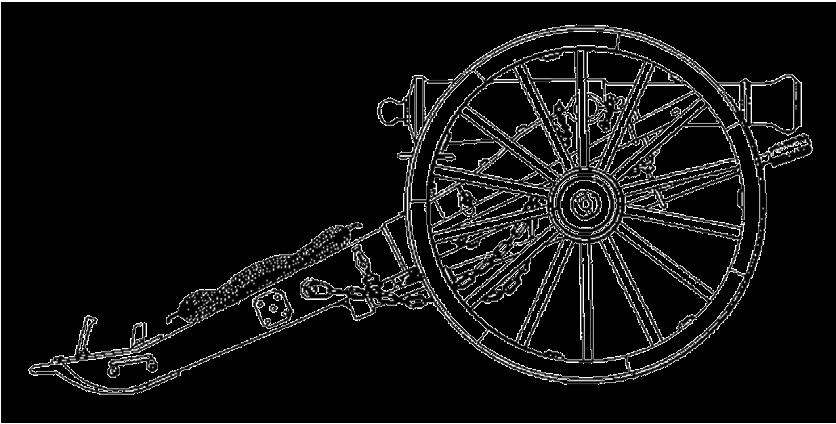
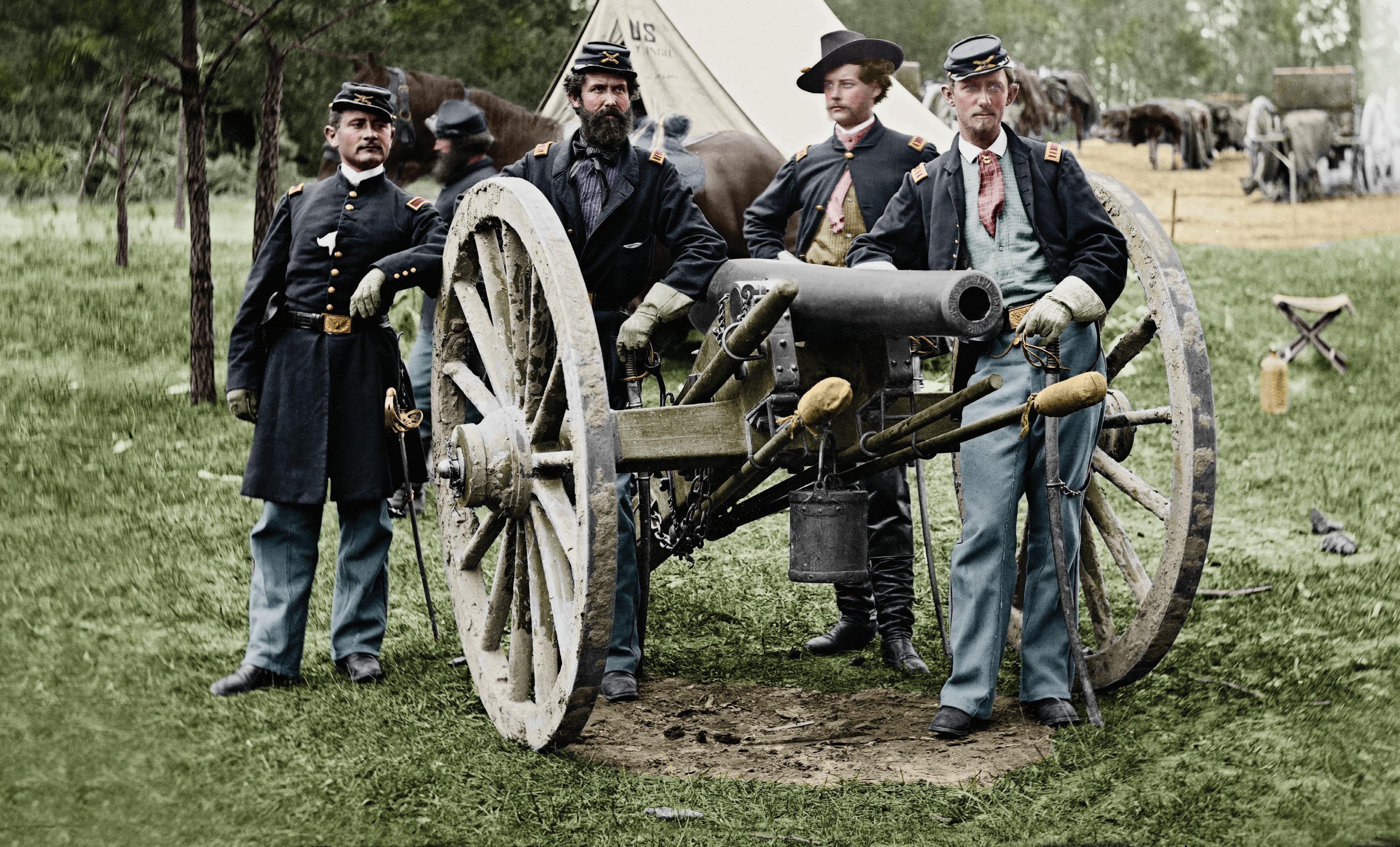
War related books, frameable prints, metal detectors, artillery items, old currency, military accessories, images, and a host of other items.
Guest historian lectures on Saturday at the NGRHA Relic Show were:
10-11:15 – Michael Shafer discussed the 1,630 days accounts of the Civil War in Georgia in his book “Day by Day Through The Civil War in Georgia”
11:30-12:30 – Jeff Wright discussed the preservation of Civil War sites.
1:00-2:00 – Harper Harris shared his account of the Great Locomotive Chase, “The Andrews Raiders.”
2:15-3:15 – Brad Quinlin discussed the 15-year effort to award the two remaining Andrews Raiders the Medal of Honor.
While the show is held near the Kennesaw Mountain National Battlefield Park, items from dozens of Civil War sites around the country were available for purchase.
Appraiser John Sexton provided free appraisals of items brought by visitors for identification and learning more about them. Although the show covered items up to and including World
War II, the show’s main theme related to the American Civil War.
Dealers at the show reported that it was a great show and that they did very well with selling and, in many cases, buying items. Many said they had outstanding sales.
Several awards were given at the show:
Most Educational Award went to Tim Prince for his display of Civil War swords, bayonets, and gun tools.
Excavated Relics Award went to Scott Riddle for his outstanding display of Confederate buckles and buttons.
Many of his displayed items were related to the Georgia Military Academy (GMI), located in Marietta less than one mile from the show’s location.
and plates that included many “one of a kind” buckles. It was certainly a very impressive display.
The Bill Evans Award went to Roy Baker and Stan Wills for their extensive display of Civil War artifacts including Union and Confederate buckles, buttons, and artillery shells, that they have metal detected mainly from Georgia battlefields and campsites.
Door prizes were also given out to folks who came to the show. These consisted of Civil War books and relics found in the vicinity of Kennesaw Mountain but found on private property with permission from the landowner. There was also a “treasure box” where children under 12 could pick out a free prize. These included shark teeth, arrowheads, bullets, shell fragments, books, and other similar prizes.
On Saturday, the door was opened to the general public, and within a few minutes, there was a crowd of people eager to look over the extensive variety of merchandise.
Judges Award went to Bill Blackman for his outstanding display of Confederate buckles
Vol. 49, No. 10 40 Pages, October 2023 $4.00 America’s Monthly Newspaper For Civil War Enthusiasts 18 – American Battlefield Trust 34 – Book Reviews 14 – Central Virginia Battlefield Trust 30 – Critic’s Corner 32 – Emerging Civil War 39 – Events 26 – Library of Congress 28 – The Graphic War 22 – The Source 24 – This And That 10 – The Unfinished Fight H Southeastern . . . . . . . . . . . . see page 4
All of the show tables were packed full of artifacts, antique weapons, and memorabilia.
Civil War News
Published by Historical Publications LLC
2800 Scenic Drive, Suite 4-304, Blue Ridge, GA 30513 800-777-1862 • Facebook.com/CivilWarNews
mail@civilwarnews.com • civilwarnews.com
Advertising: 800-777-1862 • ads@civilwarnews.com
Jack W. Melton Jr. Publisher C. Peter & Kathryn Jorgensen Founding Publishers
Editor: Lawrence E. Babits, Ph.D.
Advertising, Marketing & Assistant Editor: Peggy Melton
Columnists: Craig Barry, Salvatore Cilella, Stephen Davis, Stephanie Hagiwara, Gould Hagler, Chris Mackowski, Tim Prince, and Michael K. Shaffer
Contributor & Photography Staff: Curt Fields, Michael Kent, Shannon Pritchard, Leon Reed, Bob Ruegsegger, Carl Sell Jr., Gregory L. Wade, Joan Wenner, J.D., Joseph Wilson
Civil War News (ISSN: 1053-1181) Copyright © 2023 by Historical Publications LLC is published 12 times per year by Historical Publications LLC, 2800 Scenic Drive, Suite 4-304, Blue Ridge, GA 30513. Monthly. Business and Editorial Offices: 2800 Scenic Drive, Suite 4-304, Blue Ridge, GA 30513, Accounting and Circulation
Offices: Historical Publications LLC, 2800 Scenic Drive, Suite 4-304, Blue Ridge, GA 30513. Call 800-777-1862 to subscribe. Periodicals postage paid at U.S.P.S. 131 W. High St., Jefferson City, MO 65101.
POSTMASTER: Send address changes to: Historical Publications LLC 2800 Scenic Drive Suite 4-304 Blue Ridge, GA 30513
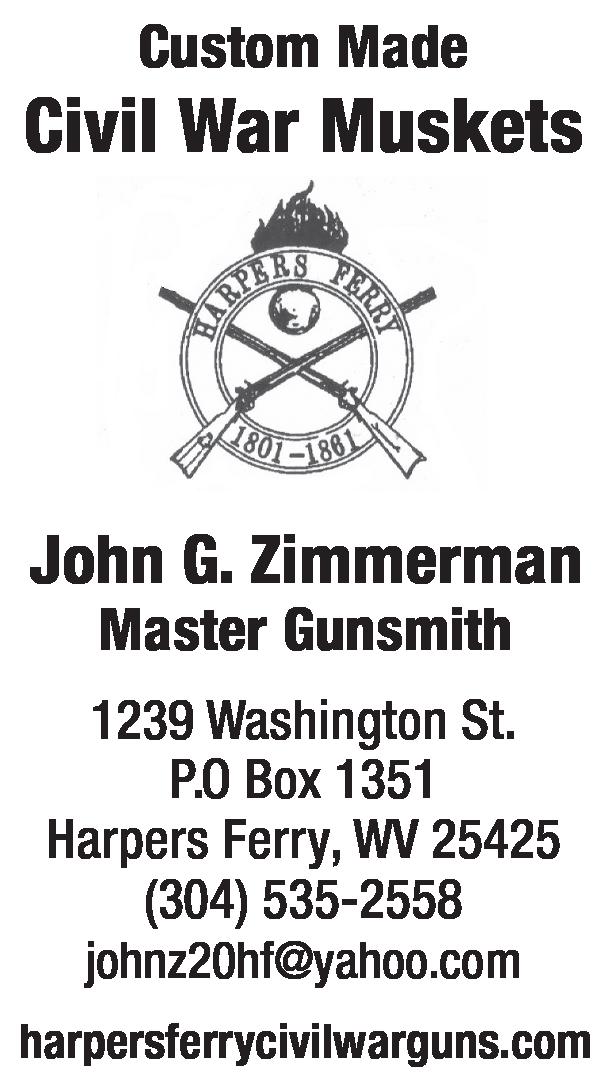
Display advertising rates and media kit on request. The Civil War News is for your reading enjoyment. The views and opinions expressed herein are those of its authors, readers and advertisers and they do not necessarily reflect the official policy or position of Historical Publications, LLC, its owners and/or employees.
Current Event Listings
To see all of this year’s current events visit our website at: HistoricalPublicationsLLC.com
Please send your book(s) for review to: Civil War News
2800 Scenic Drive Suite 4-304 Blue Ridge, GA 30513
Email cover image to bookreviews@civilwarnews.com. Civil War News cannot assure that unsolicited books will be assigned for review. Email bookreviews@civilwarnews.com for eligibility before mailing.
ADVERTISING INFO:
Email us at ads@civilwarnews.com Call 800-777-1862
MOVING?
Contact us to change your address so you don’t miss a single issue. mail@civilwarnews.com • 800-777-1862
Terms and Conditions
The following terms and conditions shall be incorporated by reference into all placement and order for placement of any advertisements in Civil War News by Advertiser and any Agency acting on Advertiser’s behalf. By submitting an order for placement of an advertisement and/or by placing an advertisement, Advertiser and Agency, and each of them, agree to be bound by all of the following terms and conditions:
1. All advertisements and articles are subject to acceptance by Publisher who has the right to refuse any ad submitted for any reason. Mailed articles and photos will not be returned.
2. The advertiser and/or their agency warrant that they have permission and rights to anything contained within the advertisement as to copyrights, trademarks or registrations. Any infringement will be the responsibility of the advertiser or their agency and the advertiser will hold harmless the Publisher for any claims or damages from publishing their advertisement. This includes all attorney fees and judgments.
3. The Publisher will not be held responsible for incorrect placement of the advertisement and will not be responsible for any loss of income or potential profit lost.
4. All orders to place advertisements in the publication are subject to the rate card charges, space units and specifications then in effect, all of which are subject to change and shall be made a part of these terms and conditions.
5. Photographs or images sent for publication must be high resolution, unedited and full size. Phone photographs are discouraged. Do not send paper print photos for articles.
6. At the discretion of Civil War News any and all articles will be edited for accuracy, clarity, grammar, and punctuation per our style guide.
7. Articles can be emailed as a Word Doc attachment or emailed in the body of the message. Microsoft Word format is preferred. Email articles and photographs: mail@civilwarnews.com
8. Please Note: Articles and photographs mailed to Civil War News will not be returned unless a return envelope with postage is included.
2 CivilWarNews.com October 2023 2 October 2023 CivilWarNews.com
UBLISHERS :
P
SUBSCRIPTION RATES
Deadlines for Advertising or Editorial Submissions is the 20th of each month. Email: ads@civilwarnews.com Digital Issues of CWN are available by subscription alone or with print plus CWN archives at CivilWarNews.com Advertisers In This Issue: Ace Pyro LLC 27 American Battlefield Trust 31 Artilleryman Magazine 12 Ashley R. Rhodes Militaria 15 CWMedals.com, Civil War Recreations 20 Civil War Navy Magazine 21 College Hill Arsenal – Tim Prince 27 Day by Day through the Civil War in Georgia – Book 23 Dell’s Leather Works 11 Dixie Gun Works Inc. 12 Georgia’s Confederate Monuments – Book 25 Gettysburg Foundation 9 Gunsight Antiques 11 Harpers Ferry Civil War Guns 2 Hood’s Defeat Near Fox’s Gap – Book 37 The Horse Soldier 4 James Country Mercantile 27 Le Juneau Gallery 12 “I thank the Lord I’m not a Yankee” – Book 31 Mike McCarley – Wanted Fort Fisher Artifacts 21 Military Images Magazine 5 National Museum of Civil War Medicine 19 N-SSA 21 Powder Inc. 21 Regimental Quartermaster 19 Richard LaPosta Civil War Books 34 Shiloh Chennault Bed and Breakfast 11 Suppliers to the Confederacy – Book 23 Ulysses S. Grant impersonator – Curt Fields 19 Events: Elite Collectors Civil War Show 22 MKShows, Mike Kent 3, 39 Military Antique Show – Virginia 27 Poulin’s Auctions 40
U.S. Subscription rates are $41/year, digital only $29.95/year, add digital to paper subscription for only $10/year more. Subscribe securely at CivilWarNews.com
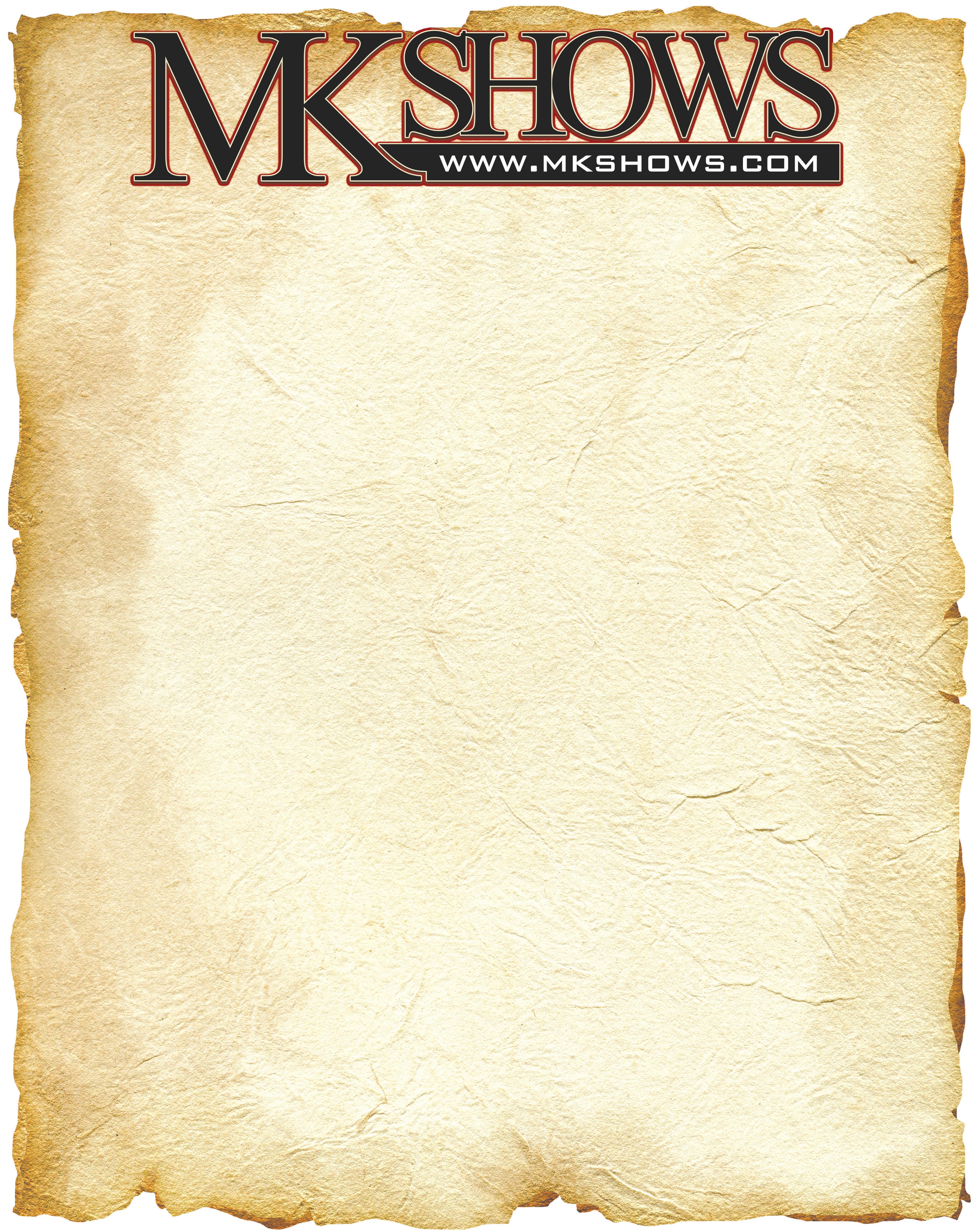
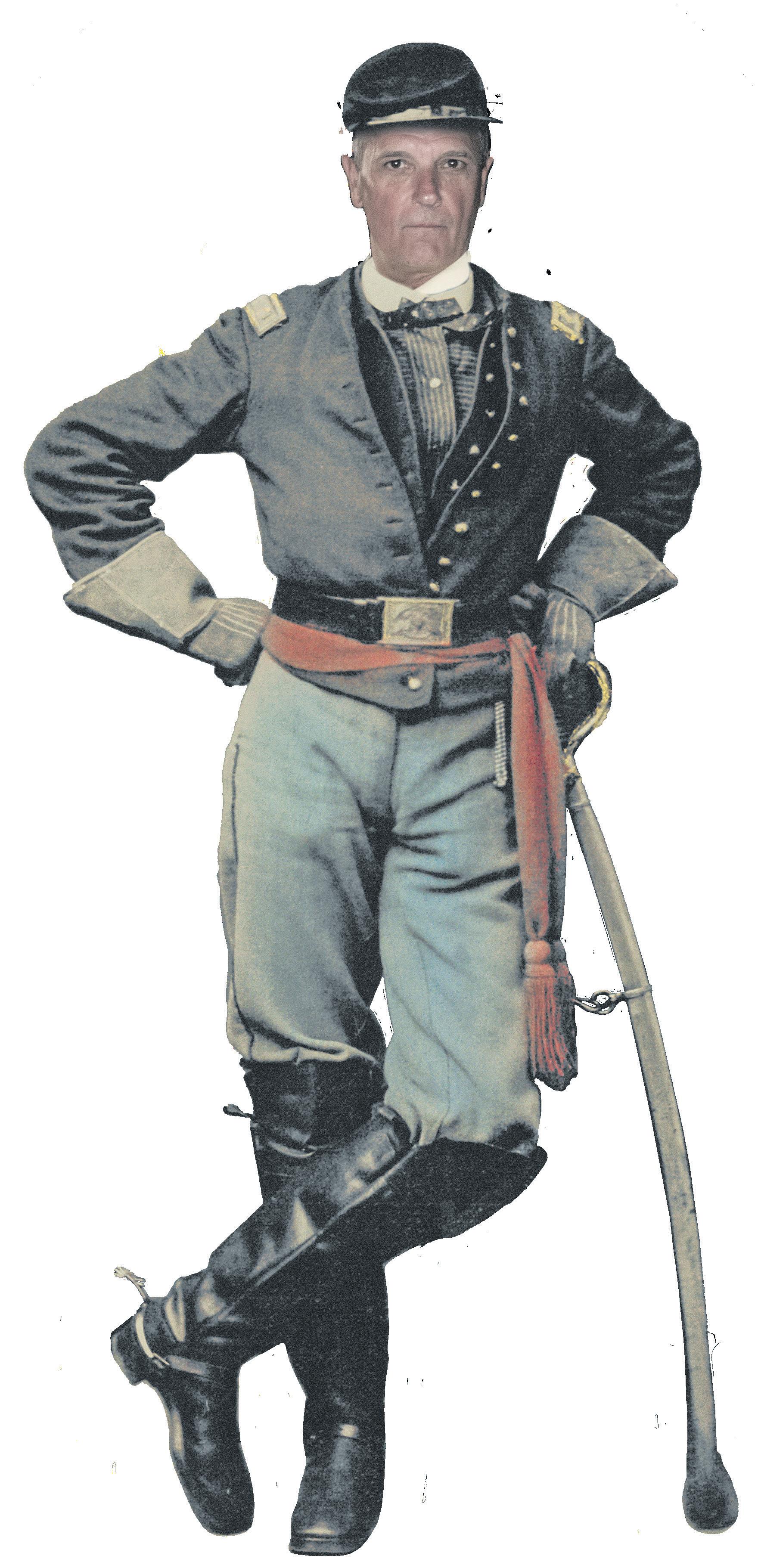
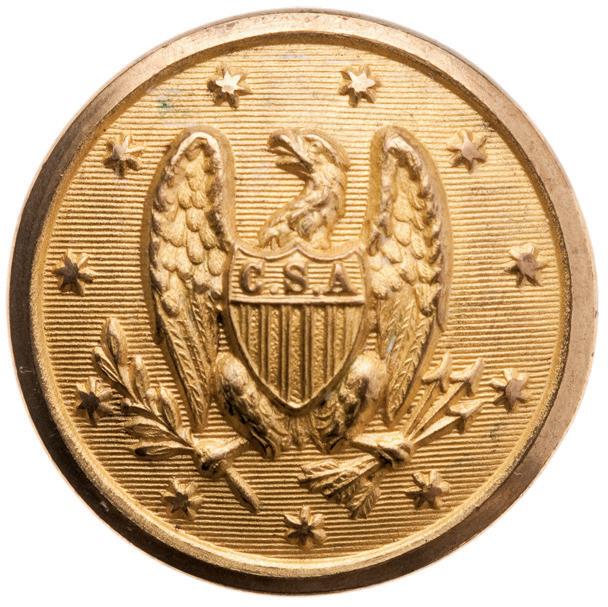
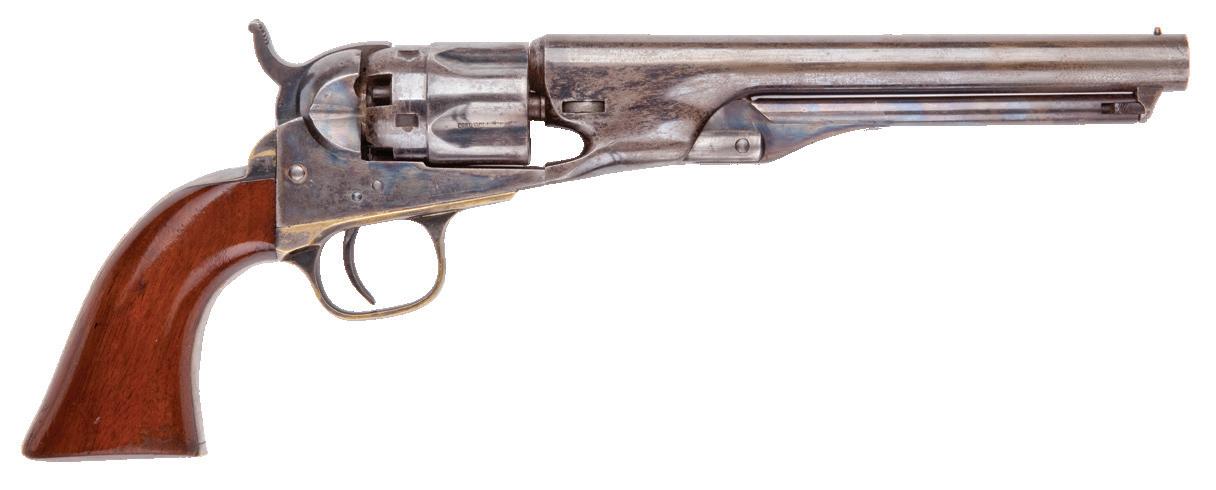

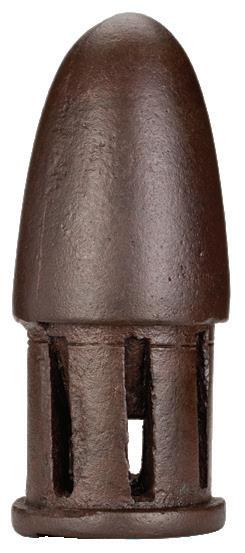
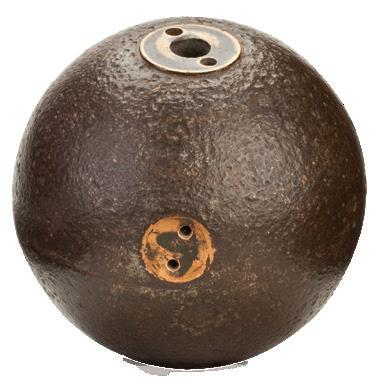
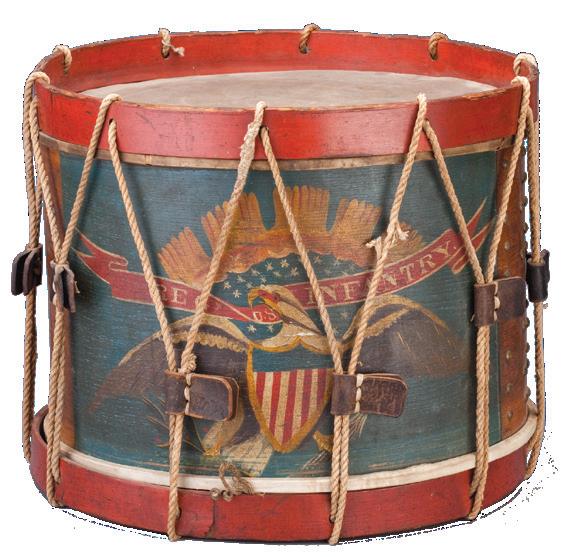


Mike Kent & Associates, LLC • PO Box 685 • Monroe, GA 30655 770-630-7296 • Mike@MKShows.com • www.MKShows.com Military Collectible & Gun & Knife Shows Presents The Finest Williamson County Ag Expo Park 4215 Long Lane Franklin, TN 37064 Dec. 2 & 3, 2023 Middle TN (Franklin) Civil War Show Promoters of Quality Shows for Shooters, Collectors, Civil War and Militaria Enthusiasts Exchange Park Fairgrounds 9850 Highway 78 Ladson, SC 29456 Nov. 25 & 26, 2023 Charleston Gun & Knife Show WNC Ag Center 1301 Fanning Bridge Road Fletcher, NC Oct. 7 & 8, 2023 Asheville Gun & Knife Show Myrtle Beach Convention Center 2101 North Oak Street Myrtle Beach, SC 29579 Nov. 4 & 5, 2023 Myrtle Beach Gun & Knife Show Dalton Convention Center 2211 Tony Ingle Parkway Dalton, GA 30720 Feb. 3 & 4, 2024 Chickamaugua “Dalton” Civil War Show
from page 1
A show raffle was for a wooden display case containing eagle buttons, a US box plate, dropped .58 caliber bullets, dropped Spencer bullets, a Confederate banknote, Grand Army of the Republic buttons, and a Grand Army of the Republic reunion ribbon. The winner was Daniel Langley of Newman, Ga.
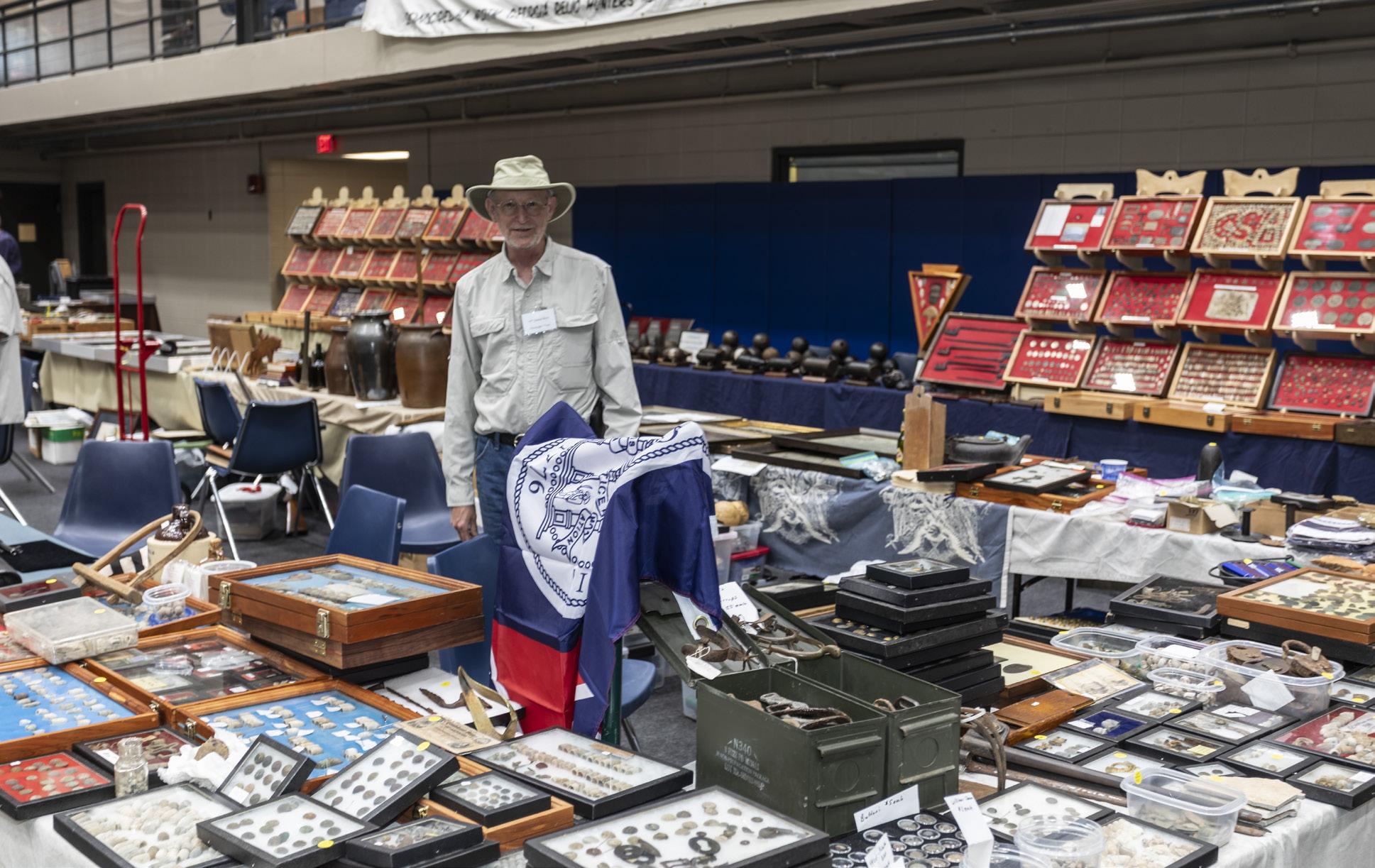
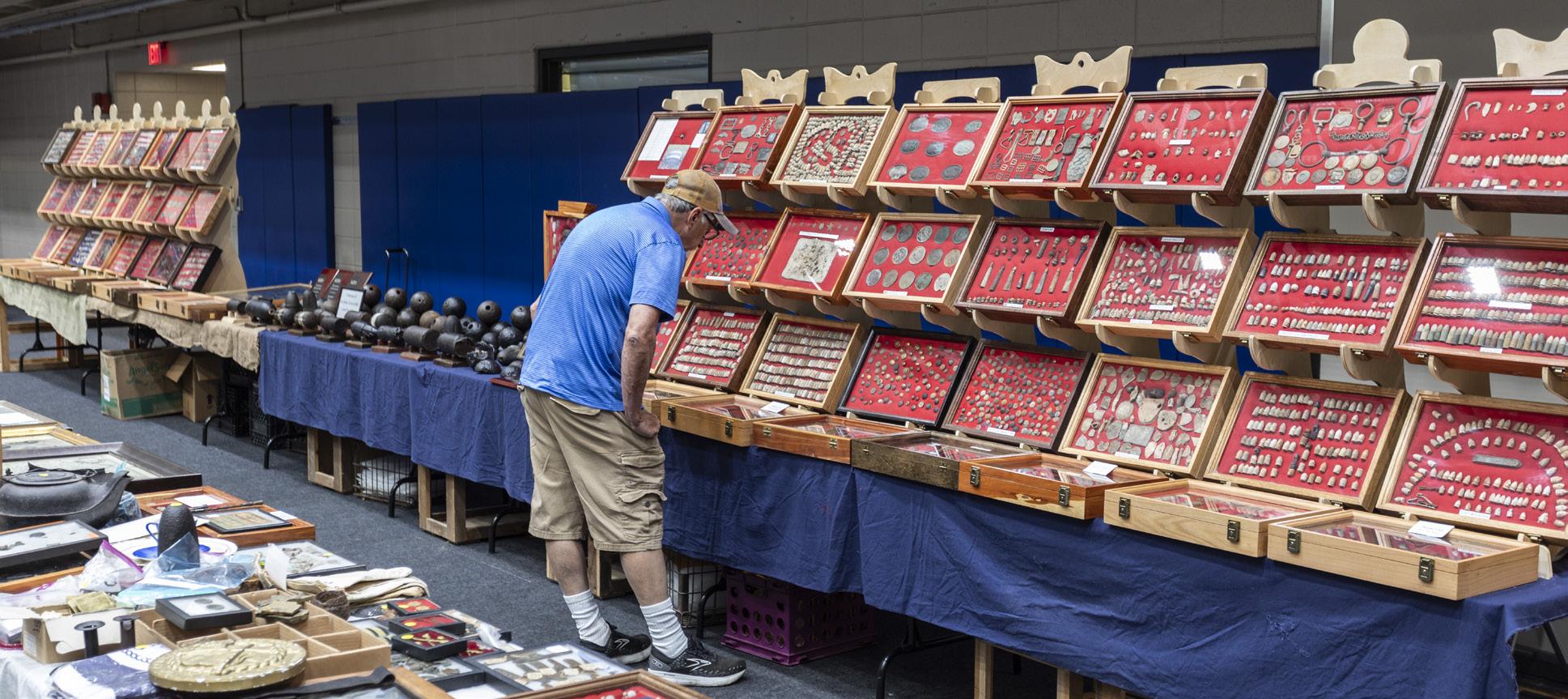
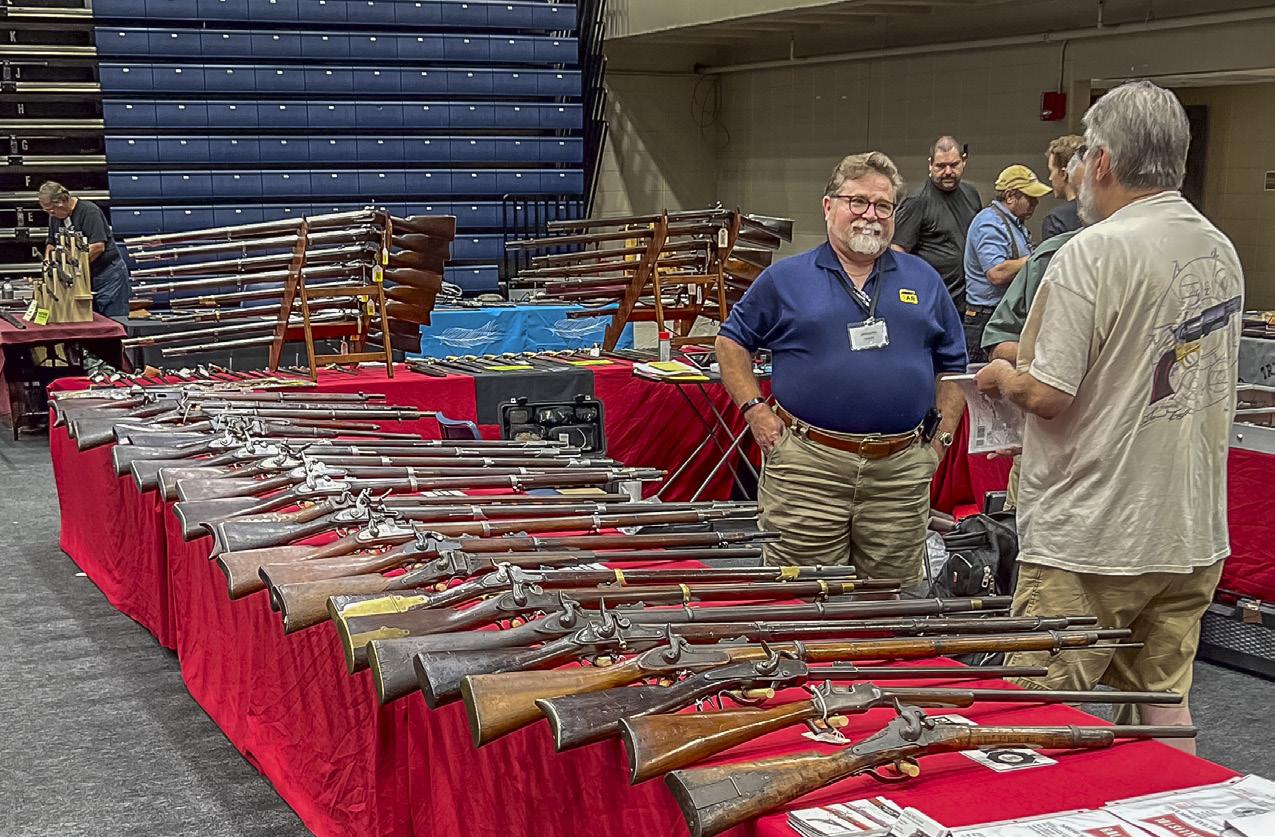
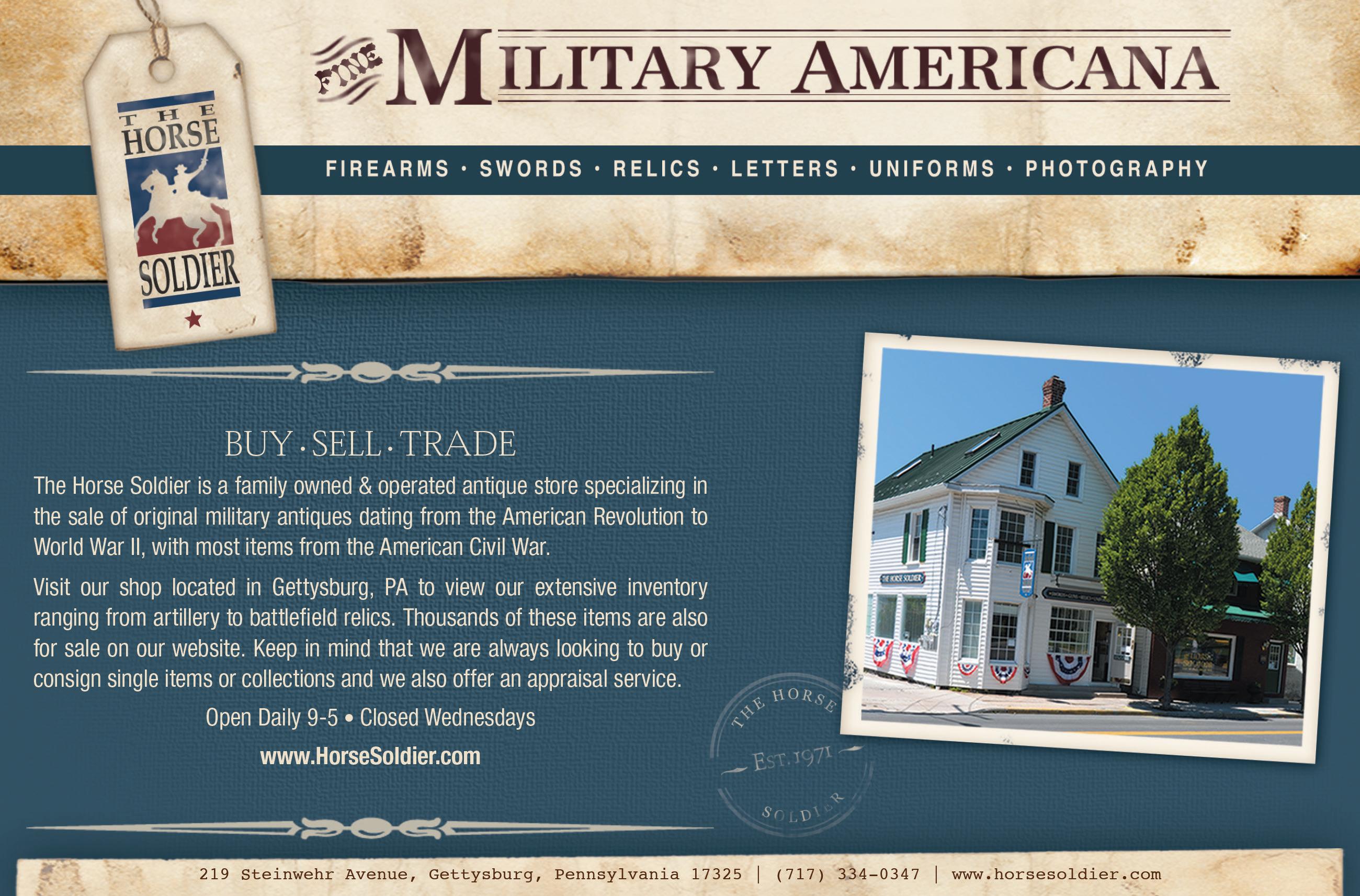
Overall, everyone (dealers and participants) reported they felt the show was a great success. Overall attendance was good with numbers on par with “preCOVID” shows, sales reported by dealers) were plentiful, and all had a good time spending time with fellow enthusiasts; especially the dealers who we generally only see at this and other related relic shows.
The club’s 46th Annual show is in the planning stages; the dates are set for August 10 and 11, 2024, at the Cobb County Civic Center.
For more information about the North Georgia Relic Hunters Association and their annual show for 2024, visit the club’s website at www.ngrha.com or the club’s Facebook page, “North Georgia Relic Hunters Association” which is open to the public.
Since 1972, the North Georgia Relic Hunters Association has dedicated itself to the preservation of artifacts of the American past. Each member is a student of American history and collectively we strive to pass on the knowledge we have gained through school lecture programs, living history presentations, and relic shows—to mention a few.
4 CivilWarNews.com October 2023 4 October 2023 CivilWarNews.com Visit Our New Website CivilWarNews.com
. . . . . . . . . . .
Current Event Listings To see all of this year’s current events visit our website: CivilWarNews.com
H Southeastern
Tim Prince, an author and an appraiser on the show Antique Roadshow, offered a variety of Civil War weaponry that included something suitable for everybody interested in acquiring a piece of history.
Roy Baker and Stan Wills were awarded the Bill Evans Award due to their impressive display of Civil War items that they presented.
Collector Chris Taras set up sale tables featuring excavated artifacts from all over the country.
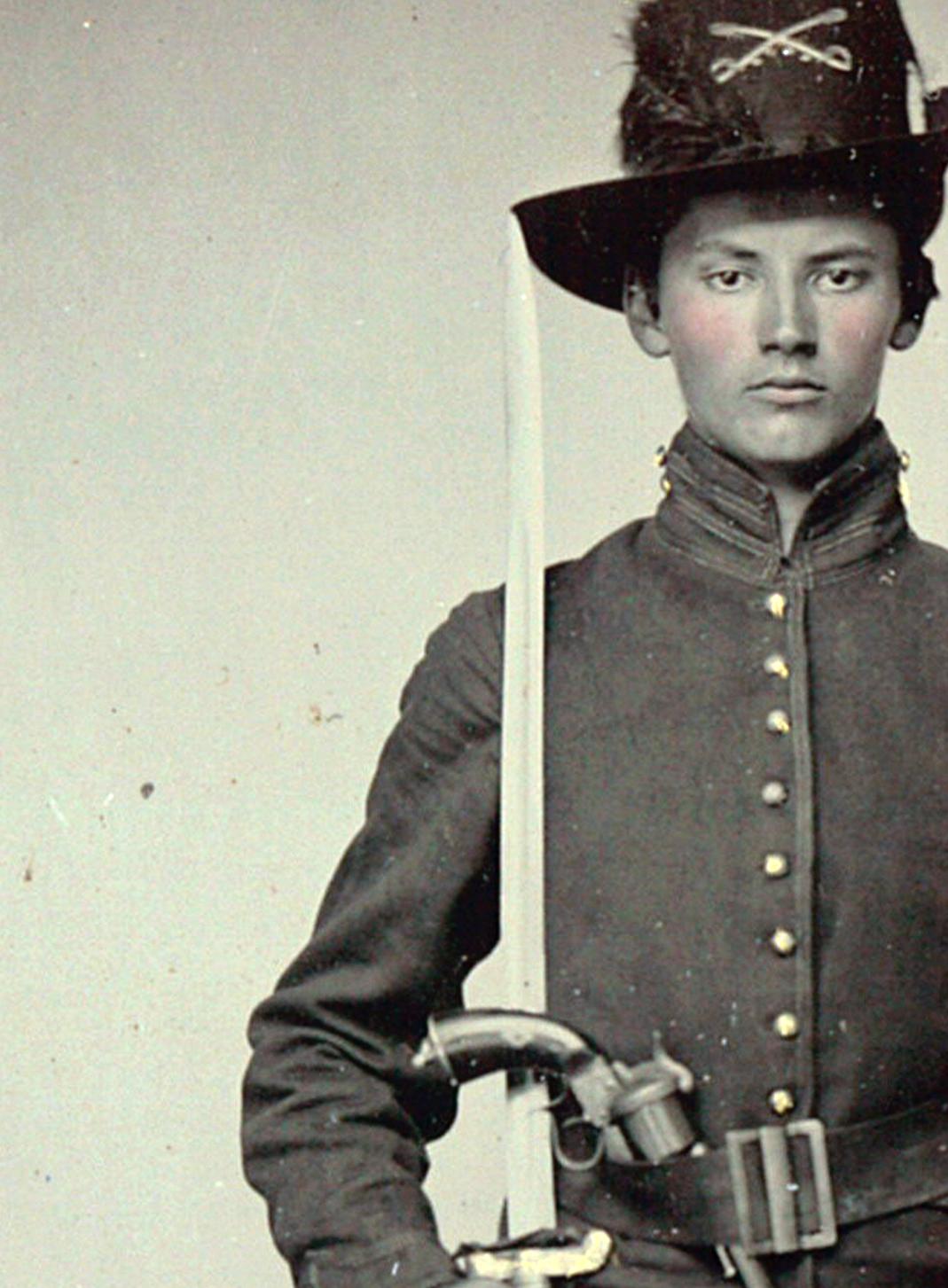
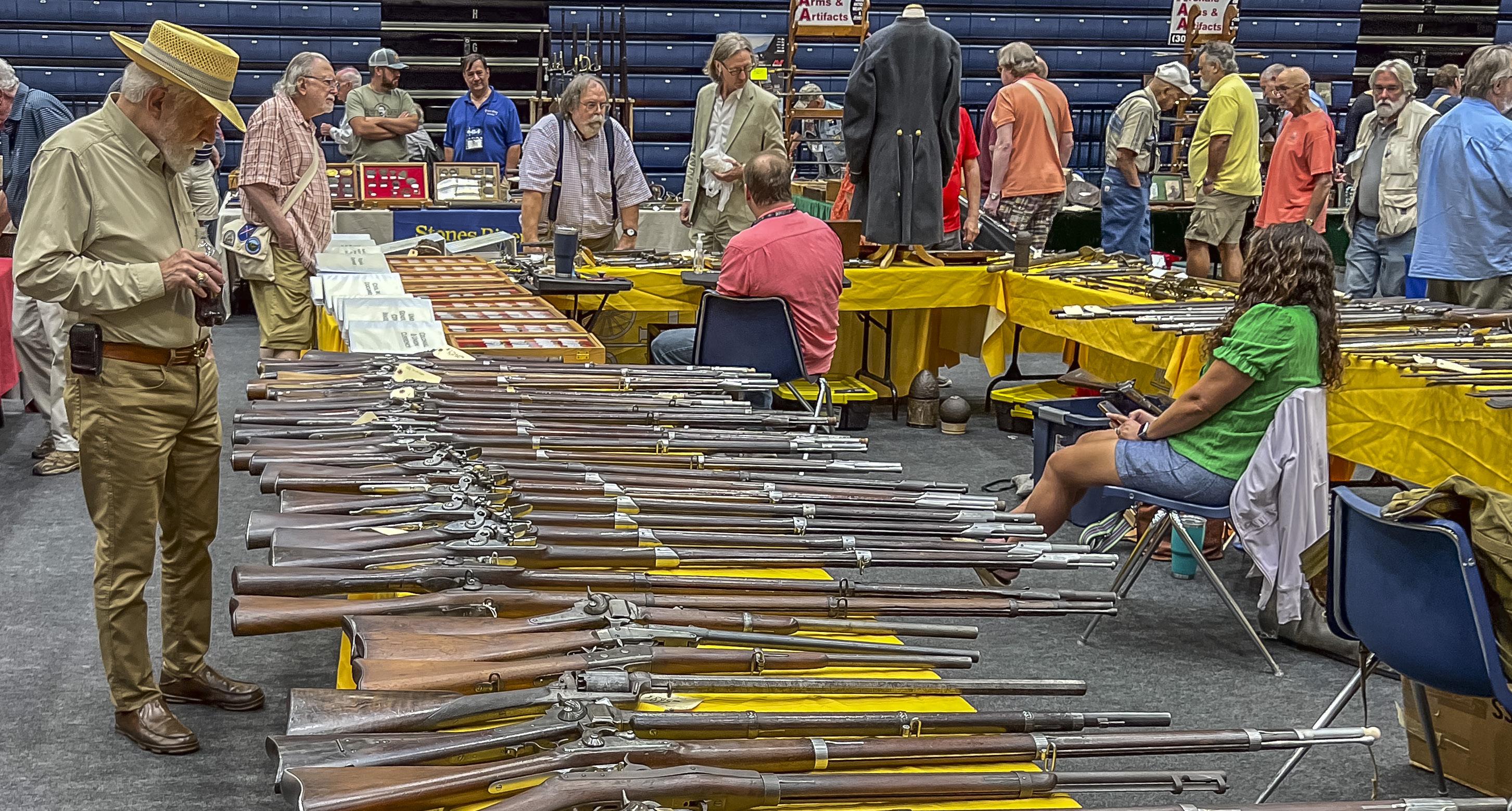
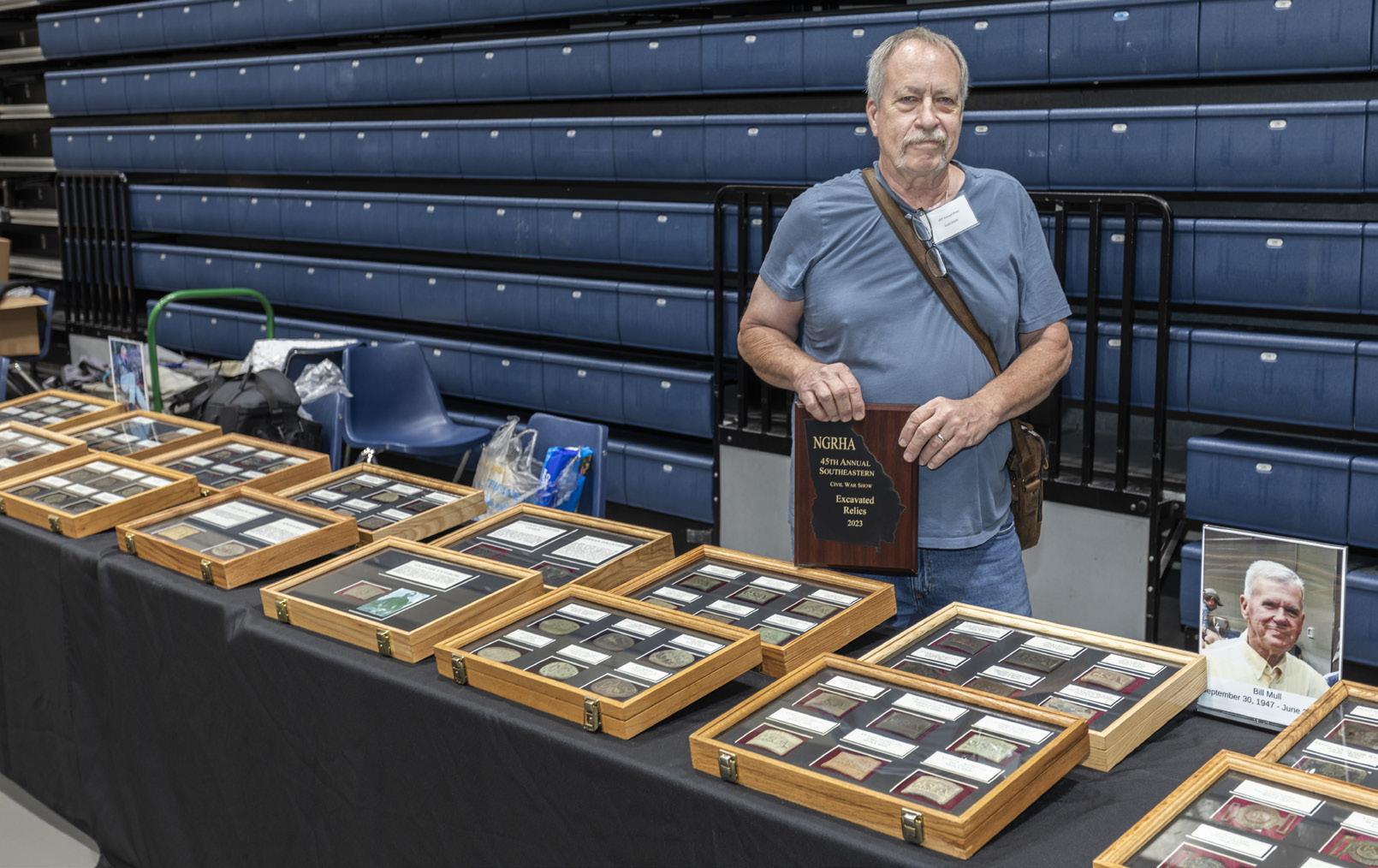


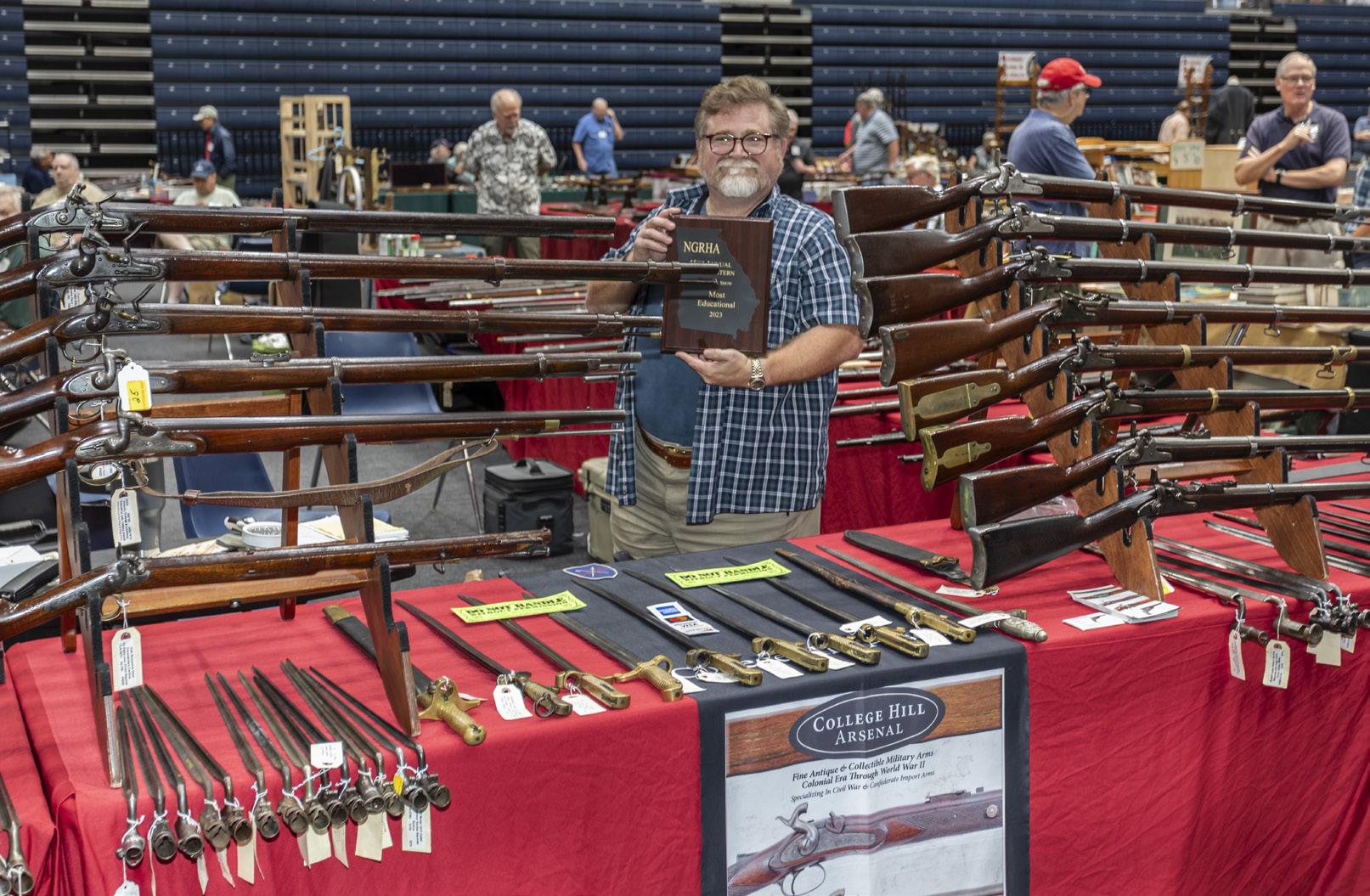

5 October 2023 5 October 2023 CivilWarNews.com CivilWarNews.com MI Since 1979 Military Images magazine Showcase. Interpret. Preserve. MilitaryImagesMagazine.com | Facebook.com/MilitaryImages America’s only publication dedicated to historic photographs of soldiers and sailors. Or send a check payable to: Military Images PO Box 50171 Arlington, VA 22205 Subscribe online: MilitaryImagesMagazine.com SUBSCRIBE NOW 4 quarterly issues, $24.95
Rafael Eledge (orange shirt) brought an extensive collection of antique firearms for sale.
Excavated Relics Award went to Scott Riddle.
Judges Award went to Bill Blackman.
David LaSlavic, owner of Arizona Swords, brought a variety of swords and other edged weapons with him.
Most Educational Award went to Tim Prince.
Civil War artillery projectiles recovered from Southern battlefields from the collection of Roy Baker and Stan Wills.
Clifton, Headquarters With A View for Both Sides in 1864
By Carl L. Sell Jr
Situated on a knoll in the northern part of the Shenandoah Valley, the Clifton estate was used as a headquarters and observation post by both sides during the Civil War. General Robert E. Lee’s Army of Northern Virginia passed by on the way to Gettysburg in June 1863 and Union Major General Philip Sheridan planned his 1864 campaign to control the valley at Clifton in September 1864.
Records show that General Lee and Lieutenant General James Longstreet went to church in Berryville on June 19, 1863. Lee’s headquarters was on Trap Hill, north of town, before he continued on to Maryland on June 24, passing Clifton on the way.
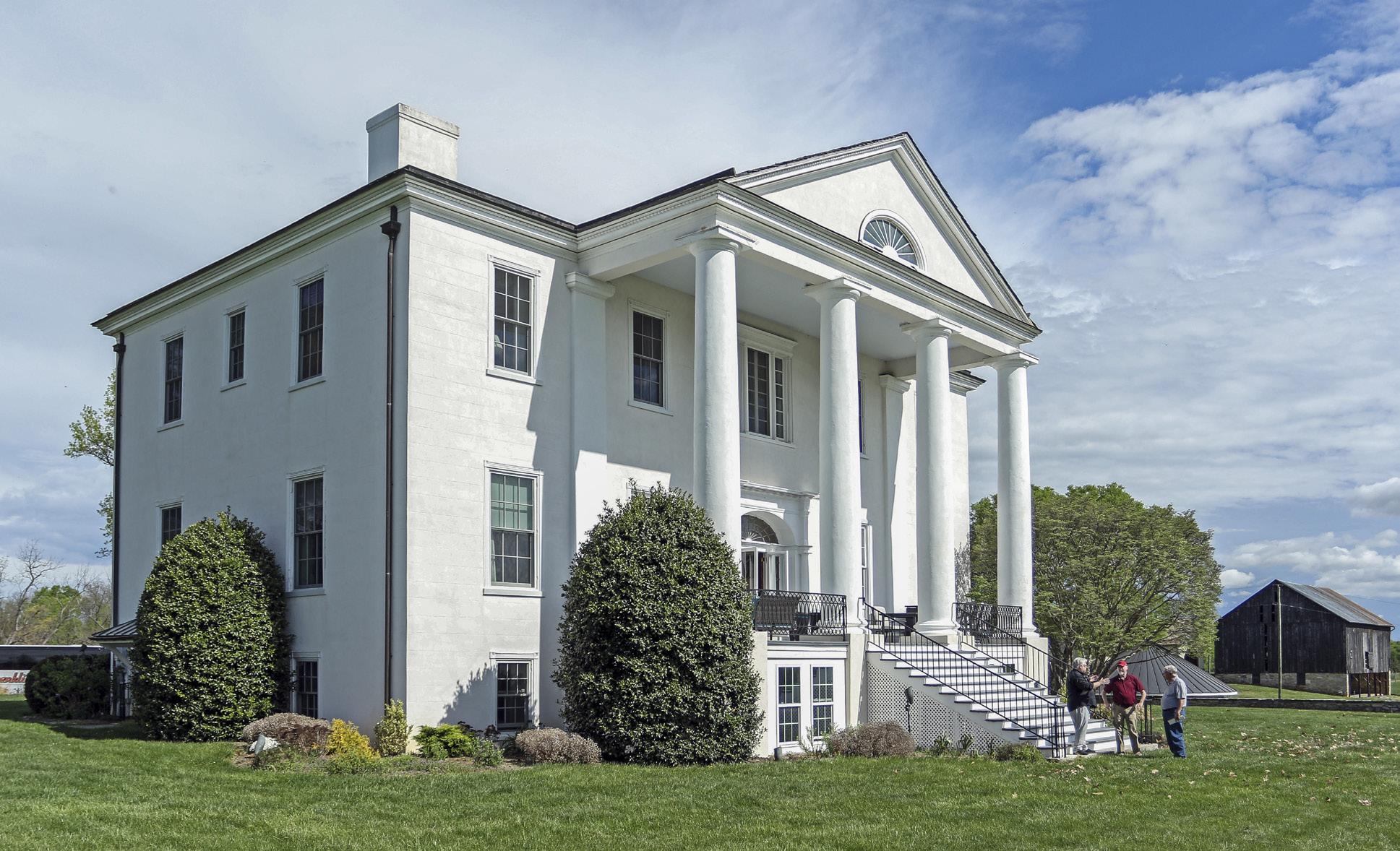
Throughout the war, opposing armies and patrols passed by Clifton. Many stopped to set up camp or seek a handout from the Allen family who occupied the house. Surprisingly, there was little actual damage done to the house and its outbuildings.

That’s not to say that provisions weren’t liberally appropriated, and the fields weren’t marred by hundreds of soldiers foraging during a long march. When Sheridan’s men left, they took away almost everything they could carry.
Construction of the house was completed in 1834 by David Hume Allen, who lived there with his wife, Sarah Griffin Taylor Allen, until he died in 1854 at age 73. They were married in 1808. Sarah died in 1874.
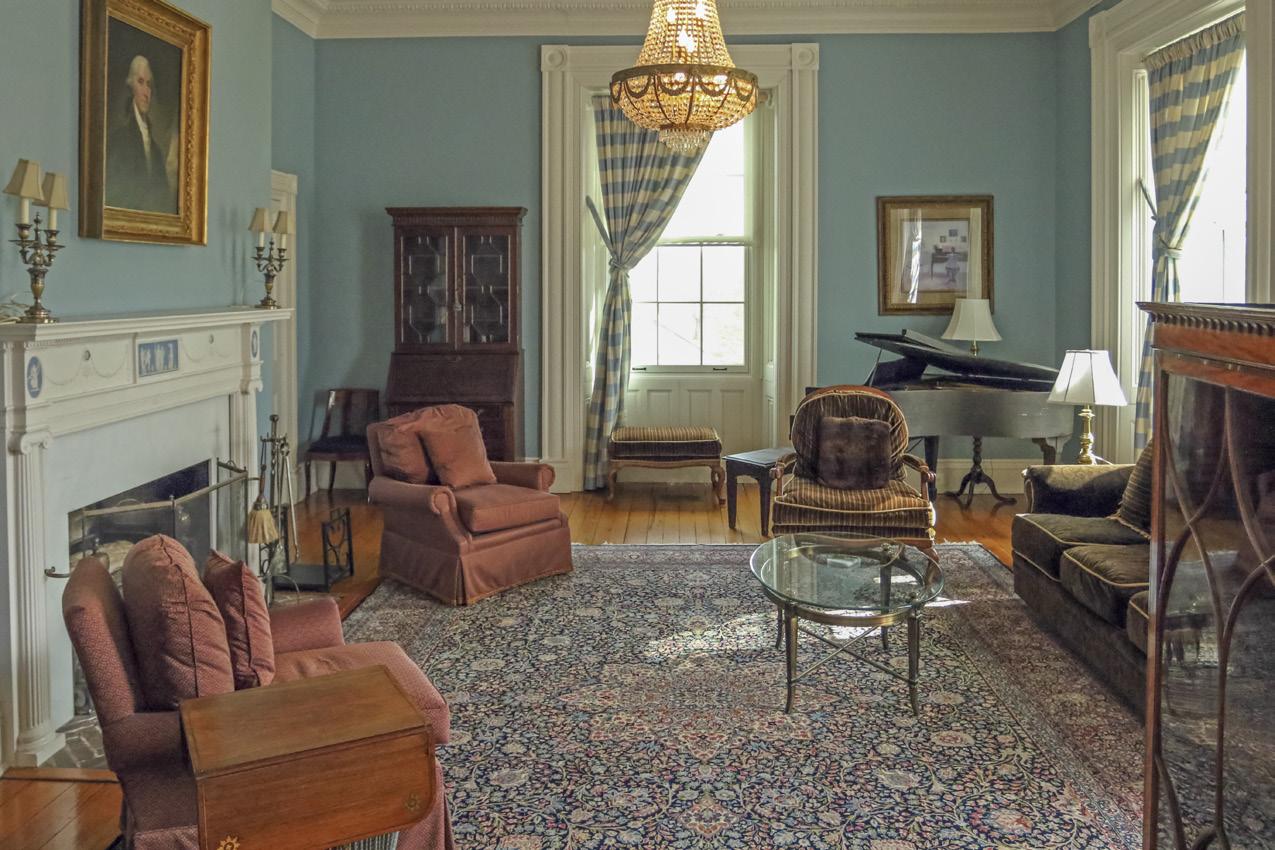
The Allens kept a daybook of events involving the estate. It was continued by Edgar Allen, David's son, who lived at Clifton
with his family. The daybook and portions of a diary by Lucy Ellen Allen, daughter of David and Sarah, provided historical information for this article.
Clifton remained in the Allen family ownership until 1988.
The 411-acre farm straddling the Virginia-West Virginia line north of Berryville, Va., is now held as part of a private trust.

There was little direct action in and around Clifton early in the war, but the farm was often visited by soldiers on both sides. That changed in 1862 when Confederate forces under General Thomas (Stonewall) Jackson and Major General A.P. Hill encamped after the bloody battle at Antietam. Jackson’s cavalry guarded the area from West Virginia to Berryville and some riders spent nights in Clifton’s barn. Hill’s Light Division, which saved the day for the Confederates at Antietam, bivouacked along the Shenandoah River, and repelled several Union attacks at Castleman’s Ferry, just south of Clifton.
The major Civil War events happened at Clifton in July and September 1864. Confederate Lieutenant General Jubal Early’s force, which had threatened Washington City, arrived on July 17. The Union Army was in hot pursuit and tried to engage Early’s forces at Castleman’s Ferry on the Shenandoah River.
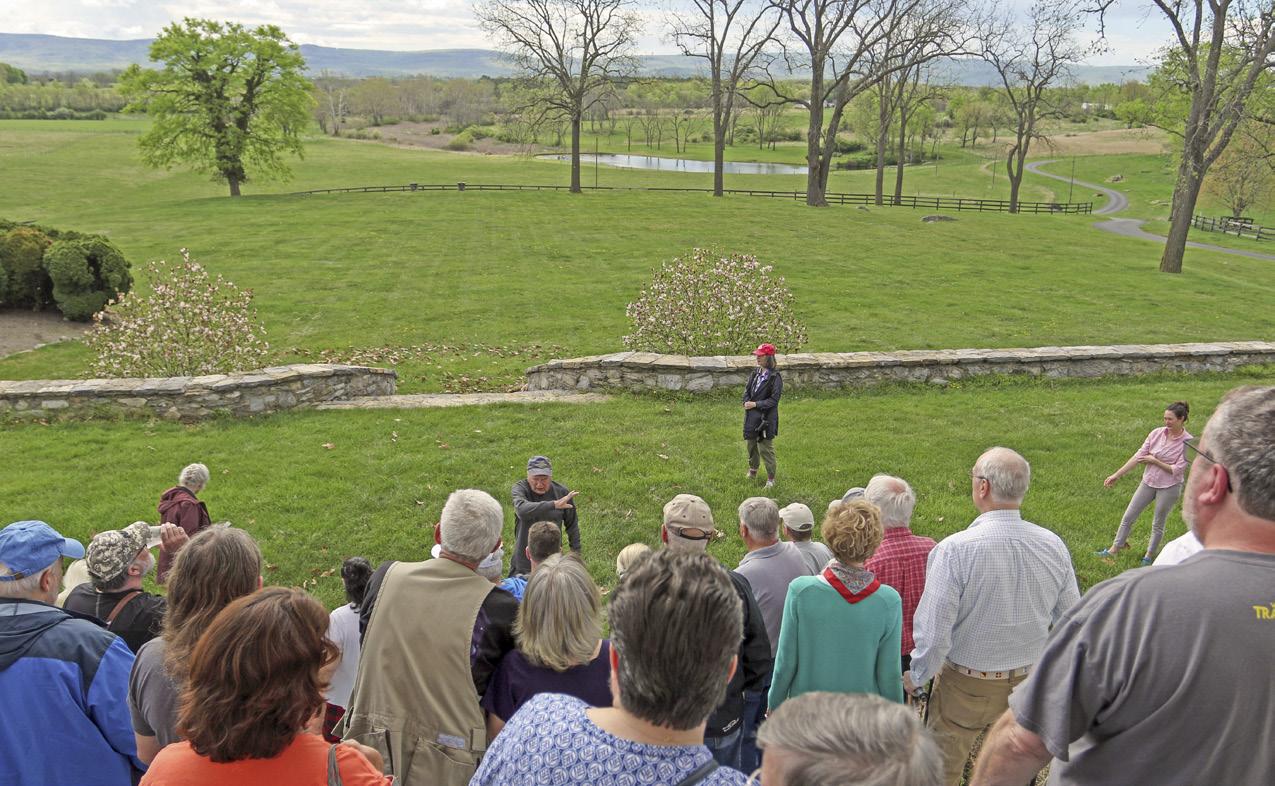
Then, in August and September, Lieutenant General Phillip Sheridan’s new Army of the Shenandoah set up headquarters at Clifton as a prelude to his campaign to oust Early and his army from the area which supplied much of the Confederates’ food supply.
July 18, the Confederates thwarted a Union attempt to cross the Shenandoah River, so Colonel Joseph Thoburn moved his cavalry downriver to Cool Spring and tried again with infantry support. This time, the Yankees got across but were driven back by a Confederate counterattack by forces under Brigadier General Robert Rodes whose division had been strung out along the river near Clifton. The Yankees retreated across the Shenandoah and Early soon continued his march toward Winchester and a more permanent camp.
The firing of artillery, rifles, and rising smoke could be seen from Clifton, where Early established a temporary headquarters according to the farm’s daybook. According to the record, General Early left on July 20.
After the Confederates defeated Union Brigadier General George Crook at Second Kernstown on July 24, Early sent Brigadier General John McCausland and 2,800 cavalrymen on a raid into Maryland and Pennsylvania. The raiders burned Chambersburg, Penn., to cinders on July 30, an event that greatly angered General Ulysses S. Grant, the overall Union commander.
Sheridan immediately began organizing his new command. He arrived at Clifton and remained until August 18, according to the house daybook. The army consisted of the VI Corps under Horatio Wright, the VII Corps under George Crook, and the XIX Corps under William Emory. All were major generals. Wright and Crook were involved at Cool Spring and Crook was the commander at Second Kernstown.
In the foggy early morning hours of August 13, 1864, a long wagon train, some 500 wagons, lumbered past Clifton on the Charles Town-Berryville Turnpike (today’s U.S. 340).
They were under observation by Confederate scouts who were part of Colonel John Singleton Mosby’s Forty-Third Battalion, Virginia Cavalry, a partisan outfit that was wreaking havoc
6 CivilWarNews.com October 2023 6 October 2023 CivilWarNews.com
View from front porch of Clifton.
Inside at Clifton
Clifton smokehouse side view
Clifton looking toward the Blue Ridge.
Clifton.
on Union troop movements and supplies. The wagon train was loaded with supplies for the Yankees shadowing Early’s Confederates. Mosby himself was not far away at Springfield Farm, east of Berryville.
The wagon train halted about a mile north of Berryville to water the horses in Buck Marsh Run, just south of Clifton. The house records indicate Sheridan had his
headquarters there until August 19, although he probably had moved closer to Winchester that morning.
Mosby’s men set up their lone howitzer about 200 yards from the turnpike near the point before the wagon road turned west toward Winchester. Unfortunately, the gun was placed in the midst of a hornet’s nest, causing painful stings before it could be relocated.
At Mosby’s signal, three rounds were fired at the wagons and hundreds of Confederates descended on their prey.
More than 75 wagons were destroyed or given to residents of Berryville as plunder. The Confederates also captured 500 mules and 200 head of cattle. Mosby lost two men killed and three wounded before crossing the Shenandoah and escaping into Fauquier County.
Sheridan described the raid as an “annoyance” in a letter to Grant. The Union commander stationed forces at Charles Town and Berryville with orders for constant scouting to keep couriers and trains safe.
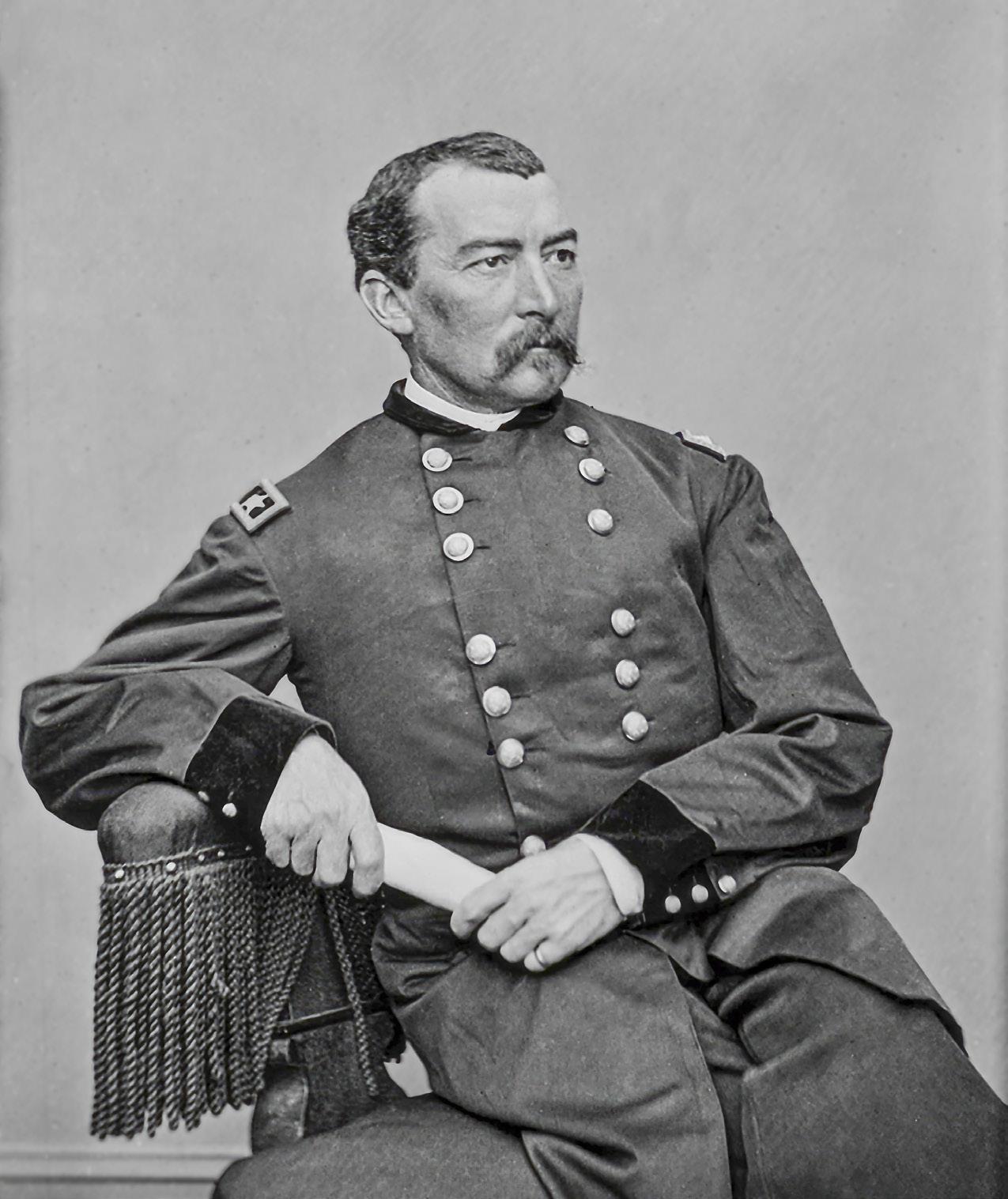
Grant traveled to Charles Town on September 17 to meet with Sheridan and put the finishing touches on the campaign to defeat Early, who was then ensconced at Winchester. In the meantime, Sheridan had a spy in Winchester who provided important information about a weakened Confederate garrison.
The contact in Winchester was Rebecca Wright, a young Quaker schoolteacher who was a Union supporter and operated a private school. Sheridan sent her a note on September 15, the day before he met with Grant, and received her answer with important details on September 17.
Sheridan had also learned that a Negro farmer from nearby Millwood named Thomas Laws had a pass from General Early that allowed him to sell produce three days a week in Winchester. He asked General Crook, who had spent time in Winchester earlier in the war, if he knew of anyone who might be able to provide information. General Crook remembered Miss Wright as a Union sympathizer and said she might be able to help.
The Negro farmer carried a note wrapped in tinfoil in his mouth to Miss Wright. After careful consideration of the
punishment should she and Laws be caught, she decided to tell Sheridan that she had heard that 4,000 men and 12 guns had been ordered back to the Confederate front at Petersburg. Laws carried the note to Sheridan the same way he had brought it. Sheridan attacked the next day, beginning a series of victories that chased the Confederates all the way to Staunton, and put the Shenandoah under Union control.
Miss Wright later said Sheridan came to her door in Winchester to thank her and the following year sent her a watch and chain to commemorate her “courageous and patriotic action.” While he was in Winchester, Miss Wright said Sheridan wrote his battle report sitting at her desk.
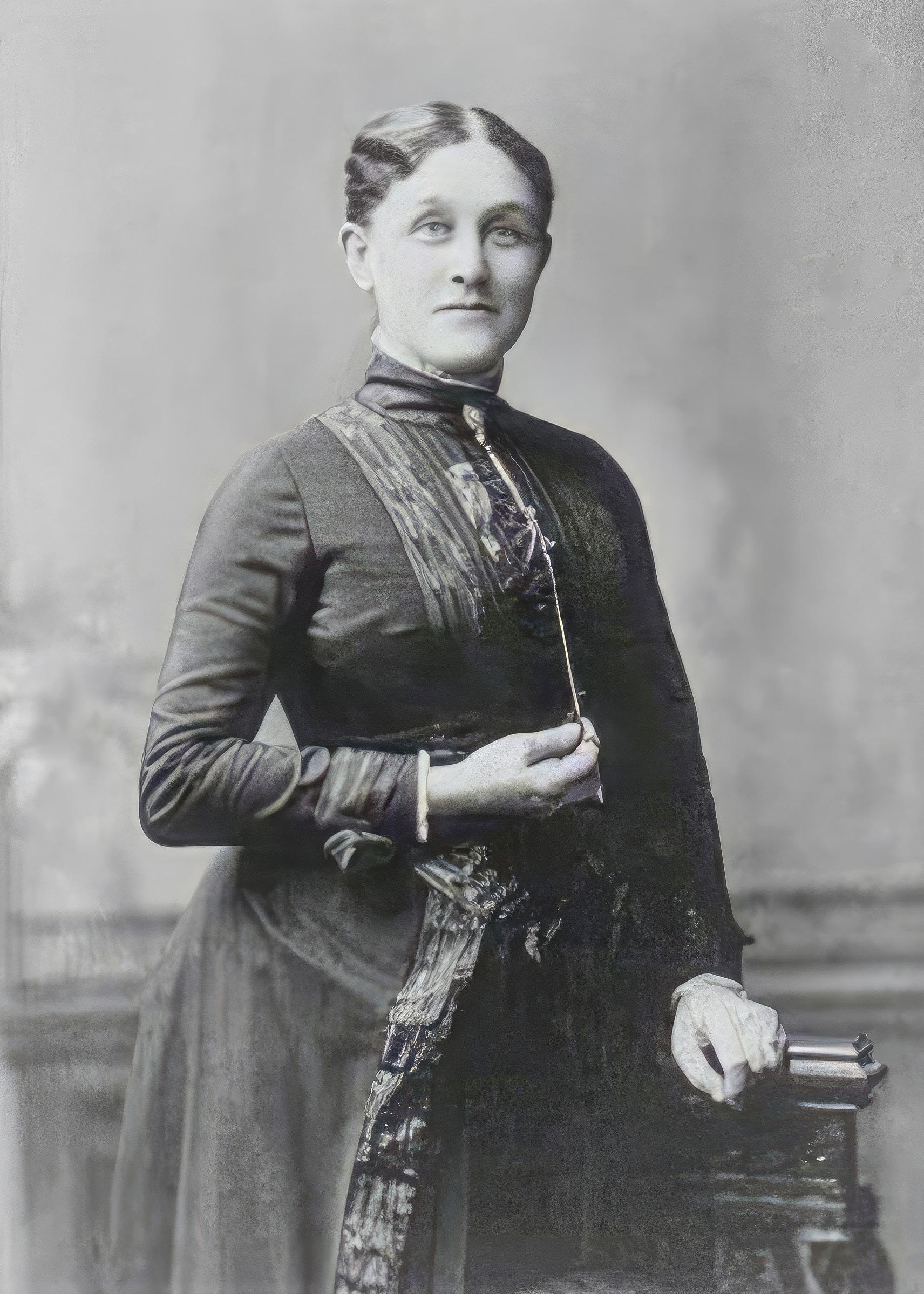
After the war, Sheridan helped Miss Wright get a job with the United States Treasury Department after Grant was elected president in 1868. She subsequently married William Carpenter Bonsal and they had a son who died at a young age. She died in 1914 and is buried in Glenwood Cemetery in Washington, D.C.
In April 1863, Lucy Allen’s “intended,” Sergeant Kennedy Grogan, a member of Lige White’s Thirty Fifth Battalion, Virginia Cavalry, was mortally wounded at Greenland Gap near Moorefield, West Virginia. He attended the University of Virginia before the war and is buried in Berryville.
Kennedy's brother, Charles Edward Grogan, was a lieutenant in Company D of Mosby’s FortyThird Battalion. He had been with Major General Isaac Trimble's staff at Gettysburg, was twice wounded on July 3, captured, and then escaped. He later joined Mosby. He apparently was not on the wagon train raid but was involved in most other Mosby raids before being wounded again in Fauquier County in December 1864.
During May 1863, Lucy Allen wrote in her diary about the mortal wounding of her brother’s son, Algernon Sydney Allen, Jr., and Stonewall Jackson at Chancellorsville. Jackson was a favorite at Clifton, having operated in the area in both 1861 and 1862. Algernon was a second lieutenant in Company F, Twelfth Virginia Infantry.
Lucy, who never married, commented in her diary that Union soldiers often arrived at mealtime expecting to be fed. They usually were accommodated, and one group even offered to pay for their supper. She lamented the fact that many servants had left, leaving the family members to fend for themselves.
She wrote of having been awakened one morning by Union soldiers who were in the house searching for Confederate soldiers, saying they would burn the house if they found any. It turned out to be a false alarm but the soldiers left with two young men who were soon released. Perhaps one of the more interesting incidents involved Lucy’s sister-in-law, Jane Tidbal Allen, who woke up one morning in May 1863 to find her servants, and some of her clothing gone. Jane and her mother-in-law, Sarah Griffin Taylor Allen, decided to travel to Winchester to retrieve her belongings.
There, they asked the Provost Marshall for permission to search for the items but were turned down. Undaunted, they asked to see Major General Robert Milroy, the garrison commander, and ask his help. Surprisingly, after some controversy, Milroy gave her a pass and a guard to look for her belongings. They found the culprits, recovered most of the missing items, and returned to Clifton. The following month, Milroy was chased from Winchester by Confederates under Lieutenant General Richard Ewell on his way to Gettysburg.
Clifton was a stop on the Spring 2023 Both Sides Tour, a semiannual day-long trip to Civil War sites within reach of Northern Virginia. The tours are conducted by Carl Sell, an occasional contributor to the Civil War News, and fellow historians Ben Trittipoe and Don Hakenson. Trittipoe and Hakenson provide the factchecking for Sell’s articles. Genealogist Karen Conair helped keep the family lineage straight. Photography by Bill Kamenjar. Contact Carl Sell at sellcarl@aol. com or 703-971-4716.
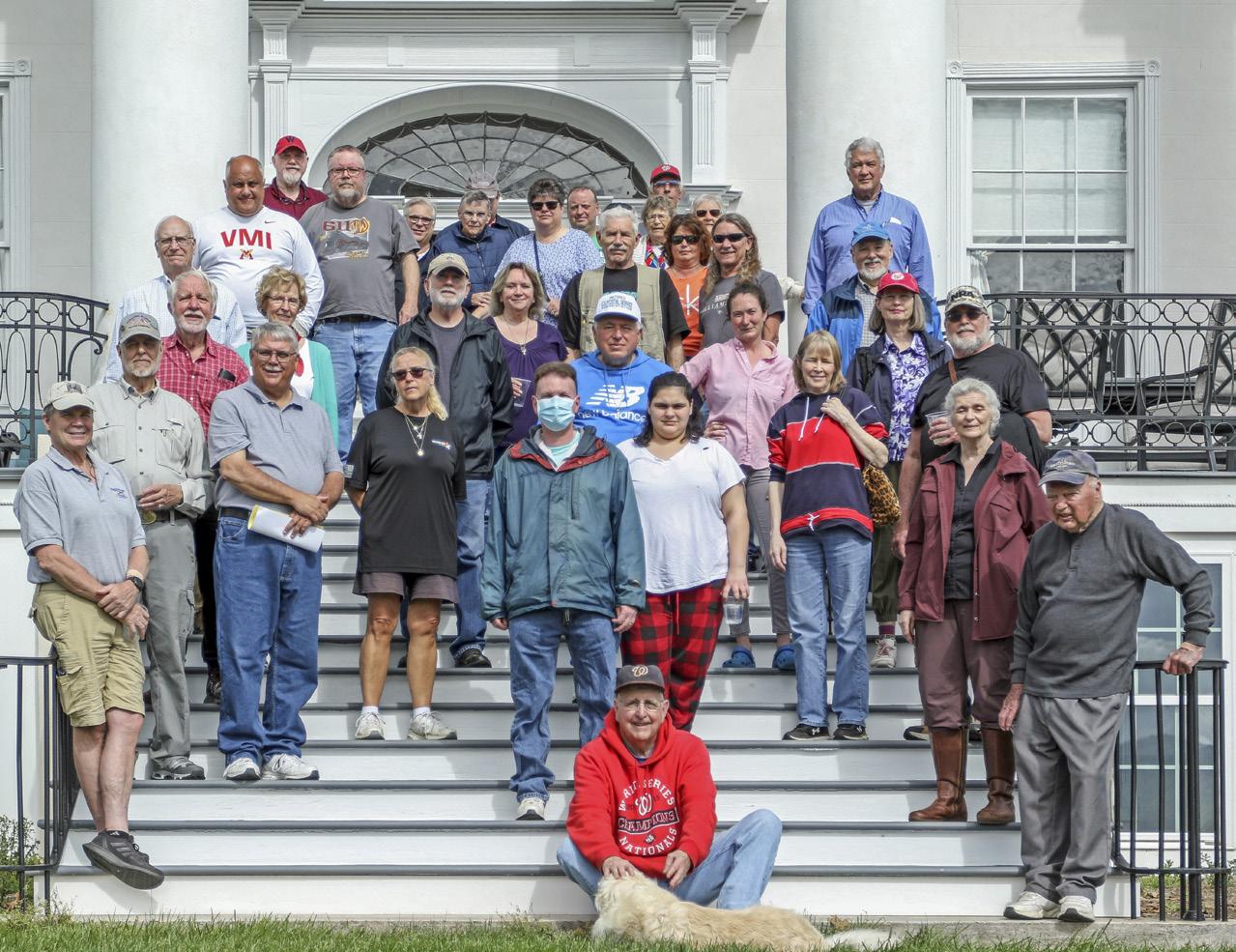
7
2023 7 October 2023 CivilWarNews.com CivilWarNews.com
October
General Philip Henry Sheridan. (Library of Congress)
Tour group at Clifton.
Rebecca Wright.
A Union General Turned Hangman
By Joseph F. Wilson
Despite the Civil War being over nearly ten years, the retired general rose early and put on his perfectly pressed dress uniform adorned with a flashy saber dangling by his side. Bedecked in his impressive military garb, the former soldier marched to meet the enemy at the courthouse in Mauch Chunk, Penn.
General Albright enlisted in the 132nd Pennsylvania Volunteers as a major at the outset of the war. Being an aggressive leader, he rose through the ranks. At Antietam, he displayed enormous courage while charging the Bloody Lane after his colonel went down. When the 9 month regiment disbanded, he formed the 34th Emergency Regiment during the Gettysburg campaign. In September, the regiment dissolved leaving Albright a citizen once again.
Now a practicing lawyer, the impeccably attired General Charles Albright wouldn’t be leading a charge on the battlefield but sought to reclaim lost glory when he vehemently implored a jury to hang four Irish Catholic miners accused of murder. The masquerading general effectively put the rope around their necks and had more to do with the hangings then anyone.
In 1876, the general led the prosecution in the trial of miners who dared to challenge the low pay and horrific working conditions in the mines. The immigrants didn’t stand a chance in a skewed trial featuring more prejudice than justice. Tangible
evidence proved to be scant in the trial according to modern day lawyers who have reviewed the sensational trial.
In the same spirited way he once led troops in battle, the flamboyant general assumed control by parading around the courtroom in his flashy uniform assailing the jury members with fiery speeches that overshadowed the lack of evidence. Albright’s commanding voice boomed like a cannon demanding they find the defendants guilty as charged.
General Albright left the army a hero after the war and returned to Mauch Chunk, later renamed Jim Thorpe, to resume his law practice. The record shows Albright was a good soldier when facing Robert E. Lee’s celebrated Army of Northern Virginia. In the Mauch Chunk trial, victory was a sure thing against the Irish miners who only wanted a fair shot in pursuing the American dream.
Albright made sure that the so-called Molly Maguires went to the gallows. Whether the radical Ireland based Molly Maguires ever came to America and reorganized in the anthracite coal region in Pa. is debatable.
The original Molly Maguires battled the English in Ireland in the 1800’s over land ownership.
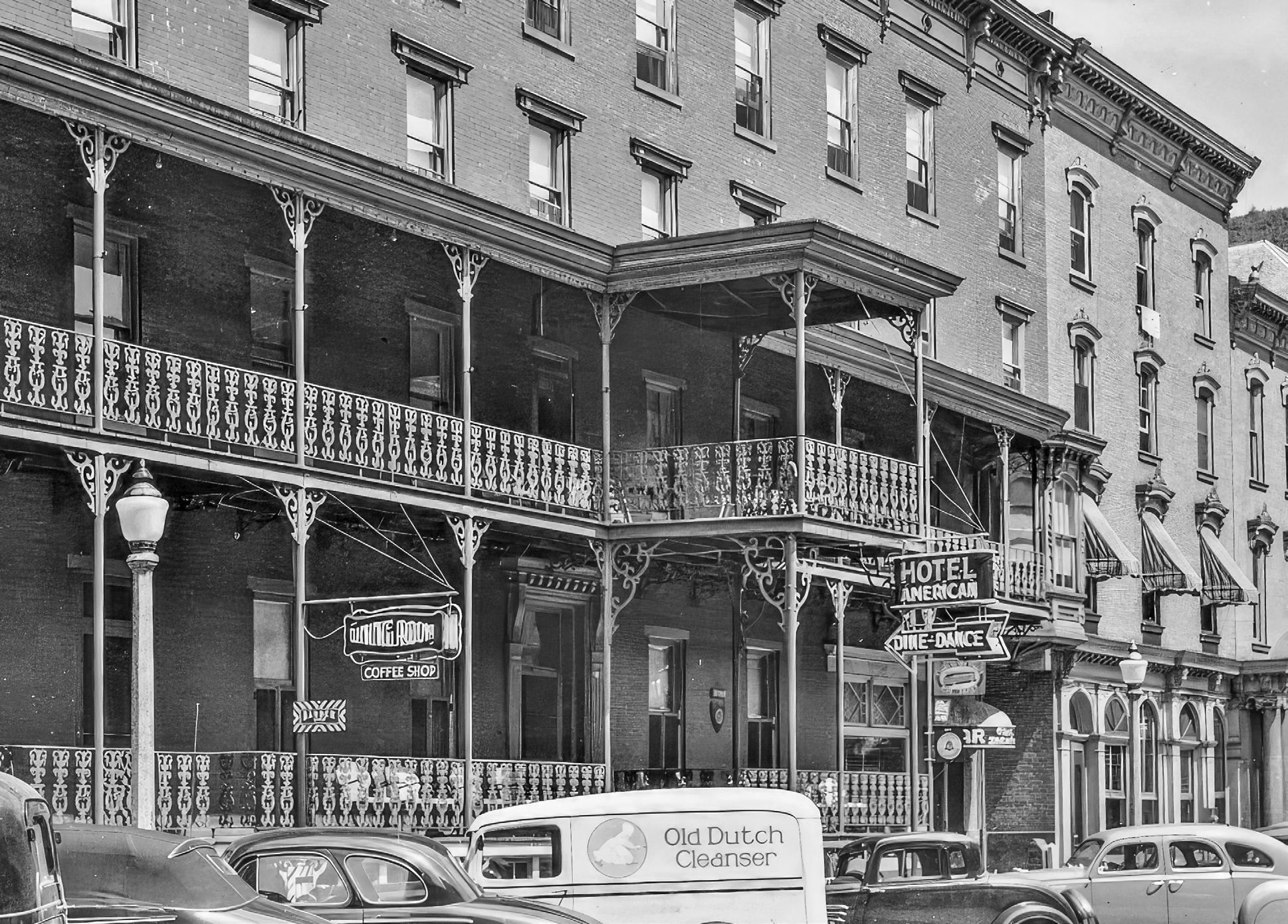
Miners in Pennsylvania only sought freedom from the appalling exploitation.
Nearly all the jurors were Germans whose understanding of English was limited at best. Not a single Irish Catholic sat on the jury. Opponents of the hangings believe the Germans associated
Albright’s splendid blue uniform with supreme authority and sided with the animated general whose intimidating antics dominated the courtroom. With a show trial that lasted over 4 months, the convictions were never in doubt in a court so lopsided that many today still deplore the lack of justice suffered by the Irish miners.
Historians and law scholars agree such a biased trial could never happen today by pointing out that the miners were arrested by mine owner Franklin Gowen’s “private” Coal and Iron Police. All the supposed evidence was supplied by Allen Pinkerton’s “private” detective agency hired by Gowen to spy on the miners. The trial itself was deemed a “private” community matter. Even the State of Pennsylvania took a hands-off approach, allowing the one-sided trial to play out. Only the hangman came courtesy of the state. In an astonishing disregard for law and fairness, the court allowed mine owner Gowen to join the prosecution team.
After returning to Mauch Chunk in the fall of 1863, Albright appealed to Penn.

Governor Andrew Curtin and President Lincoln for troops to quell growing unrest in the coal region. Irish miners who felt abused began to fight back against the mine owners and railroad executives. Citizen Albright was also part owner of a mine and sole owner of a foundry making shells for the army in Mauch Chunk.
Lincoln sent the 10th New
Jersey to the coal region to intimidate the miners. As a result, the miners faced both the federal troops and the Coal and Iron Police. All the wealthy executives in the coal industry welcomed the military serving alongside of Gowen’s private police in a show of force against the miners. All the coal fields in northeast Pennsylvania took on the appearance of a combat zone. Any complaints from miners over fair wages or conditions in the mines never gained any sympathy from Curtin or Lincoln.
Coal mine owners such as Gowen raked in huge profits while the miners could barely feed their families. What little wages the miners earned went straight back to mine owners as all clothing, food, and supplies had to be purchased from the company store at inflated prices. Rent for company housing also exceeded market value. Many miners had little or nothing left after settling their accounts. While the Emancipation
Proclamation played out in the Civil War, slavery was alive and well in the anthracite coal mines. The owners created a ticking time bomb that exploded into a violent labor dispute.
The Civil War depended on coal from the region. Any disruption of the flow of coal had dire consequences for the war effort. The miners knew it and so did Lincoln. Coal fired the foundries that made weapons and fueled the
steam engines of the trains that grew in importance as the war progressed. More importantly for wealthy mine owners and railroad tycoons, profits began dwindling. Sabotage of the mines and railroads played out in what might be the first major labor dispute in America.
The miners certainly engaged in violence. Violence permeated northeast Pennsylvania through the 1860’s and the 1870’s. The chaos also came from mine owner Franklin Gowen, who hired Welsh and English thugs who hated the Irish to form his private Coal and Iron Police. The corrupt police force participated in violence of their own against the miners. Pinkerton’s planted spies also engaged and encouraged violence by miners just to snare their prey.
Supporters of the miners believe the miners used the only means available against the mine owners for their mistreatment and atrocious working conditions. Detractors say the executed miners got what they deserved. Count General Albright among the latter.
It’s believed that Albright’s hatred for the miner’s stemmed from their earlier opposition to the war. A rich man’s war and a poor man’s fight echoed in the mines. Being a staunch supporter of the war, Albright had little sympathy for miners opposing the war. Considered Mauch Chunk’s recruiting officer, he often gave
8 CivilWarNews.com October 2023 8 October 2023 CivilWarNews.com
General Charles Albright.
American Hotel, Mauch Chunk.
fiery patriotic speeches from the balcony of the American Hotel, known today as The Inn at Jim Thorpe. Being a friend and associate of mine owner Franklin Gowen, the general conveniently overlooked Gowen quietly paying $300 for a substitute to take his place on the battlefield. During the fall of 1864, Albright reenlisted as Colonel of the 202nd Penn. Regiment. In March, Lincoln brevetted Albright as general for his fine leadership. When Robert E. Lee
surrendered on April 9, 1865, most of the boys in the 202nd regiment had time left to serve.
Once again, Albright took his regiment to the coal regions to put the miners under the bayonets of the Federal Army.
A total of 50 miners were arrested as a result of Allen Pinkerton’s spies infiltrating the miners. Many went to prison for supposed violence. Twenty coal miners went to the gallows.
Albright had a hand in many trials in Carbon County, but his shining
moment of reclaimed stardom came in Mauch Chunk when all four miners went to the gallows. Elated mine owners and railroad executives hailed the victorious general as a conquering hero. A decadent Albright basked in his celebrity not felt since the old war days.
In a master stroke seeking maxim publicity, all four miners were hung at Mauch Chunk at the same time in a carnival atmosphere that had newspaper men and curiosity seekers packed into the old city jail. With one pull
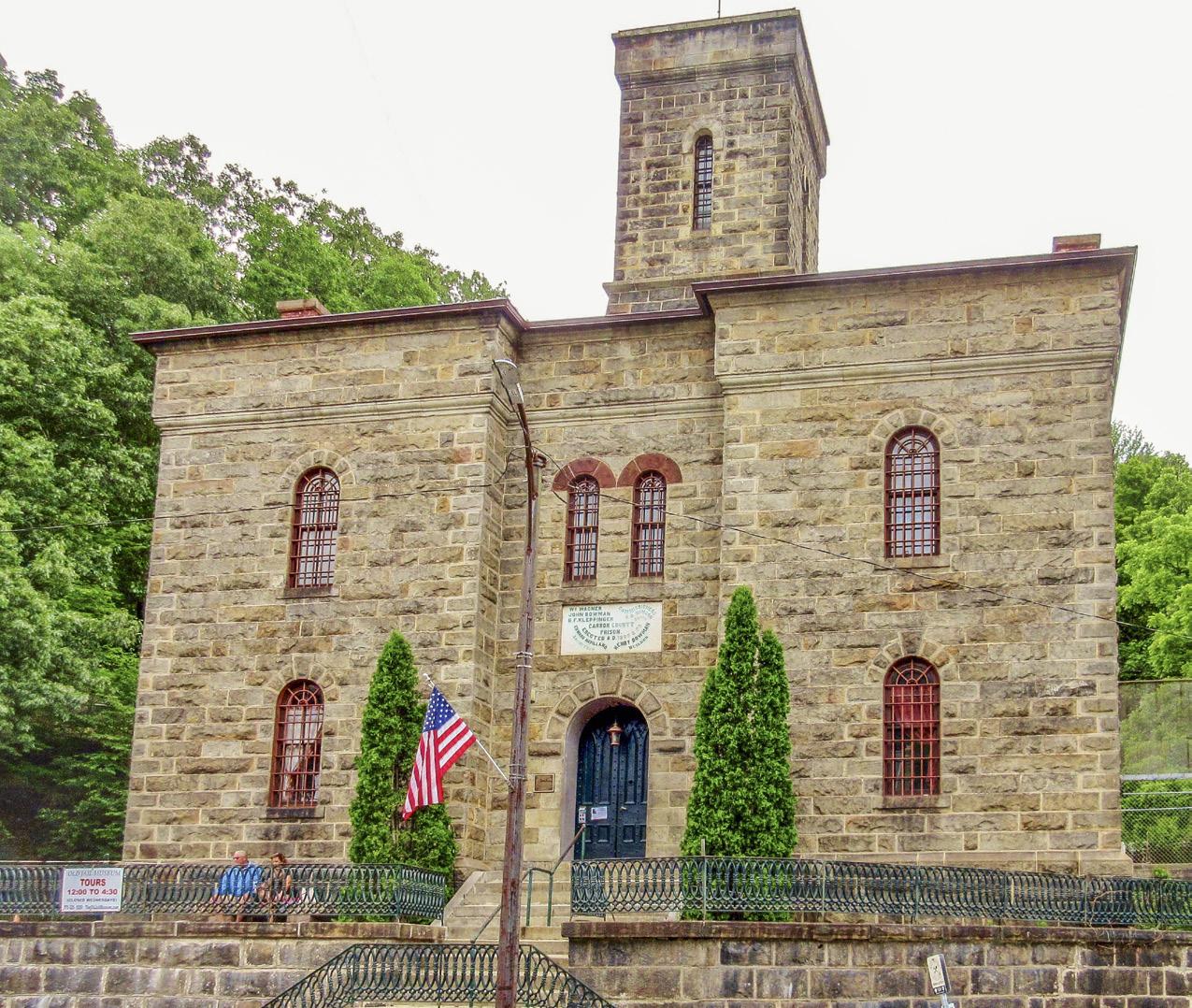
of the rope the platform holding the miners dropped, sending them into eternity. Immigrant coal miners across the country took notice. A shot across the bow gave warning. If you disrupt a wealthy tycoon’s operation, you may find a noose around your neck.
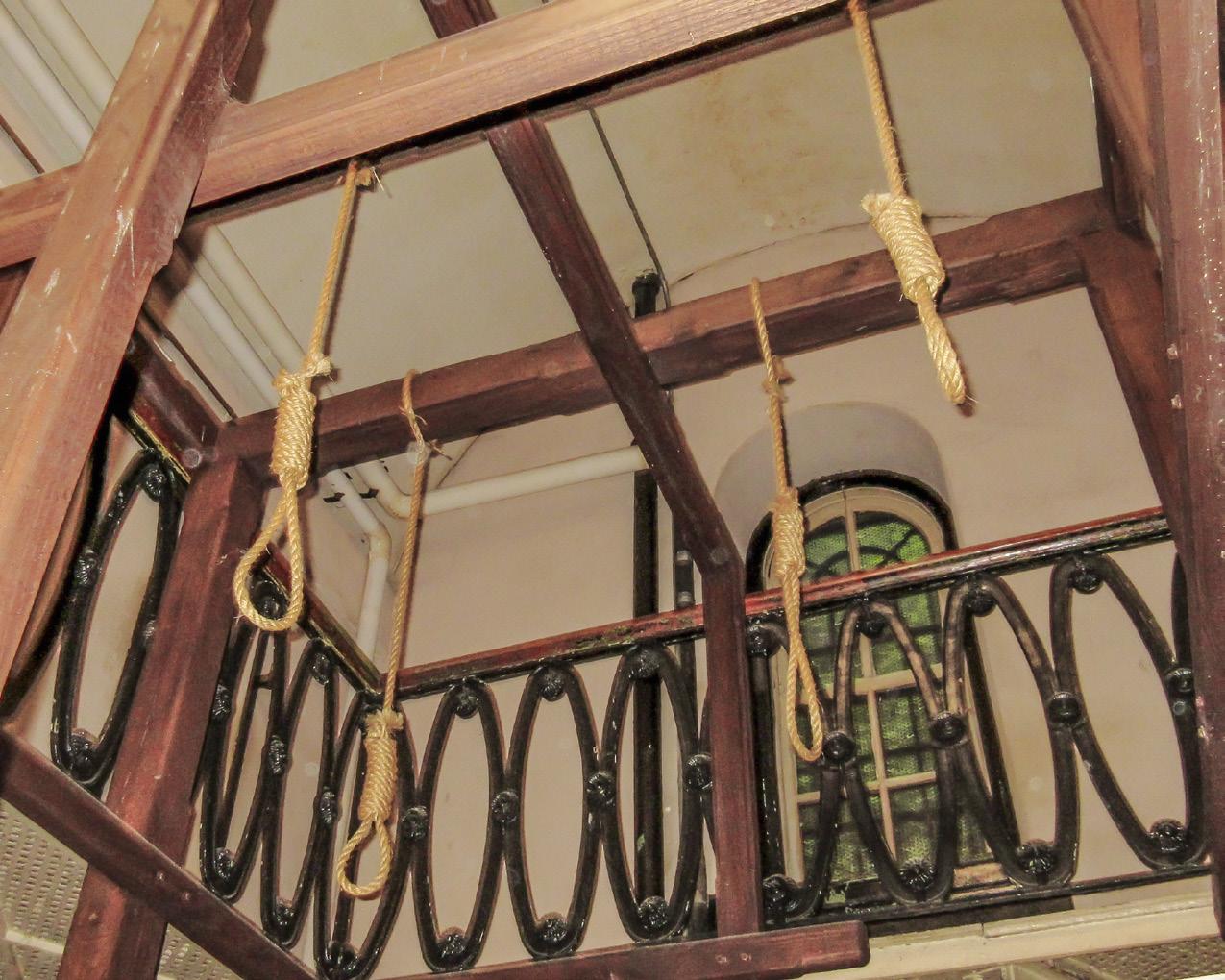
The egotistical general besmirched his own good name by choosing his last battle to be against the poor Irish Catholic miners. It was an unfair battle that saw the interests of the powerful coal and railroad industries crush
the rebellious workers. The Irish came to America seeking work and a better life for their families. For too many, all they found was a hangman!
Joseph F. Wilson is a member of Old Baldy CWRT and The General Meade Society. The writer lectures on Civil War topics and is the writer and producer of the documentary “Civil War Prisons – An American Tragedy” available on Amazon. YouTube channel – “Joseph F. Wilson.” Email: Joef21@aol.com.
Current Event Listings

9 October 2023 9 October 2023 CivilWarNews.com CivilWarNews.com
Old City Jail, Jim Thorpe Gallows Inside Old City Jail.
see all of this year’s current events visit our website: CivilWarNews.com
To
Tin Cans
The canning of food to prevent spoilage was not a new technology during the Civil War, it dated back to the early days of the 19th century (at least in Europe). The first successful attempts were done with glass bottles somewhat like Mason jars by a pickle maker from Paris who supplied the French military during the Napoleonic Wars. Obviously, a shortcoming of glass jars is that they proved subject to breakage in transit. In New York as early as 1812 there was a factory that packed oysters, stewed meats, and vegetables in tin covered sheet iron cans. There was also a food canning operation in New Orleans about the same time. The iron cans were often heavier than the food they contained.
The first use of a cylindrical “tin cannister” was patented by an English merchant named Peter Durand in 1811. He sold the patent rights to a grocer; eventually their largest customer became the British War Department. Durant
later obtained an American patent for his ‘cannister’ in 1822. Some 19th century American canners are still in business today.
William Underwood opened his canning factory in Boston in 1819 packing fruit in glass containers. He switched to tin plated cans because of the rising cost of glass. One early hazard associated with canned foods was poisoning from the lead solder used to seal the seams. The lead toxins seeped
into the food. It took a while to figure out the seams should be soldered on the outside only. Underwood made a fortune supplying canned meat to the U.S. Government during the Civil War. The company later became known for Underwood’s deviled ham, a product still found on grocery store shelves today. Demand for canned goods accelerated with the outbreak of the Civil War; production went
from about five million cans in 1861 to almost thirty million by 1865. Some canned goods were purchased as rations by the US Quartermaster or sold as treats by sutlers; others found their way into camps and battlefields by some other manner. For example, the U.S. Government purchased large quantities of Borden’s condensed milk, but it was not part of the regular rations. Rather, it was listed on the official list of medical supplies. Surgeon General William Hammond noted that the product was still commonly found in camps and “was in extensive use in our armies and hospitals.”
Post-antebellum civilian acceptance of canned foods represented a paradigm shift from bulk selling of seasonal items to individualized product packaging that allowed goods to travel beyond traditional regional boundaries. The structure of modern food systems took shape during this time. Antebellum, a


States. It consisted of a sharp sickle which was pushed into the can and sawed around the edge. It was adopted by the Union army during the Civil War but the design was considered “too dangerous for home use.” In 1866 J. Osterhoudt patented a key type opener which was inserted into a tab on the side of the can to roll up a thin strip just below the lid. The key type can opener design lasted well over a hundred years. Pressurized cans of tennis balls used to be opened using a similar device as late as the mid-1970s. The mid-19th century tin can itself was made differently and used of different materials than modern cans. The tin can was cut from a sheet of tin-plated iron and then rolled into a cylindrical shape. It was then soldered down the outside seam to retain its shape. A period tin can has smooth sides and a smooth flat bottom with a lipped or overlapping portion soldered to the body. One did not employ craftsmen like tinsmiths for this kind of work. Nineteenth century tin cans do not feature the corrugated ridges found on modern canned goods. Strengthening cans by employing ridges was not unknown during the mid-19th century. For example, there is a court case known as Brown vs Hall (1859) which concerned a patent covering use of bead reinforcement on the sides of paint cans. Whatever the case, presumably as cost saving measure, beads or ridges were not features on canned food issued to soldiers.
prudent civilian shopper would not trust milk that had traveled more than ten miles from the dairy farm, whether in a can or not and it is worth noting that Abraham Lincoln’s mother died from “milk poisoning.”
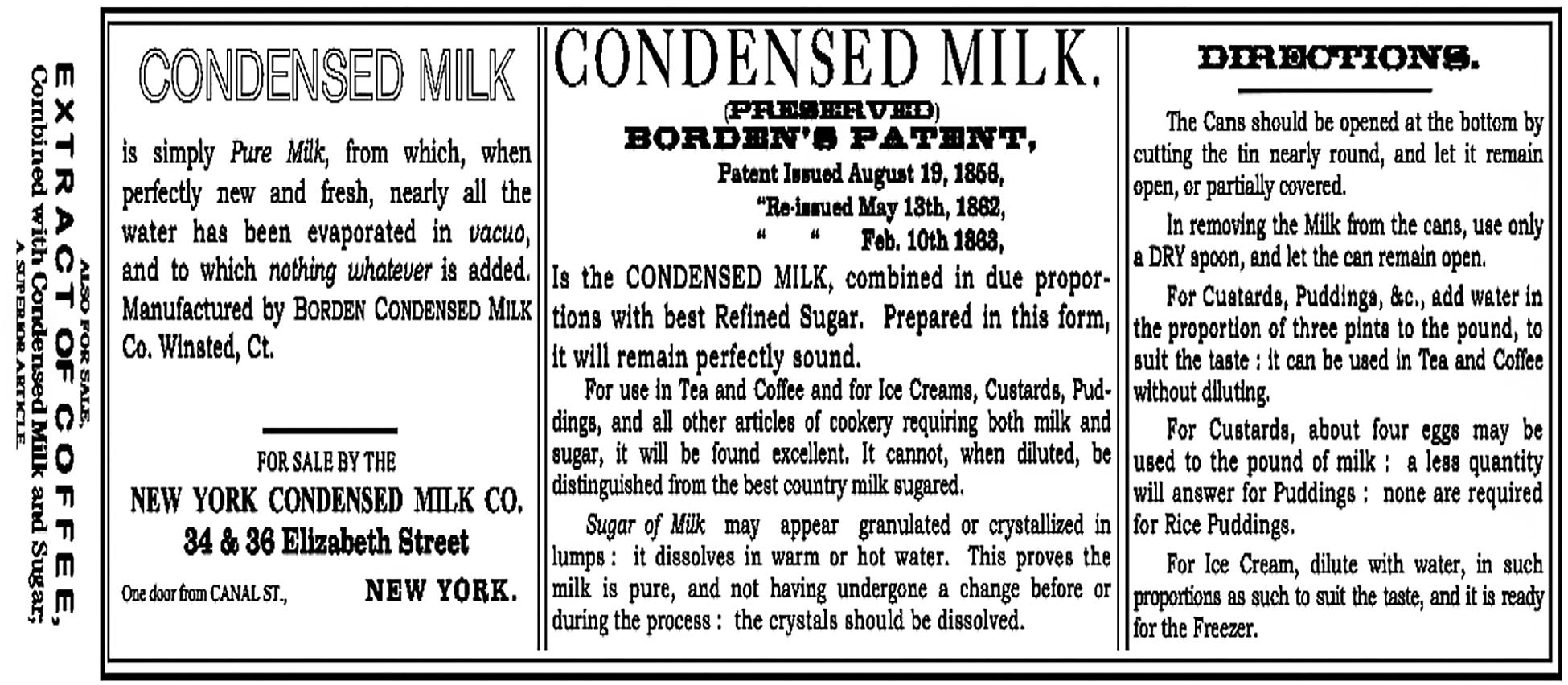
One thing that seems odd in retrospect is that almost fifty years elapsed from the advent of the first canned food to the first mass produced device used to access the contents. The prevailing wisdom was to employ whatever tools were at hand. For example, instructions on one brand of canned food stated “to open cut around the top with a hammer and chisel.” It is possible that early tin cans were thinner and the metal softer than modern steel cans and hence easier to open with the “tools on hand.” There are many surviving tin cans from the Civil War-era that give the appearance of having been opened with a pocket knife or bayonet.
Whatever the case, in 1858 Ezra Warner patented a lever type can opener in the United
Can labels have a history of their own. During the 1860s most labels were printed, lithographed, or hand stenciled from woodcuts. They were largely monochromatic using a single ink color on a single color background; very few had more than two colors. The label making was outsourced to specialized printers. The elaborate artwork and multi-color lithography was not a feature of tin can labels until well after the Civil War. It became a standard practice for the can to feature the company name as proof of authenticity as with Borden’s condensed milk can, at least for fulfilling Government contracts. Labels from the Civil War-era would not be found with “Trade Mark” anywhere on them since the National Trademark legislation was not passed until 1874.
Some well-known printed labels were produced by Prang & Meyer of Boston from 1856 to 1860 for the canner J.B. Hamblen & Company. Hamblen was famous for canned oysters, a popular item offered by sutlers in Civil War camps. Hamblen was
10 CivilWarNews.com October 2023 10 October 2023 CivilWarNews.com
Borden’s label.
Sutler’s headquarters near Petersburg, Va., 1865. (Library of Congress)
a pioneer in the oyster canning business going back at least to 1851, according to the Boston City directory.

After New Orleans fell to the Union, and the local canneries along with it, did Confederates have access to canned foods besides stoneware or glass jars from home? Certainly. A soldier in the 27th Arkansas Infantry died after eating improperly processed food from a tin can. A colonel in the Army of Northern Virginia recalled making gruel from cornmeal over a campfire in a tin can when rations got short, and further that the tin can as a cooking vessel had to be shared. There were also canned goods shipped to Confederate hospitals for the patients. A Confederate prisoner of war in Camp Douglas near Chicago mentioned receiving canned milk specifically. There were enough Southerners exposed to safe and
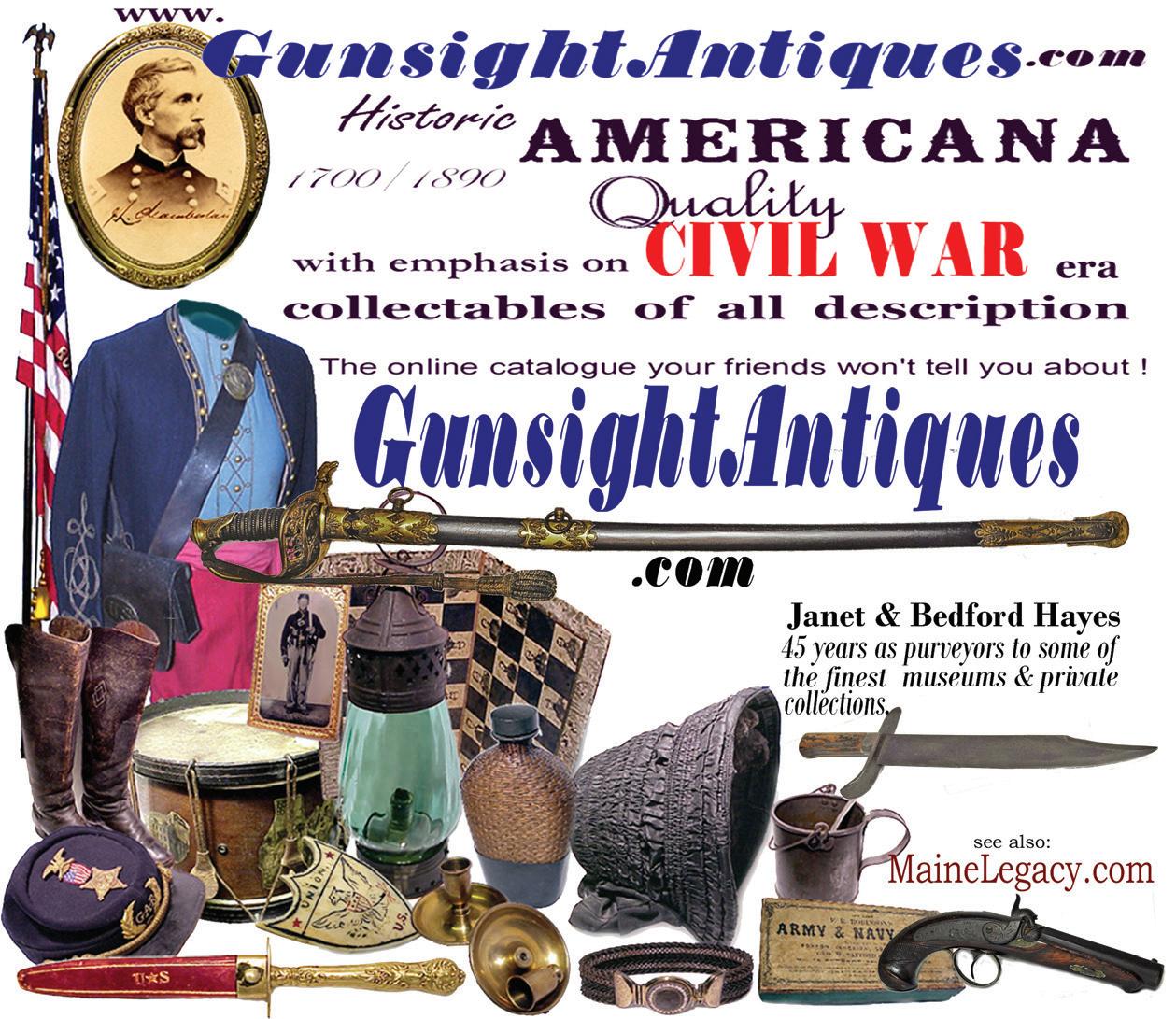

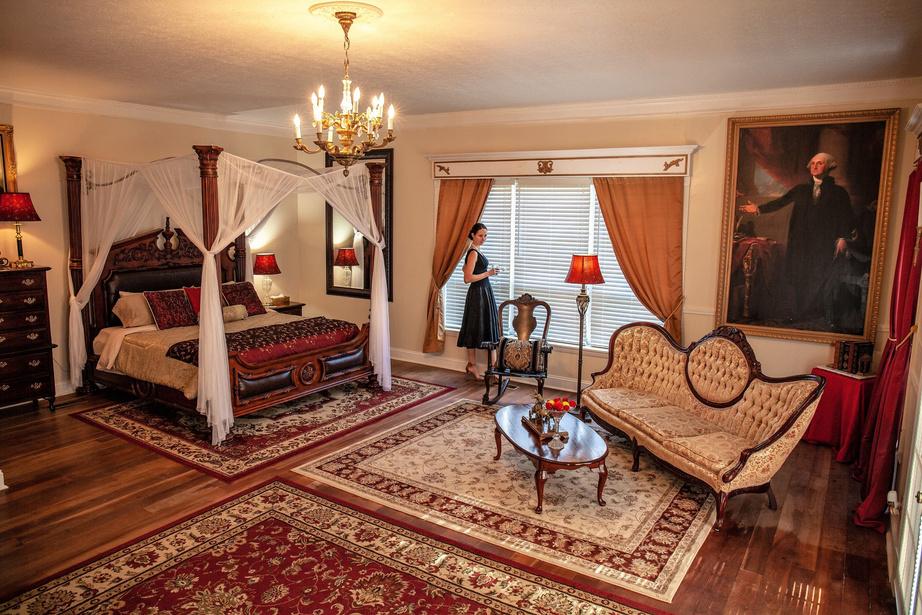
edible food in tin cans that postbellum the sales of canned food in the South skyrocketed.

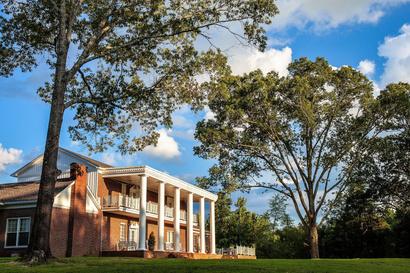
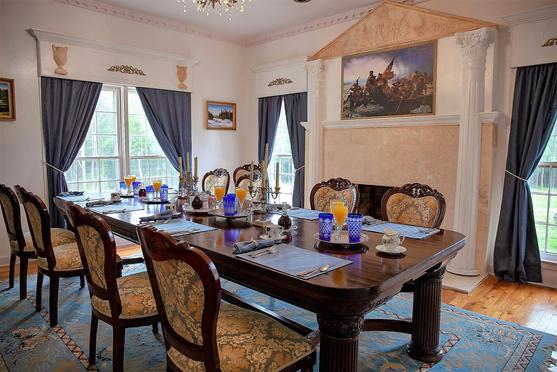
Craig L. Barry was born in Charlottesville, Va. He holds his BA and Masters degrees from UNC (Charlotte). Craig served The Watchdog Civil War Quarterly as Associate Editor and Editor from 2003–2017. The Watchdog published books and columns on 19th-century material and donated all funds from publications to battlefield preservation. He is the author of several books including The Civil War Musket: A Handbook for Historical Accuracy (2006, 2011), The Unfinished Fight: Essays on Confederate Material Culture Vol. I and II (2012, 2013). He has also published four books in the Suppliers to the Confederacy series on English Arms & Accoutrements, Quartermaster stores and other European imports.
E.J. Warner’s patent for the Can Opener, Jan. 5, 1858.
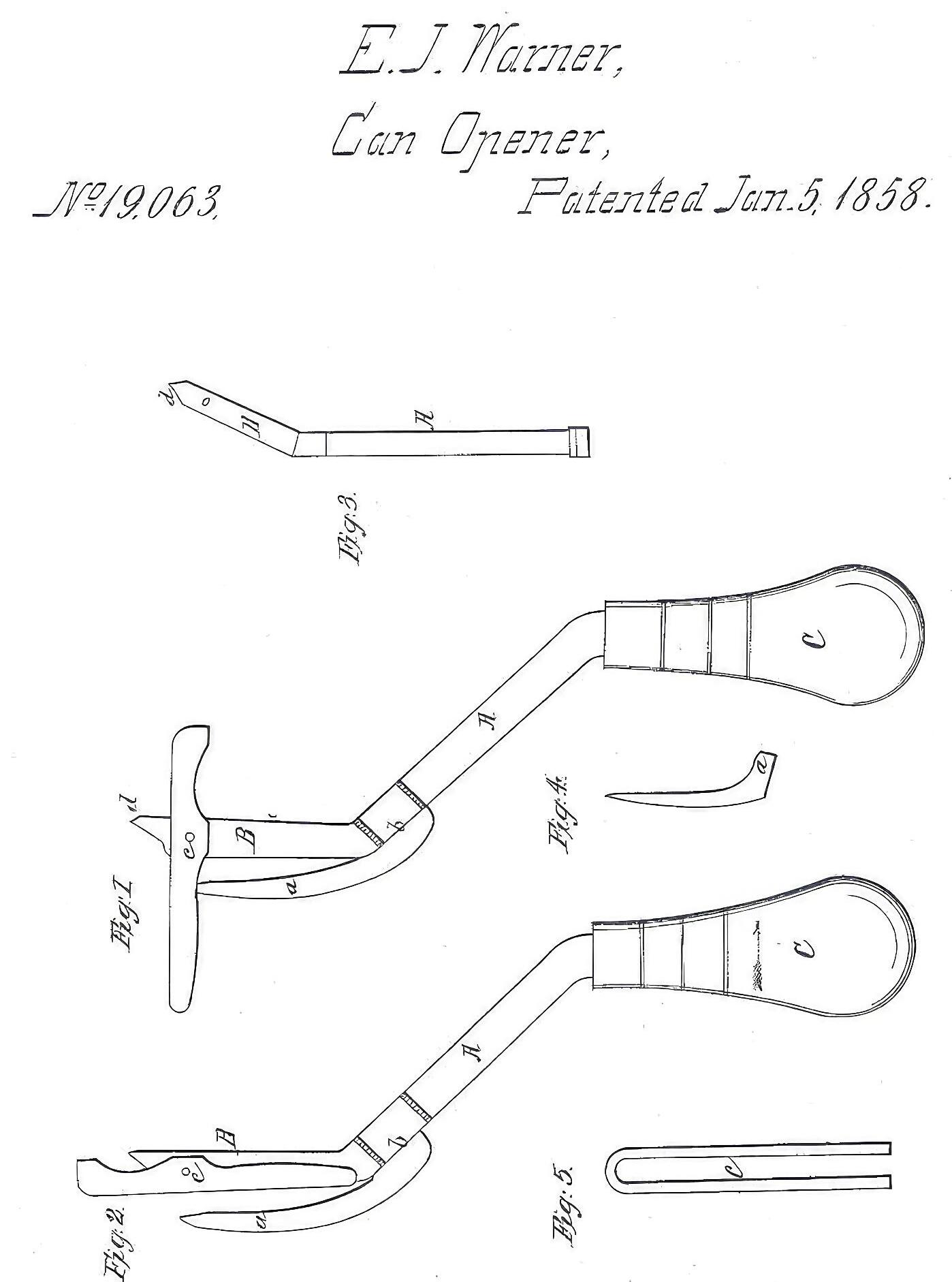
11
2023 11
CivilWarNews.com CivilWarNews.com
October
October 2023
– MAKER –LEATHER WORKS (845) 339-4916 or email sales@dellsleatherworks.com WWW. DELLSLEATHERWORKS.COM
Remembering Dean Thomas
Author, Historian, and Publisher
Dean S. Thomas, 74, passed away on July 15 at his home in Fairfield, after a courageous battle with cancer.
Known world-wide as the foremost authority on Civil War small arms ammunition, his interest in the Civil War and artifacts began with the centennial celebration in 1961 when he visited Gettysburg and found his first bullet.


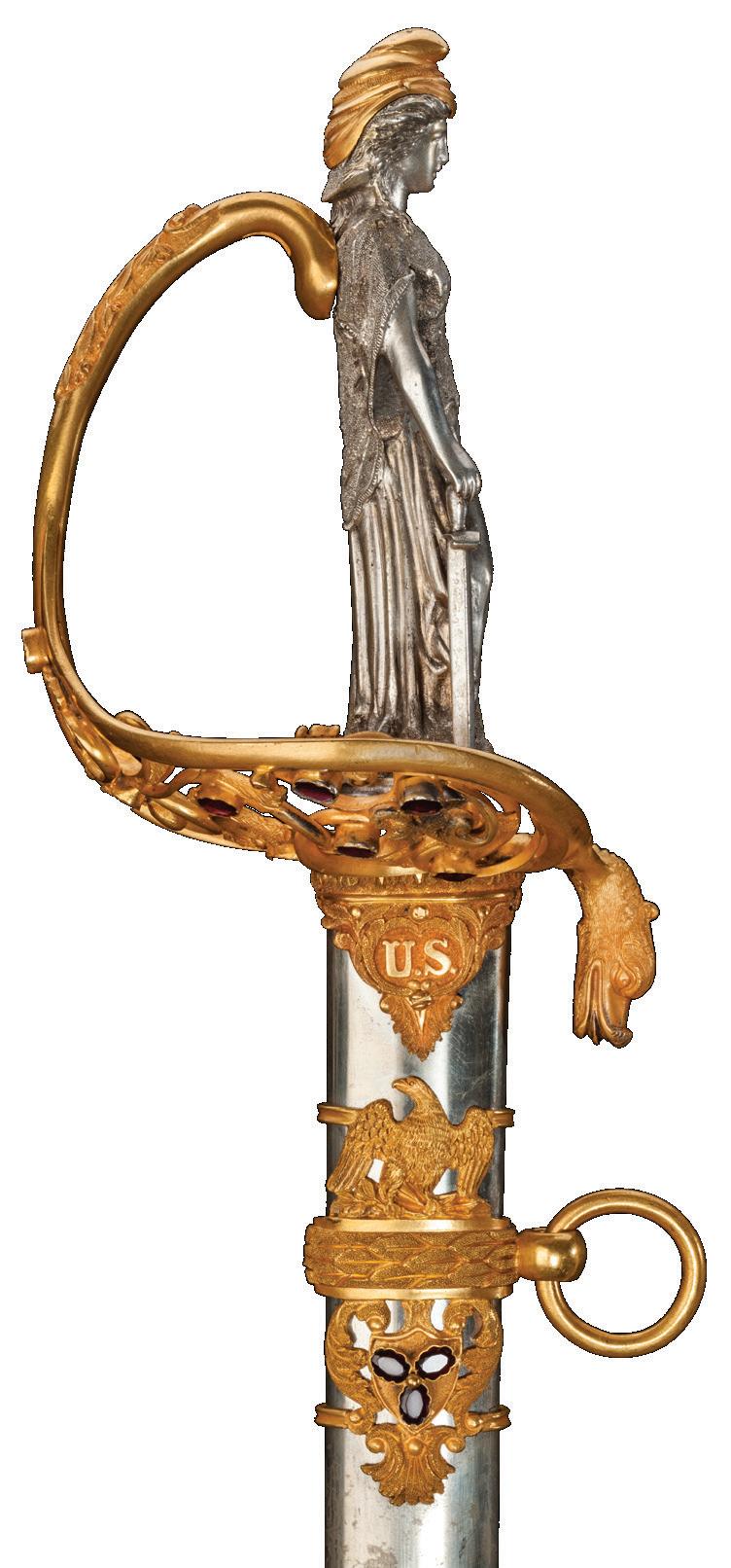
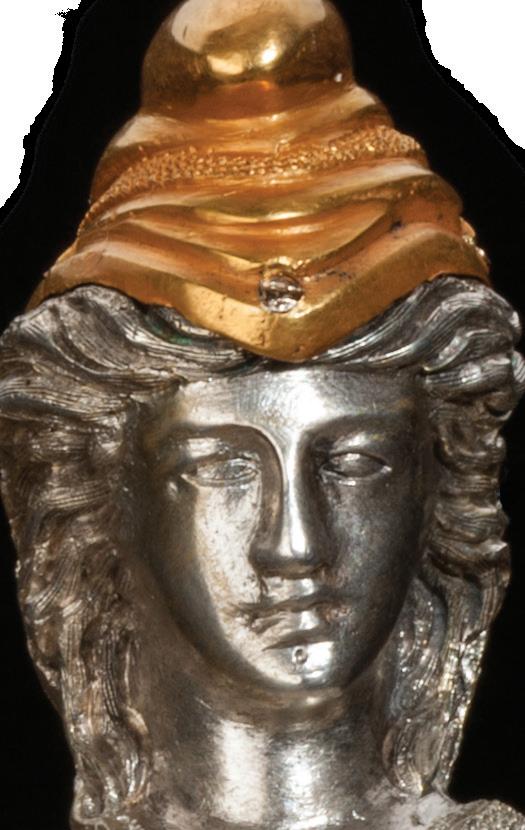

A 1966 graduate of Haddon Township High School in Westmont, New Jersey, Dean attended Gettysburg College, then graduated from Glassboro State College (now Rowan University) in 1972 with a B.A. in history. During this time, he spent five summers as a Licensed Battlefield Guide at the Gettysburg National Military Park. He founded Thomas Publications in 1981 when he wrote his first book, Ready, Aim, Fire!, followed by Cannons and Civil War Commanders His four-volume Round Ball to Rimfire was the result of his lifelong study of small arms ammunition and is regarded as the singular reference work on
the subject. During his career as a researcher and publisher, he wrote numerous other books, including A Handbook of Civil War Bullets and Cartridges, with his brother Jim.
Dean was a devoted public servant. For many years, he served as vice-president of the Gettysburg Battlefield Preservation Association, working to preserve the integrity of historically significant battlefield land. He was a member of the Fairfield Lions Club, serving as its president for two years, and served on the Fairfield Borough Council for the past 17 years, the borough planning commission, and was the vice president of the Hamiltonban-Fairfield Joint Parks and Recreation Commission, and worked toward the development of the park.
Dean was also instrumental in the placement of the Civil War Trails marker in Fairfield. He served on the Fairfield Civil War Sesquicentennial Committee, and later was vice president of the Fairfield Area Historical Society for multiple terms. He co-wrote the book Fairfield in the Civil
Gun Works, Inc.
War, and recently completed the Liberty Township Historic Homes Survey. He served on the Fairfield Pippinfest committee, and often volunteered at Strawberry Hill Nature Center.
Dean is survived by his wife of 25 years, Sally; his children, Lauren Fulton (Josh) of Mt. Joy, and John Thomas (Tabetha) of Biglerville; stepchildren. Heather Jenkins (Jeff) of Fairfield, Anne Gageby (Shawn) of Fairfield, and Tom Rodgers (Nora) of Fairfield; and eight much-loved grandchildren, William, Matthew, Robert, Nick, Emma, Yue, Helena, and Marlow. He is also survived by his brother, Jim Thomas (Ellen) of Arendtsville, who worked with him and has been his sidekick in his relic hunting and collecting adventures; brothers-inlaw, Steve Sites (Linda), and Matt Sites (Lisa); sister-in-law Sherry Brough (Ken); and nieces and nephews, Jimmy, Sarah, Zach, and Kate, Logan, Jennifer, Erin, Paul, and Cameron; and mother-in-law, Jackie Sites. He was predeceased by his parents, Frank G., and Grace M. Thomas, in 1988; and his sister, Linda McGonigle.
The tried-and-trusted choice of today’s blackpowder enthusiasts.

Thousands of blackpowder hobbyists and aficionados, from history buffs and re-enactors to modern hunters and competitive shooters, trust Dixie Gun Works for its expertise in all things blackpowder: guns, supplies, and accessories and parts for both reproductions and antique guns. Whether you’re just getting started or you’re a life-long devotee, everything you need is right here in the 2023 DIXIE GUN WORkS’ catalog.

12 CivilWarNews.com October 2023 12 October 2023 CivilWarNews.com The Artilleryman is a quarterly magazine founded in 1979 for enthusiasts who collect and shoot cannon and mortars primarily from the Revolutionary War, Civil War to World War II. The Artilleryman Magazine 2800 Scenic Dr, Suite 4 PMB 304 Blue Ridge, GA 30513 • 800-777-1862 • mail@artillerymanmagazine.com www.ArtillerymanMagazine.com FOUR INCREDIBLE ISSUES A YEAR DIXIE GUN WORKS, INC. 1412 W. Reelfoot Avenue PO Box 130 Union City, TN 38281 INFO PHONE: (731) 885-0700 FAX: (731) 885-0440 EMAIL: info@dixiegunworks.com VIEW ITEMS AND ORDER ONLINE! www.dixiegunworks.com Major credit cards accepted FOR ORDERS ONLY (800) 238-6785 PROFESSIONAL SERVICE AND EXPERTISE GUARANTEED ORDER TODAY! STILL ONLY $5.00!
Buying and Selling The Finest in Americana 11311 S. Indian River Dr. • Fort Pierce, Florida 34982 770-329-4985 • gwjuno@aol.com George Weller Juno
Fort Boreman: Defender Of Parkersburg, West Virginia
By Charles H. Bogart Parkersburg,
West Virginia, is located at the junction of the Kanawha River with the Ohio River. In 1861, West Virginia seceded from Virginia to form a loyal Union state. On June 20, 1863, West Virginia was admitted into the Union as the 35th state. During July and August 1863, the 11th West Virginia Infantry, under the command of Colonel Daniel Forst, built a fortification on a hill just west of the junction of the two rivers. This site dominated the area around the city of Parkersburg. The 11th West Virginia named this fortification Fort Boreman in honor of West Virginia’s first governor, Arthur Boreman. The purpose of Fort Boreman was to defend the city of Parkersburg from a Confederate attack.
General John Hunt Morgan and his Confederate raiders had recently struck into the heart of Ohio, and other Confederate irregular forces were attacking Federal positions at various points within West Virginia.
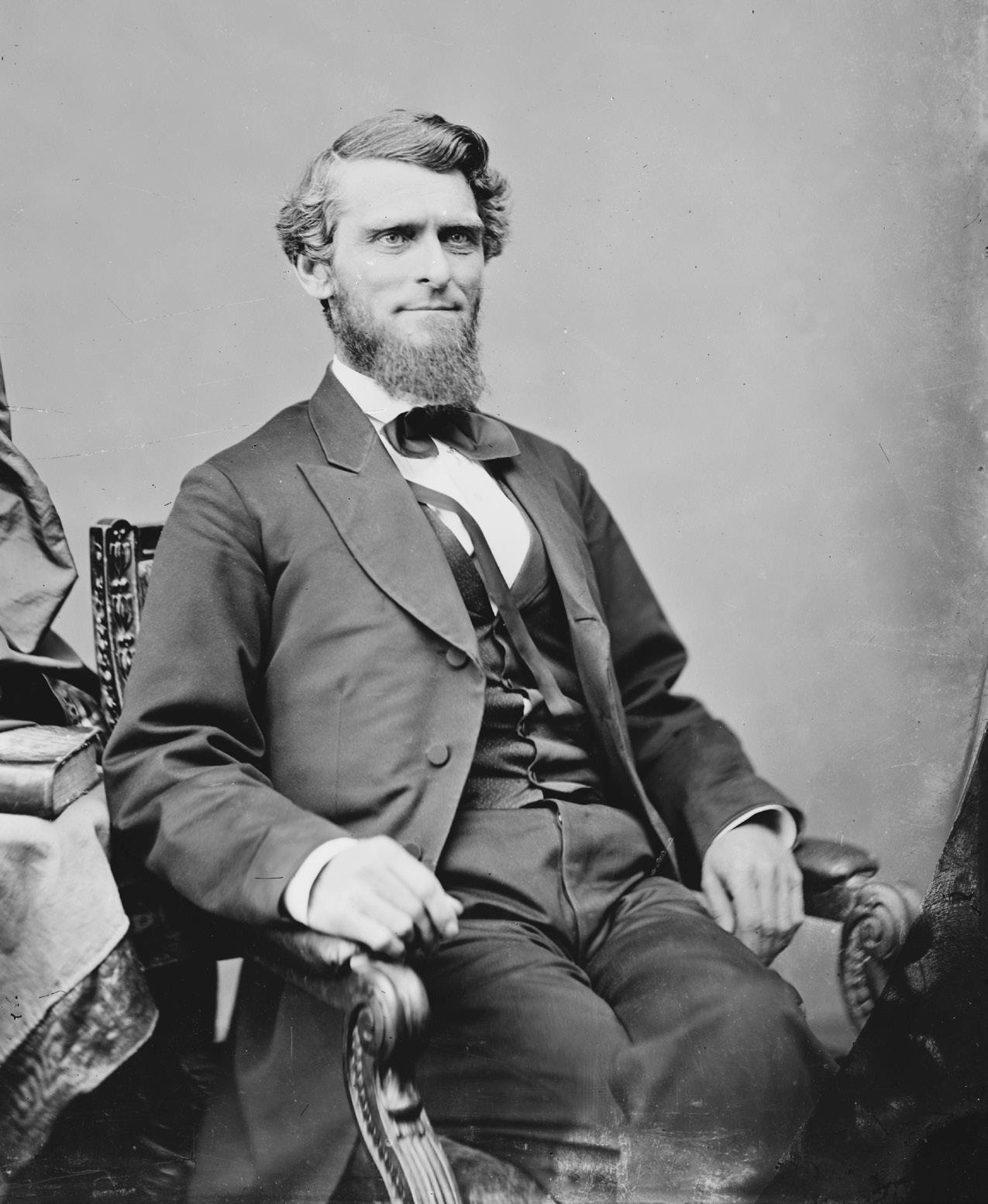
In 1863, Parkersburg was the southern terminus of the Baltimore & Ohio Railroad, a major supply artery for the Union Army. From Parkersburg, packet boats transported men and supplies up the Kanawha River or down the Ohio River. Within Parkersburg, the Union Army had numerous warehouses and commissary facilities. The city was also home to five hospitals and served as a recruiting camp. During the Civil War, a number of Union units garrisoned Fort Boreman. At the end of the war in 1865, Fort Boreman was
abandoned, and nature reclaimed the landscape.
In 1898, Parkersburg’s Andrew Mather GAR Post 14, purchased a Civil War-era 4.5-inch cast iron cannon to fire on the 4th of July. The gun had been ordered by the U.S. Army in March 1863 from the Fort Pitt Foundry. It was No. 70 of 113 Model 1861 Ordnance 4.5-inch rifled siege guns produced by the Fort Pitt Foundry, and it was the 1,413 gun produced at Fort Pitt. It is proof marked C.P.K. for the inspector Charles P. Kingsbury. The cannon was fired annually from the site of Fort Boreman by the GAR until 1920 when declining membership and age led to the discontinuation of celebrating the 4th of July by firing the cannon. In 1921, the local Parkersburg Kiwanis Club purchased the cannon, saving it from being sold for melting down. They moved it to the city park and mounted it on a concrete pedestal.
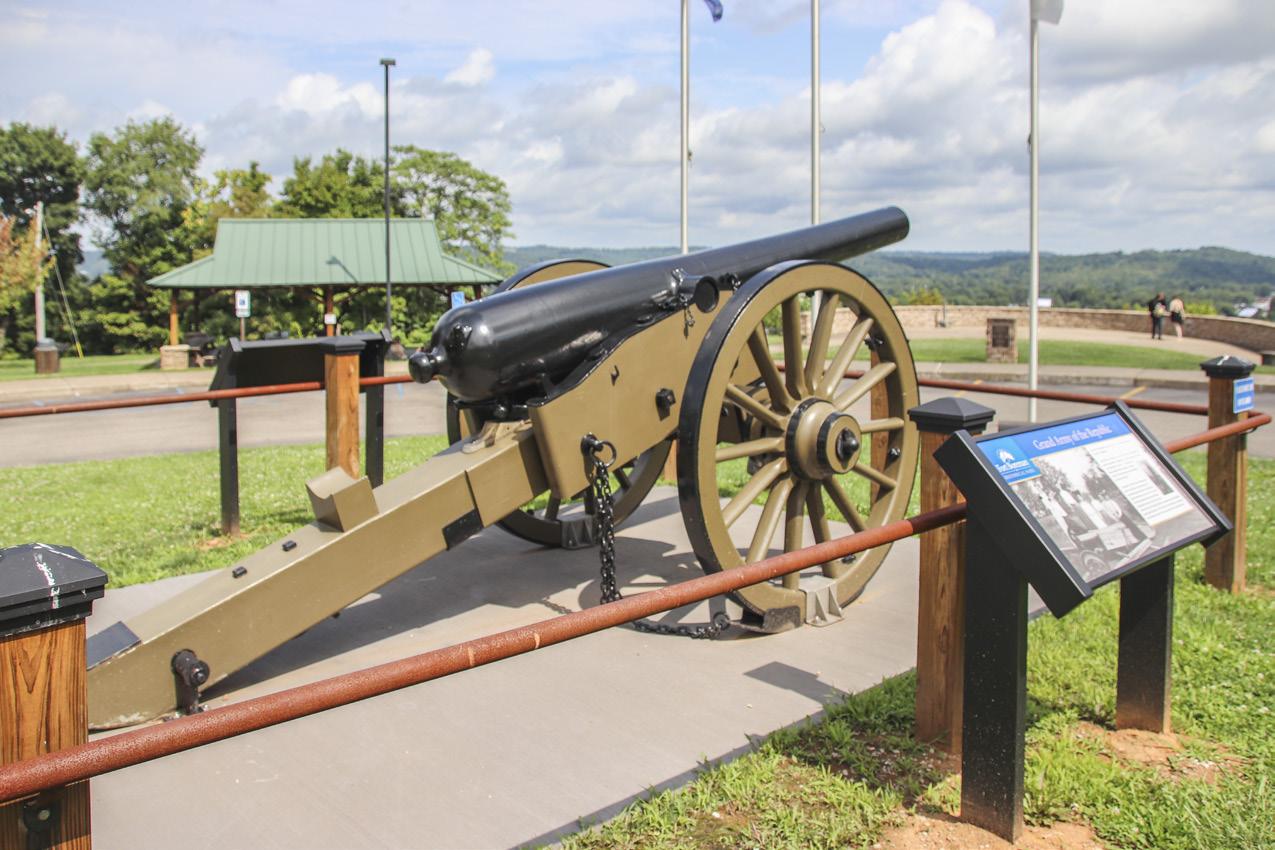
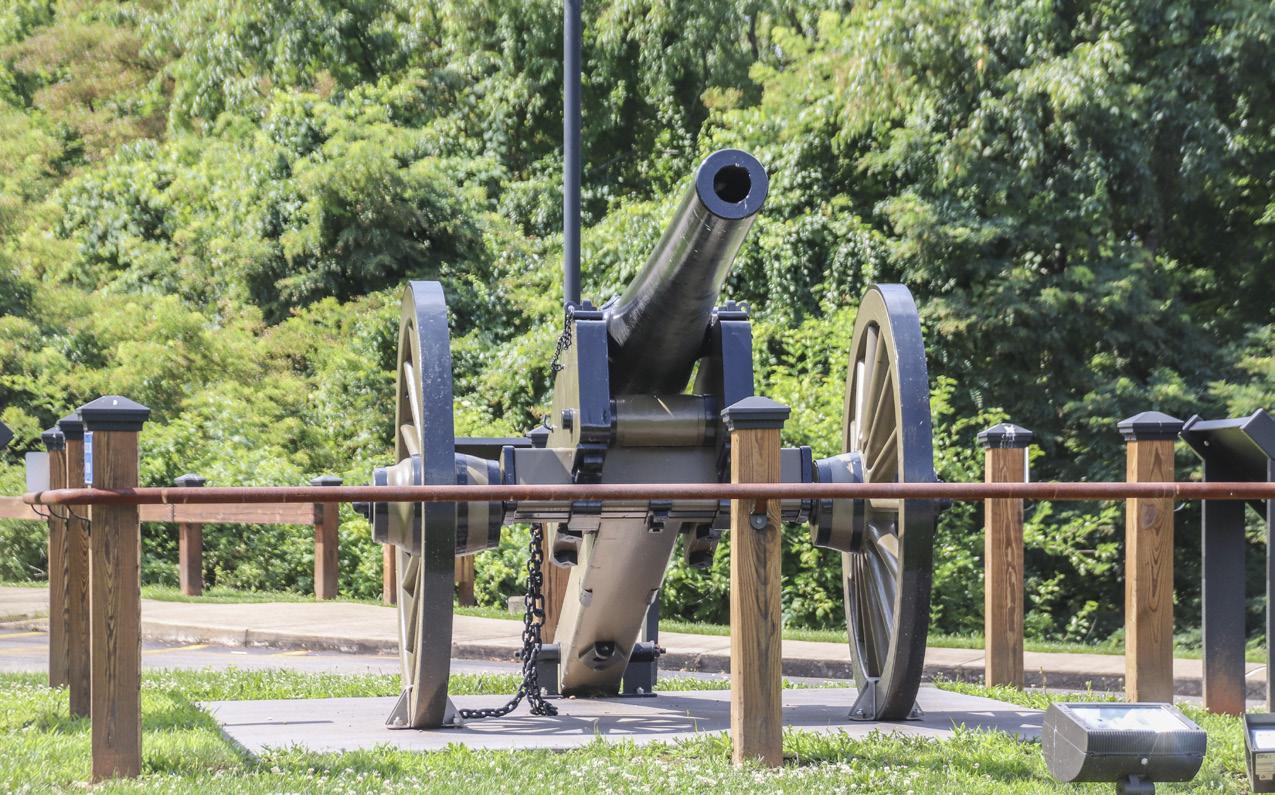
moving over ex B&O track. The 4.5-inch cannon, known locally as Long Tom, was transferred by the city to county ownership. The county had the cannon mounted on a reproduction period siege carriage. On November 15, 2021, the cannon was moved back to Fort Boreman. The 4.5-inch siege gun is now the centerpiece of the park and sits in its own private preserve located in the middle of the park’s parking lot. Unfortunately, the gun is no longer fired so one has to imagine how the sound of its firing would reverberate off the nearby Ohio Valley hills. Wood County, however, must be thanked for
spending the money to return to public view a part of our nation’s heritage.
Fort Boreman Park is open year-round from sunrise to sunset.
Charles H. Bogart has a BA from Thomas More University and an MCP from Ohio State University. He is employed as a tour guide at the Fort Boone Civil War Battle Site in Frankfort, Ky., serves as President of the Frankfort Civil War Roundtable, and is a board member of the Kentucky Civil War Roundtable. He has written several books and articles on military and naval history.
In 2019, Wood County, of which Parkersburg is the county seat, began to restore the site of Fort Boreman as a park that had hiking and biking paths, a picnic shelter, and a location from which to watch barge traffic on the Ohio River and CSXT trains A

13 October 2023 13 October 2023 CivilWarNews.com CivilWarNews.com
Hon. Arthur Ingrham Boreman. (Library of Congress)
close-up of Fort Pitts Foundry 4.5-inch siege gun No. 70.
“Long Tom” facing toward the Ohio River. A picnic shelter is in the background with a scenic overlook to the right. (Photos by Charles Bogart)
A view of the siege gun in its own plot of land with a hiking train beyond.
Clendennin’s Raid: Forgotten Foray Between Chancellorsville and Gettysburg
By Tim Talbott
When one thinks of army operations that happened between the Battles of Chancellorsville and Gettysburg, the Battle of Brandy Station (June 9, 1863) quickly comes to mind, but the Army of the Potomac and the Army of Northern Virginia were both active with other movements during this period, too.
Virginia’s Northern Neck was an area that had long troubled the Federals due to Confederate smuggling operations and guerrilla activity. Following the defeat at Chancellorsville, the Army of the Potomac camped primarily in Stafford County.
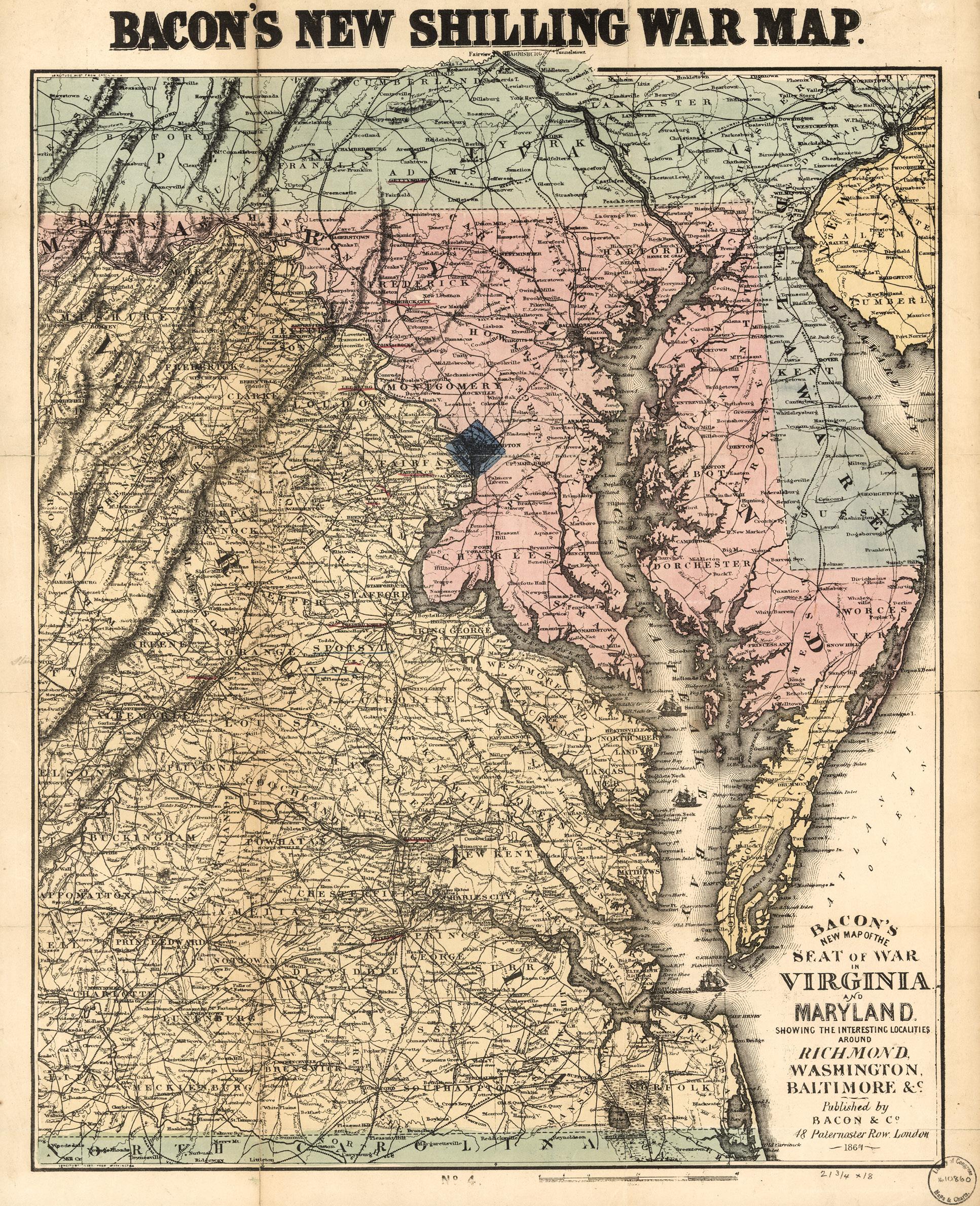
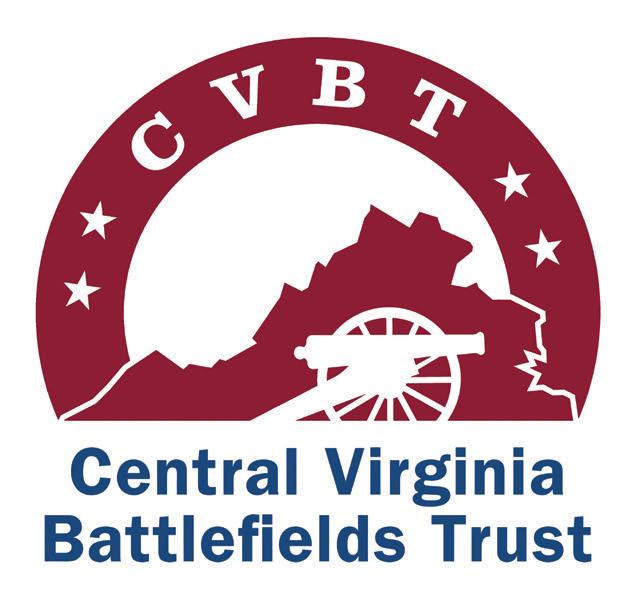
Stretching to the southeast of those encampments the Northern Neck encompasses the peninsula of land between the Potomac River to the north and the Rappahannock River to the south.
The Northern Neck consisted of the counties of King George, Westmoreland, Richmond, Northumberland, and Lancaster. This region was home to many plantations containing thousands of enslaved people, who produced significant amounts of food crops for the Confederacy.
Less than two weeks after the Battle of Chancellorsville, the 8th Illinois Cavalry received orders to make a reconnaissance through the Northern Neck. On May 16, 1863, Maj. Gen. Joseph Hooker’s chief of staff, Maj. Gen.
Daniel Butterfield, sent orders to Brig. Gen. Alfred Pleasonton directing him to “send a regiment of cavalry, down the Northern Neck, with instructions to capture and destroy all vessels . . . used for contraband trade in the Potomac or Rappahannock, and particularly to destroy those used for carrying supplies to the enemy. . . .” Chosen for the assignment was the 8th Illinois Cavalry. As the historian of the regiment noted, “Nothing could have pleased our men better, for from picketing that country, they knew where to find good living.” The cavalrymen left their camps on May 17 or 18 with about 400 men and four days of rations. Leading the troopers of the 8th Illinois was Lt. Col. David R. Clendennin. When they reached King George Court House, Clendennin divided the regiment into three parts, assigned an officer to each, and instructed them to range down different roads covering the length of the Northern Neck with the goal

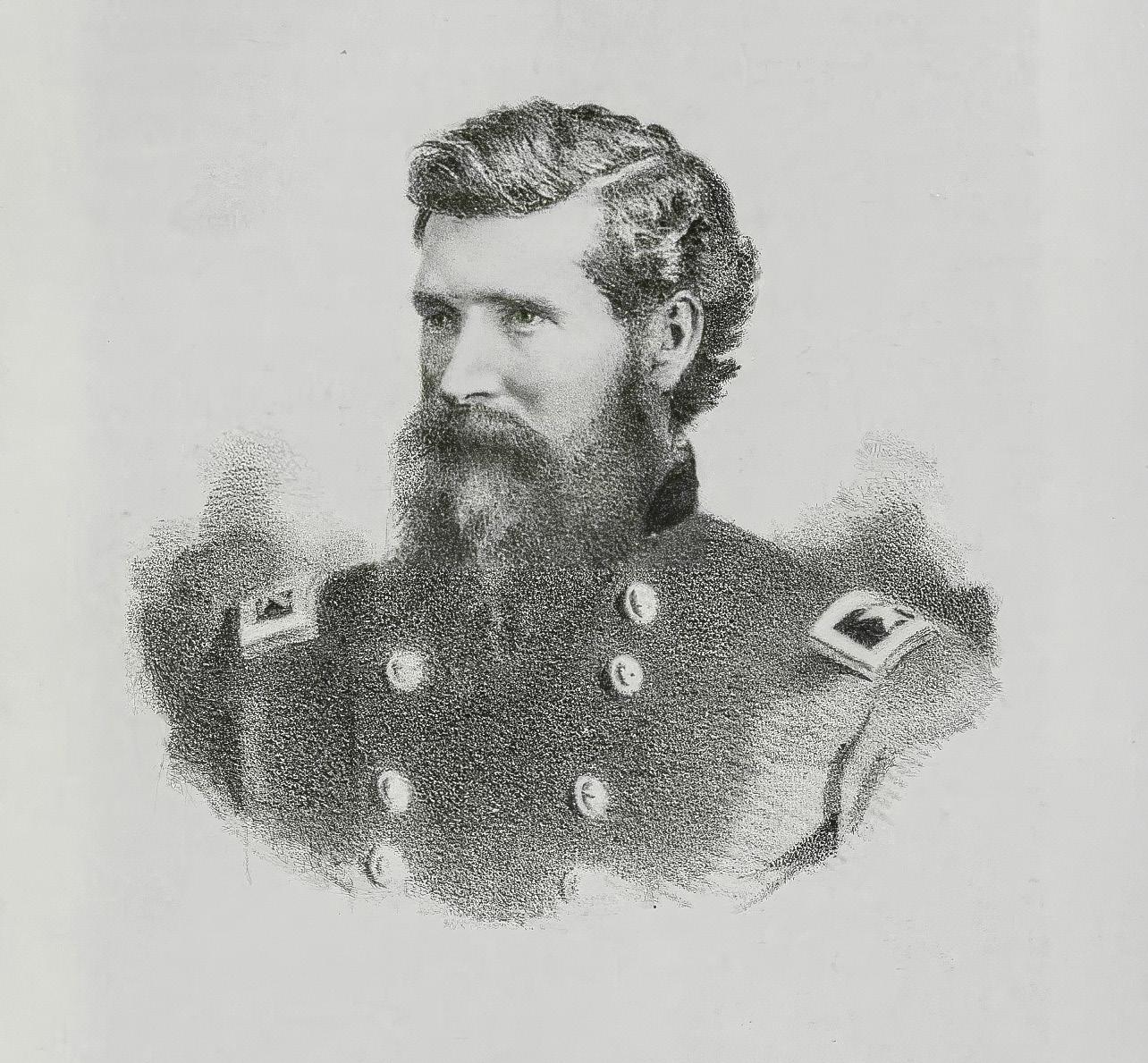
of “capturing and destroying rebel property without limit.” Apparently, the cavalrymen left no stone unturned and met limited resistance.
On May 20, Butterfield sent orders to the I Corps calling for some support for the cavalrymen in case any Confederate infantry crossed the Rappahannock to challenge the 8th Illinois. Drawing the assignment were
three infantry regiments from the Iron Brigade: the 19th Indiana, the 6th Wisconsin, and the 24th Michigan. Col. Henry Morrow of the 24th Michigan led the foot soldiers. In addition, the 8th New York Cavalry joined Morrow’s infantry.
During the expedition, the cavalrymen located “one hundred sloops, yawls, ferry-boats, &c.” Burning these watercraft also
14 CivilWarNews.com October 2023 14 October 2023 CivilWarNews.com
Virginia’s Northern Neck and its five counties are located between the Potomac River to the north and the Rappahannock River to the south. (Library of Congress)
Lt. Col. David R. Clendennin later received brevet promotions to colonel and brigadier general. Clendennin also served on the nine-member military commission investigating the Lincoln assassination. (Image from History of the Eighth Regiment Illinois Cavalry, published in 1868.)
Maj. Gen. Alfred Pleasonton. (Library of Congress)
destroyed captured supplies of “salt, oil, whisky, leather, stationery, wool cards, percussion caps, boots, shoes, clothing and many other articles of especial value to the rebels.” In addition, the troopers also destroyed “About twenty thousand pounds of bacon and a large quantity of flour.”
In their effort to seek out and ruin as much war material as possible, one group of cavalrymen learned
that a ferry boat at Leedstown in Westmoreland County was on the southern bank of the Rappahannock. Incorporating a method of deception to lure the boat to the northern shore, several of the Illinois cavalrymen donned Confederate uniforms and with a couple of previously captured prisoners hailed to the boat to take them across the river. When it arrived on the northern bank they seized the boat, took
those on board as prisoners, and burned the boat.
Meanwhile, on May 21, the regiments of the Iron Brigade marched to King George Court House. Leaving Lt. Col. Rufus Dawes of the 6th Wisconsin and about 160 soldiers to guard a road intersection, the other infantrymen moved on south toward the Rappahannock River.
One small party of the Illinois cavalry did run into some Confederate resistance on May 22. Lt. William C. Hazleton and a Sgt. Martin of Company D received fire from guerrillas while away from their camp. Martin took 15 buckshot, leaving him “severely wounded,” while Hazelton escaped unscathed.
The same day, Colonel. Morrow and his infantry contingent learned about Confederate boats on the Rappahannock’s southern shore he hoped to destroy. But on May 23 Morrow’s men were either unable to locate them or the information proved false, as “The attempt was made with every prospect of success, but failed.” Morrow’s men had to be content with firing at some Confederate cavalry across the river, but at too great of distance to do anything but encourage them to ride off.
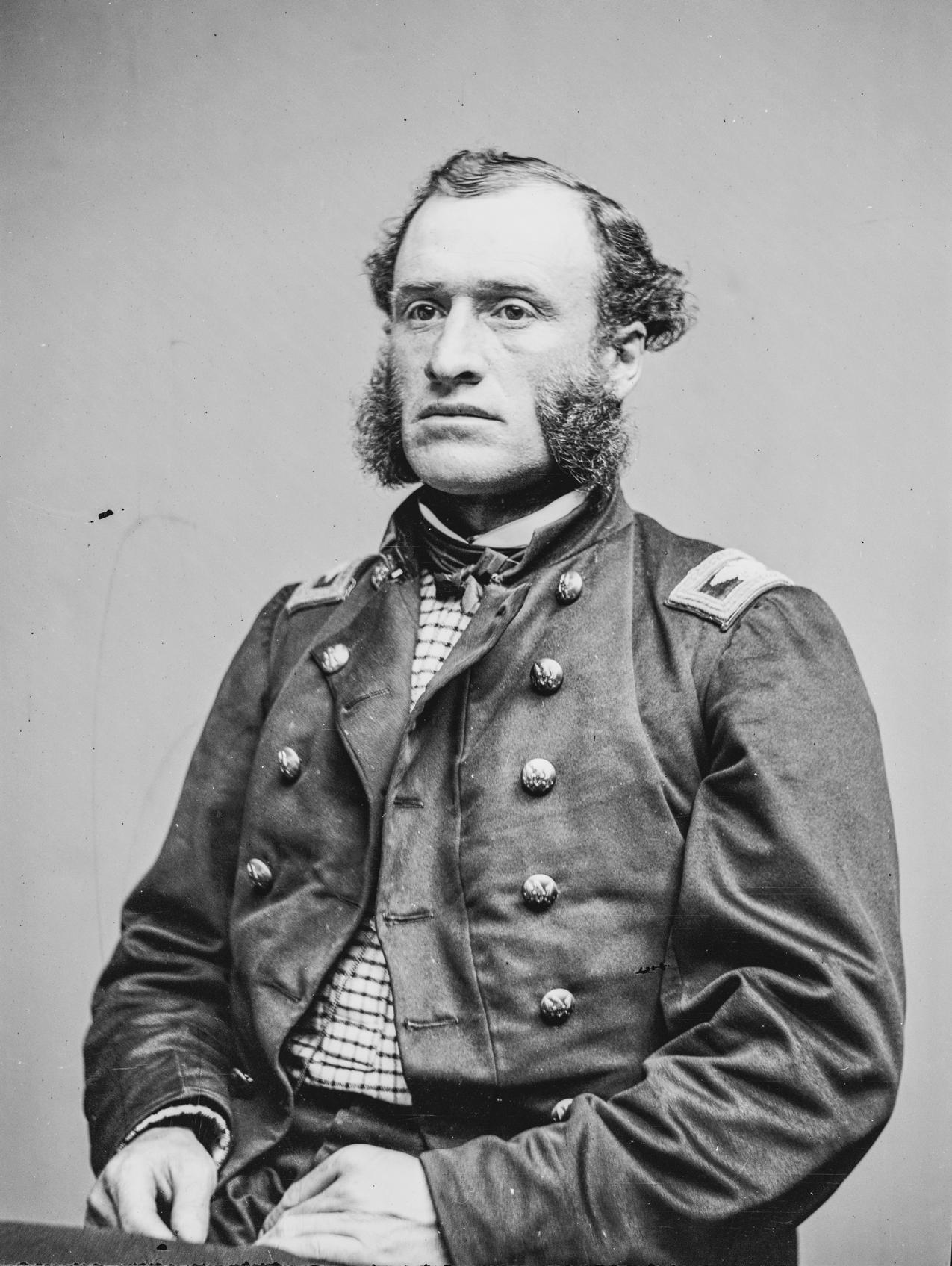
As briefly mentioned earlier, the Northern Neck contained a large number of enslaved people. The five counties that make up the region counted 17,151 bondsmen, women, and children in the 1860 census. On average, the population for the combined five counties was over 51 percent enslaved.
During the 8th Illinois Cavalry’s return trip up the Neck, many of
these freedom-seeking people took advantage of the Federal cavalry’s presence and “joined the emancipating column.” With the Emancipation Proclamation having gone into effect on January 1, 1863, and knowing that taking laborers away from their enemies helped weaken the Confederacy, Union troopers encouraged the refugees. The regimental historian noted that “Coming in squads from five to twenty . . . they brought with them all their personal property, horses, mules, carts, clothing, &c., and doubtless some [possessions] that did not legitimately belong to them, but which they had confiscated . . . from rebel masters. . . .” In addition, information provided by those just emancipated helped ensure the success of the raid.
The historian of the 8th Illinois claimed that the regiment eventually “accumulated fifteen hundred men, women, and children,” but the official report that Gen. Pleasanton filed on May 26 noted the raiding cavalrymen brought away 800 formerly enslaved people. Regardless of the exact figure, the number was significant.

Colonel Morrow and his Iron Brigade regiments had not located the Illinois cavalrymen by May 23. However, as they started to move further southeast on the Northern Neck, they encountered the Illinois troopers and their assorted “procession, which was three miles long,” on May 24.
After about a week in their saddles, the cavalrymen returned to their camps, “and not a more ludicrous procession was ever seen than this cavalcade of cavalry, negroes, captured horses, mules, carts, wagons, oxen, rebel soldiers, trotting sulkies, top carriages &c. &C,” wrote the historian of the 8th Illinois.
General Pleasonton’s report on May 26 noted that in addition to the freed people, “innumerable mules, horses, &c” and “between 40 and 50 prisoners, including a captain and lieutenant” were all brought back. Pleasonton estimated that, “The amount of damage done the enemy is thought to be nearly $1,000,000.” Apparently, the mission only resulted in three cavalrymen casualties: one “severely wounded and 2 slightly.” The general’s brief report ended by claiming that, “Considering the force engaged and the results obtained, this is the greatest raid of the war.”
Perhaps one reason that Clendennin’s Northern Neck raid remains so forgotten is its timing. Sandwiched between Stoneman’s Raid during the Chancellorsville Campaign and the Battle of Brandy Station and the Federal cavalry’s strong performance during much of the Gettysburg Campaign, it simply gets marginalized. However, for the enslaved people who joined in Clendennin’s “emancipating column” it was a life-changing and probably long-remembered milestone.
The mission of CVBT is to preserve land associated with the four major campaigns of: Fredericksburg, Chancellorsville, Mine Run, and the Overland Campaign, including the Wilderness, and Spotsylvania Court House. To learn more about this grassroots preservation non-profit, which has saved over 1,700 acres of hallowed ground, please visit: www.cvbt.org.
15 October 2023 15 October 2023 CivilWarNews.com CivilWarNews.com Publishers/Authors Send your book(s) for review to: Civil War News 2800 Scenic Dr, Suite 4-304 Blue Ridge, GA 30513
Col. Henry Morrow, 24th Michigan Infantry, led three Iron Brigade regiments as support during Clendennin’s Raid. (Library of Congress)
Scenes like this one sketched artist Edwin Forbes later in 1863 were likely common during the Clendennin Raid as hundreds of formerly enslaved people sought freedom. (Library of Congress)
Tim Talbott is the Chief Administrative Officer with the Central Virginia Battlefields Trust.
Ashley R. Rhodes Ashley Rhodes (318) 419-0535 or email luckydog530@yahoo.com Original Colonial, Revolutionary War, Antebellum & Civil War, Documents, General Orders, Newspapers, Images, and Imprints. Visit my eBay store at: www.ebay.com/str/reddevilsmilitaria Over 15,000 sales and 100% Positive Feedback
By Gordon W. Gribble
Harry Whitlock Lewis was born in Harbor Creek, Penn., on August 30, 1840. He grew up in nearby Fairview on Lake Erie. He first enlisted on May 21, 1861, in the three-months McLane’s Regiment; then on July 29, 1861, he enlisted in Company G, 6th U.S. Cavalry as 1st Sergeant under Captain John Irwin Gregg. Following the horrendous fighting at Gettysburg on July 1–2, 1863, the morning of July 3 Harry Lewis and the Army of the Potomac’s Reserve Cavalry Brigade, consisting of 2,000 officers and men under General Wesley Merritt, were patrolling roads around Emmitsburg, Md., well behind the Confederate Army of Northern Virginia, and some 11 miles from Gettysburg.
Sometime that morning a man, ostensibly a local citizen, rode into Merritt’s headquarters to report a lightly guarded Confederate supply wagon train in a valley just north Fairfield, about 10 miles north. There was some suspicion that this “citizen” was a Confederate spy, perhaps William Richardson who was subsequently captured and hanged on July 7 in Frederick, Md. Eager to capture the prize, Merritt detached the 6th U.S.
Captured at Fairfield and Imprisoned at Belle Isle
Sgt. Harry Whitlock Lewis, 6th U.S. Cavalry

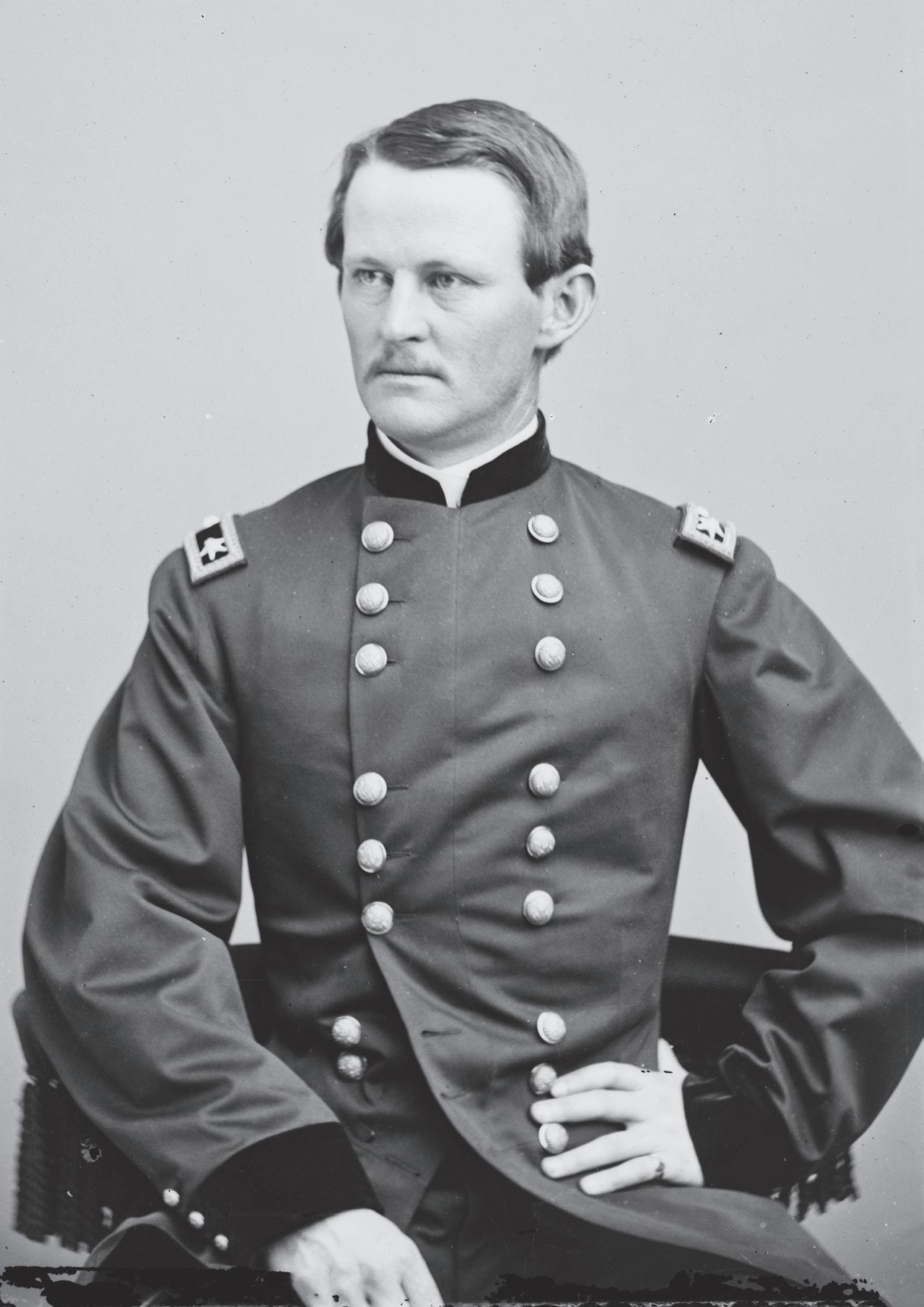
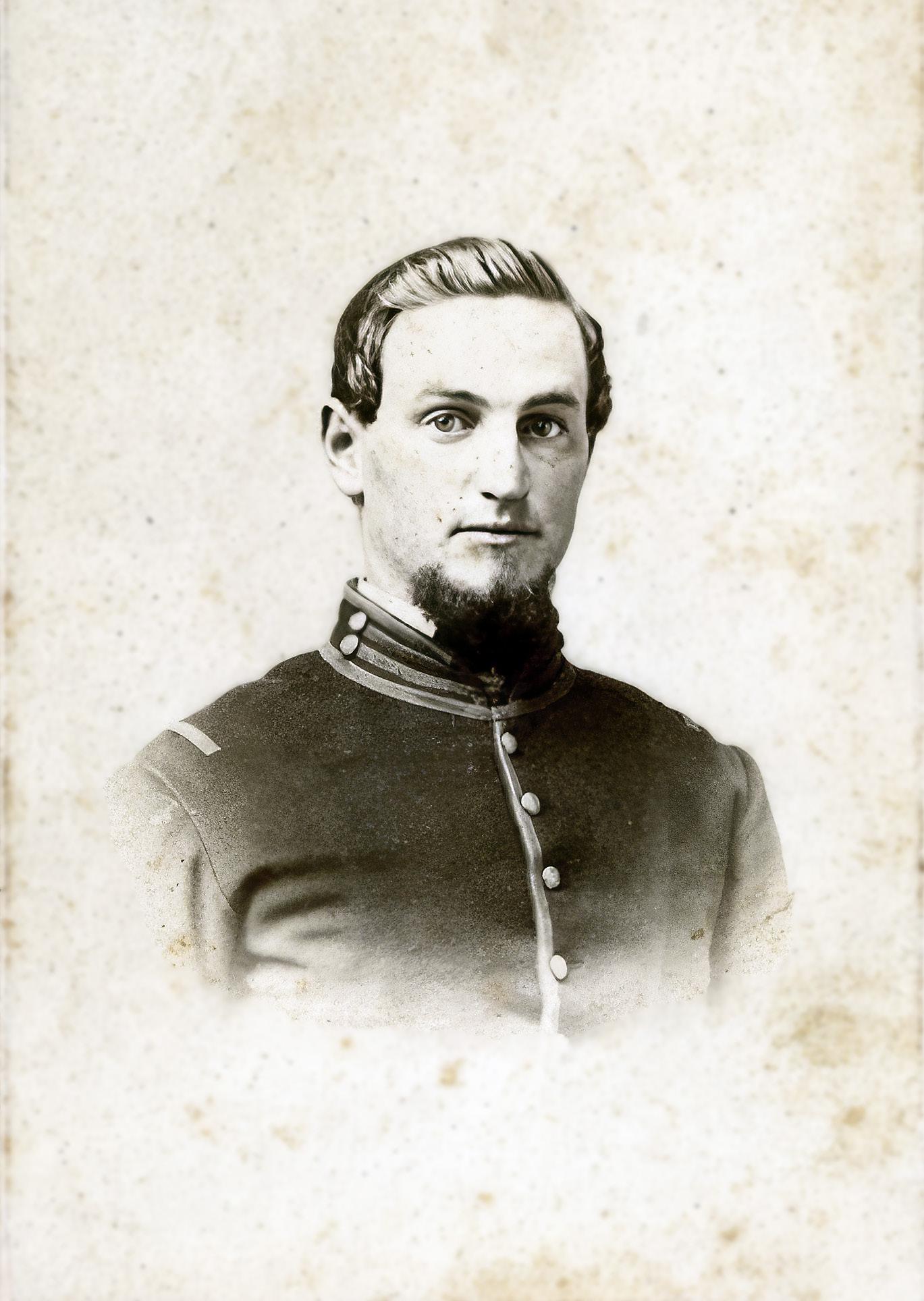
Cavalry’s some 400 officers and men under Major Samuel Henry Starr to seize these wagons. Approaching the wagons on the Fairfield-Orrtanna Road north of Fairfield and seeing only a small picket force guarding the wagons, Starr detached two companies (about 60 men) under Lt. Christian Balder to capture the wagons. Balder chased the retreating wagons, along with their guard, the 7th Virginia Cavalry, further north for about a mile. Suddenly, Balder and his men were confronted near the Marshall farmhouse stands today [1051 Carrolls Tract Road], not by a small picket force, but by the General William “Grumble” Jones’ full brigade, including the 6th, 11th, and 7th Virginia cavalry regiments, some 1,600 officers and men, along with Robert Chew’s Horse Artillery battery with five guns and 95 men.
Balder realized he was outnumbered and withdrew in the direction of Fairfield. Viewing the situation, Major Starr sent the full complement of his Sixth U.S., 320 troopers to engage the Virginians. The resulting clash was short but intense; the badly outnumbered Yankee cavalrymen were solidly whipped and retreated toward Fairfield where many survivors
were captured. The Sixth lost six men killed, 28 wounded, and 208 captured, a loss of 60%, while General Jones’ 1,600 men had a
total loss of 58 killed, wounded, and missing. Major Samuel Starr lost an arm and Lt. Christian Balder was among the dead. A
bright spot for the Sixth was that Private George Crawford Platt saved the regimental flag when the flag bearer went down amidst the swarming Confederates. Platt was awarded the Congressional Medal of Honor.
The captured men, including Harry Lewis, were initially marched from Fairfield to Gettysburg where they were joined by thousands of other Union prisoners from the three-day battle. The Federal captives faced a long march to a Richmond prison. During the consolidation of Union prisoners, a new prisoner in the group from Gettysburg shouted out, “What troops are these?” Harry Lewis was actually standing nearby and replied, Part of the Sixth U.S. Cavalry.” The other man replied: Is Sgt. Harry Lewis there? Harry answered, “Yes, and as there were no guards between us, I walked over to them. Here was Cpl. John Starr of Co. B of the 145th PA volunteers. He told me that my brother, Lieut. Horatio Lewis, had been badly wounded [July 2 in the Wheatfield, cf., The Gettysburg Experience, May 2022], shot in both legs, his left leg broken (bone shattered) near the body, that while they were trying to carry Horatio off the field, the rebs who had gained their rear, had captured them, and that the lieutenant would probably bleed to death.” Harry never knew until he returned home that Horatio lived until July 20, but succumbed after his leg was amputated.
Harry’s account continues, “Early the next morning, part of Longstreet’s corps marched past us on the retreat. Soon we started on the march; sometimes we were marched along beside the troops, at other times between two of their brigades. We saw Gen. Longstreet several times during the day. We prisoners and Longstreet’s corps passed through Fairfield in the afternoon of the 5th; they marched us nearly all night (it was very dark). Several of us tried repeatedly to escape, but each time were driven back at the point of a bayonet. There were two lines of guards on each side of us. One of our boys escaped by standing behind a tree in the road until the column passed.” The total prisoners included 3,500 enlisted men and 180 commissioned officers.
The route of Harry’s march to Richmond was described by fellow prisoner Lt. Tattnall Paulding, also of Company G.
16 CivilWarNews.com October 2023 16 October 2023 CivilWarNews.com
Harry W. Lewis, Feb. 1863 (Image from Hagen History Center, Erie, PA). Gen. Wesley Merritt. (Library of Congress)
General William “Grumble” Jones. (Library of Congress)
Paulding’s account began on Sunday July 5, “Marched at 9 A.M. Passed through Fairfield in the afternoon & thence over the mountains (Catoctin) & at midnight camped at Monterey Sta. [Pass] completely worn out.” They were marched through Waynesboro, Hagerstown, Williamsport, Martinsburg, Winchester, Strasburg, Harrisonburg, and Staunton where they boarded a train to Richmond. Paulding arrived at Libby Prison on July 18; Harry arrived somewhat later. The march to Harrisonburg was about 180 miles, averaging 13-14 miles per day.
It appears that the prisoners typically first arrived at Libby Prison, and then the enlisted men were transferred to Belle Isle Island in the middle of the James River. Thus, Harry Lewis and Charles F. Miller (Company I) were housed on Belle Isle, whereas Lt. Tattnall Paulding (Company G) remained at Libby. Letters sent by Paulding from Libby were typically censored but a few were smuggled out. Paulding wrote, “Hunger, cold, exposure, and vermin combine to make them [enlisted men at Belle Isle] wretched beyond description.” Disease and death were common occurrences as both prisons were severely overcrowded, replete with vermin, and lacked sufficient food, clothing, and blankets. Libby was designed to hold 3,000 prisoners but by early 1864 there

were more than 8,000. There were a combined 9,116 prisoners in Libby and Belle Isle in early 1864.
The winter of 1863–1864 was especially brutal. At Belle Isle the only shelter was shallow pits scratched into the soil. Food and blankets were scarce at best; on one occasion the men killed and ate the commandant’s dog. At Belle Isle there were “as many as six thousand men, exposed in summer to the burning sun, without the shadow of a single tree, and in winter to the cold damp winds from the river with a few miserable tents….The prisoners had no access to the river, and all the water they had was obtained by digging holes deep enough so it would leach in from the river.” The limited food given to the prisoners was barely edible. Lice, mites, fleas, and other vermin plagued the men. Miller noted, “I have, for curiosity, counted, so I could average how many “Grays” [body lice] and “Linebackers” I had slaughtered during my incarceration. From 200–300 per day…estimated the lower number of 36,000 during 180 days in Belle Isle.” Miller described a soup made of peas which so literally swarmed with bugs that I might justly name it “Bug Soup.” Before this could be eaten, it would have to stand to let the bugs rise to the top to be skimmed off, and the sand settle to the bottom.” Miller also mentioned a “mere youth” who failed to be counted for his
rations and went without food for days. Finally, the Commissary Officer ordered a full pail of soup for the starving man. Miller sadly concluded, he was not long in devouring the contents, and before the sun set he was carried out of camp and laid in a row with others awaiting burial.”
Harry also wrote about his march to Belle Isle and incarceration. “While a prisoner of war, from Gettysburg until we struck the Va Central RR at Santun, we had to wade all streams from ankle to waist deep (the bridges being gone), once for 17 days it rained nearly all the time, no Shelter no chance to dry or change clothes, no blanket, only pants, shirt and blouse to ware, barefooted nearly all the 4 months, exposed to rain – hot Sun and chilly nights, with the camp teaming with untold billions of body lice, knawing the lifes blood out of you, and only 1/4 enough food, was under cover only two weeks just before being paroled.”
Sgt. Jacob Osborn Coburn, 6th Michigan Cavalry, was also on Belle Island and noted in his diary that “the majority of cases died of chronic diarrhea [from which he died on March 8, 1864].
During the past month [February 1864] 337 cases suffering from this disease were admitted [to the hospital]. The deaths from this disease during the month sum up to 265. Dysentery and typhoid fever also caused many deaths; the latter’s death rate was 65% in a typical month.” During the
brutal winter of 1863–1864, “the new horror was frostbite. Hands and feet of some were amputated and others were so neglected that the limbs were rotting and fall off from the limbs, and death usually followed.” Pvt. George Dingman of the 27th Michigan Infantry noted “During January [1864], the men would run all night to keep warm, and in the morning, I would see men lying dead; from three to six or seven; they were frozen. This was nearly every morning I was there; the men would run to keep warm, and then lie down and freeze to death; we made an estimate and found that 17 men died a night from starvation and cold, on an average.”
Prisoners in Libby also suffered from the cold as Capt. Robert Thompson Cornwell of the 67th Pennsylvania Infantry noted in a diary entry for January 9, 1864, “Last night was very cold. Oh! What must our men on Bell Island [sic] have suffered without wood, few blankets, and only 1/4 rations. I am credibly informed that three of our men froze to death last night. It pains me to think of it.” On January 11, 1864, Cornell wrote that, “I still hear that our men on Bell Island [sic] are absolutely freezing to death. Last night was bitter cold. I cannot give expression to my feelings when I think of this terrible outrage on humanity.” By comparison, life at Libby was a luxury. Cornwell wrote on March 15, 1864, “Pleasant, No particular news. My day for cooking. Had fried potatoes, dried beef fried with flour, gravy, pancakes & tea for breakfast. Boiled potatoes, rice pudding, pancakes & tea for dinner – Only two meals. Quite a batch of Yankee prisoners passed here on their way from the [Belle] Island to Americus, Georgia [Andersonville Prison]. They looked hard, and some were hardly able to waddle.” Cornwell played chess extensively, read many books, cooked food, and kept warm, in stark contrast to the horrors suffered by the inmates in Belle Isle, just a mile away across the James River.
After over three years’ service, Sgt. Lewis received an honorable discharge at City Point, Va., on July 7, 1864. He returned to Erie County where he engaged in farming and became the postmaster of Swanville for four years. In 1881 he received an appointment as Custom House Inspector. Eight years later, on July 1, 1889, he was appointed a mail carrier at Erie where he worked until 1909. For eleven years he was Officer of the Day of his G.A.R. Post and a member of the Royal Arcanum. Harry
married Susan Myers of Fairview on June 10, 1865, and they had six children. Harry died March 9, 1912, in Erie. Up until his death Harry was a prolific family correspondent and wrote weekly letters in the Erie Daily Times on a wide variety of subjects of local and historical interest.
Sources:
• Carter, William H. From Yorktown to Santiago with the Sixth U.S. Cavalry. The Lord Baltimore Press, 1900.
• Caughey, Donald C. and Jones, Jimmy J. The 6th United States Cavalry in the Civil War McFarland & Co., Philadelphia, PA, 2013.
• Thomas, Sarah S., Smith, Tim, Kross, Gary, and Thomas, Dean S. Fairfield in the Civil War. Thomas Publications, Gettysburg, PA, 2011.
• Boaz, Thomas M. Libby Prison & Beyond. Burd Street Press, Shippensburg, NJ, 1999.
• Shevchuk, Paul M. “Cut to Pieces: The Cavalry Field at Fairfield, Pennsylvania, July 3rd, 1863.” The Gettysburg Magazine, No. 1, pp 105–117, 1989.
• Wittenberg, Eric J. Gettysburg’s Forgotten Cavalry Actions, Chapter 5. Thomas Publications, Gettysburg, PA, 1998.
• Miligram, James W. “The Libby Prison Correspondence of Tattnall Paulding.” The American Philatelist 89 (December), 1975.
• Lewisiana: A paper published in 17 vols. January 1887–June 1907. Library of Congress Call No. GS69 (microfiche), compiled by Deborah Miller.
• Petruzzi, J. David “Annihilation of a Regiment, Battle of Fairfield 1863.” America’s Civil War No. 20, No. 3, pp 27–33, July 2007.
• Miller, Charles F. “With the 6th NY (sic US) Cavalry in the Civil War.” Historical Wyoming Vol. 19, No. 2, pp 38–50, 1966.
• Allison, Don Hell on Belle Isle – Diary of a Civil War POW Faded Banner Publications, Byran, Ohio, 1997.
Gordon W. Gribble is a native of San Francisco, Calif. Following his education, he was appointed Professor of Chemistry at Dartmouth College in N.H, where he has taught since 1968. He is now Emeritus. He is the great-great grandson of the Rev. Ammi Merchant Lewis, one of Harry’s brothers. Professor Gribble spent a sabbatical year (2006–2007) at Gettysburg, where he spent many hours on the battlefield. He currently lives in Lebanon, N.H.
17 October 2023 17 October 2023 CivilWarNews.com CivilWarNews.com
View of Belle Isle, Richmond, Va. (Library of Congress)
Help Protect 29 Acres at Gettysburg and Second Deep Bottom
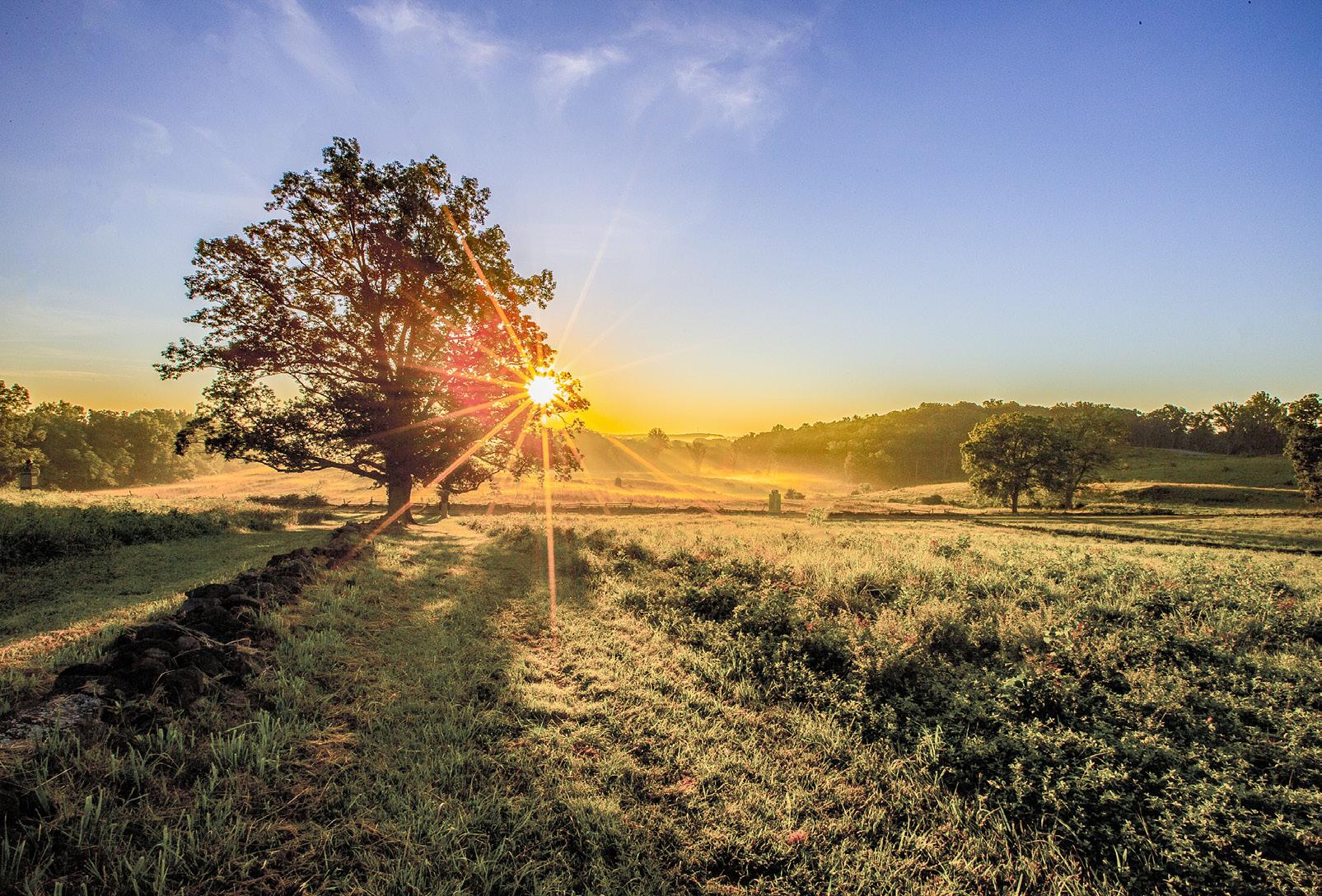
With its latest fundraising campaign, the Trust has set its sights on 29 acres of hallowed ground at Gettysburg and Deep Bottom. At Gettysburg, the possibility of 20 additional acres will contribute to the 1,243 acres already preserved at the legendary 1863 battlefield. Meanwhile, at Second Deep Bottom, the targeted nine acres are adjacent to lands previously saved by the Trust, therefore augmenting previous accomplishments.
The total cost of this preservation opportunity is a staggering $1.2 million. However, with anticipated grants from key preservation partners, the Trust is left to raise only $43,650 to finalize the deal and secure these lands. All in all, each dollar contributed will be multiplied by $29.70.
There are only a handful of battlefields that need as little introduction as Gettysburg, the 1863 battle that marked the turning point of the Civil War and the single bloodiest battle of the conflict. Here, the 20-acre tract is a few miles southwest of Gettysburg and was host to combat that pitted Union cavalry against Confederate cavalry and infantry during Pickett’s
Charge. The sought-after parcel is adjacent to two previously preserved Trust tracts and is a missing piece when telling the story of Gettysburg.
At Second Deep Bottom, Va., the Trust is working alongside a generous preservationist to preserve a nine-acre parcel. The Confederate victory at Second Deep Bottom was a result of a Union thrust toward Richmond. This tract saw combat as the Confederate left flank and Union right engaged. It is likely where the 9th U.S. Colored Troops pushed for a fight. The Trust has previously saved 223 acres at the 1864 battlefield and can stave off development by permanently preserving these nine additional acres.
To learn more about this, and other preservation opportunities, visit our website www.battlefields. org/29AcresGettysburgDeepBottom.
Nashville Metro Council Supports Trust at Fort Negley
At the start of August, the Nashville Metro Council approved a $3 million contribution toward the Trust’s acquisition of 2.36 acres adjacent to Fort Negley Park, a critical step toward reintegrating this land into the city’s popular park and landmark. The organization has secured a purchase
contract for the land and will also apply for matching grant funds to cover the remaining $9.25 million transaction cost.
Preservation efforts will be especially impactful considering that in just the last five years, largescale mixed-use development and an arboretum connected to the neighboring Adventure Science Center were proposed on portions of the historic park property.
Constructed in 1862, Fort Negley is all that remains of the Union defenses that once encircled the city. Much of the work on these fortifications was performed by African Americans pressed into service by the Union army, either still enslaved or self-emancipated who had fled

bondage for contraband camps near Federal lines.
“This acquisition is an investment in Nashville’s future by honoring our past and creating space for future generations to learn, remember, and come together as a community,” said Nashville Mayor John Cooper.
Fort Negley is eligible for federal Battlefield Land Acquisition Grants, but the success of a project of this magnitude hinged on Metro Nashville’s involvement from the outset. All told, the Metro Council approved $18.5 million budget for Fort Negley, including funds to repair damaged masonry, begin implementation of Phase One of an ambitious master management plan and, work with groups like the Trust to acquire additional historic land to add to the park.
Ahead of State Park Opening, Cedar Mountain Secures Seven Additional Acres
As preparations for the 161st anniversary of the Battle of Cedar Mountain took place in early August, the National Park Service announced a $429,372.50 matching grant toward
protecting seven additional acres at the Cedar Mountain Battlefield. Due to the availability of grant funds, the Trust took ownership of the seven-acre tract prior to the battle anniversary.
Earlier in the year, the Trust launched a campaign to preserve a combined 104 acres of hallowed ground at Brandy Station and Cedar Mountain by using federal and state matching grants to leverage against member donations. The awarded property at Cedar Mountain is south of Confederate Gen. Stonewall Jackson’s command post near Crittenden’s Gate and other previously protected lands. The acquisition of these seven acres augments preparations for the upcoming Culpeper Battlefields State Park, which was confirmed last year after the Virginia General Assembly approved the Commonwealth’s budget. The park will be formed through a 1,700-acre donation of Trust-owned land at the Brandy Station, Cedar Mountain, Kelly’s Ford, and Rappahannock Station battlefields.
While other steps remain before a full victory can be claimed on this seven-acre success, local battlefield partners and citizens shared the excitement of this new addition to the battlefield.

New Cohort of History-Loving High Schoolers Join the Trust’s 2023-24 Youth Leadership Team
As fall settles in and students across the nation begin their back-toschool journey, the Trust is excited to announce this year’s 2023-2024 Youth Leadership Team cohort. Throughout the school year, these 10 high school students will serve as the youth face and voice of the nation’s leading battlefield land preservation and education nonprofit, promoting historic preservation, history education and historic site visitation in their local

18 CivilWarNews.com October 2023 18 October 2023 CivilWarNews.com
The sun sets at the Gettysburg National Military Park. Photo by Noel Kline.
Fort Negley Park in Nashville, Tenn.
Photo by Melissa A. Winn.
Cedar Mountain Battlefield in Culpeper County, Va.
Photo by Buddy Secor.
communities. Throughout their time in the program, each participant will be challenged to research, plan and immerse themselves in community projects that aim to energize these goals.
Participants were selected through a competitive, national application process and underwent training in many aspects of the organization’s mission—from the mechanics of land transactions to the philosophies of place-based education—and in advocacy skills, like interacting with the media and petitioning support from public officials.
YLT participant, Maurya Bonu, from Buffalo Grove, Ill., was drawn to the Trust due to her passion for history and is “motivated to make a real impact on protecting our history.” She sees the organization as a way to elevate her voice for the cause of historic preservation.
The full roster of the 2023-24 Youth Leadership Team includes: Maurya Bonu, 17, from Illinois; Alex Chayriques, 16, from Massachusetts; Daniel Gleason, 17, from Connecticut; Isabella Hernandez, 15, from California; Nathan Mercer, 17, from Georgia; Wynton Nama, 17, from Texas; Tanisha Parikh, 16, from Texas; Lila Phipps, 15, from Arizona; Leo Tadikonda, 16, from New York; and Yujin Wu, 16, from New York.
The Trust’s Youth Leadership Team is supported by the generous contributions of the Pipkin Charitable Foundation. To learn more about
the Youth Leadership Team, visit https://www.battlefields.org/ youth-leadership-team.
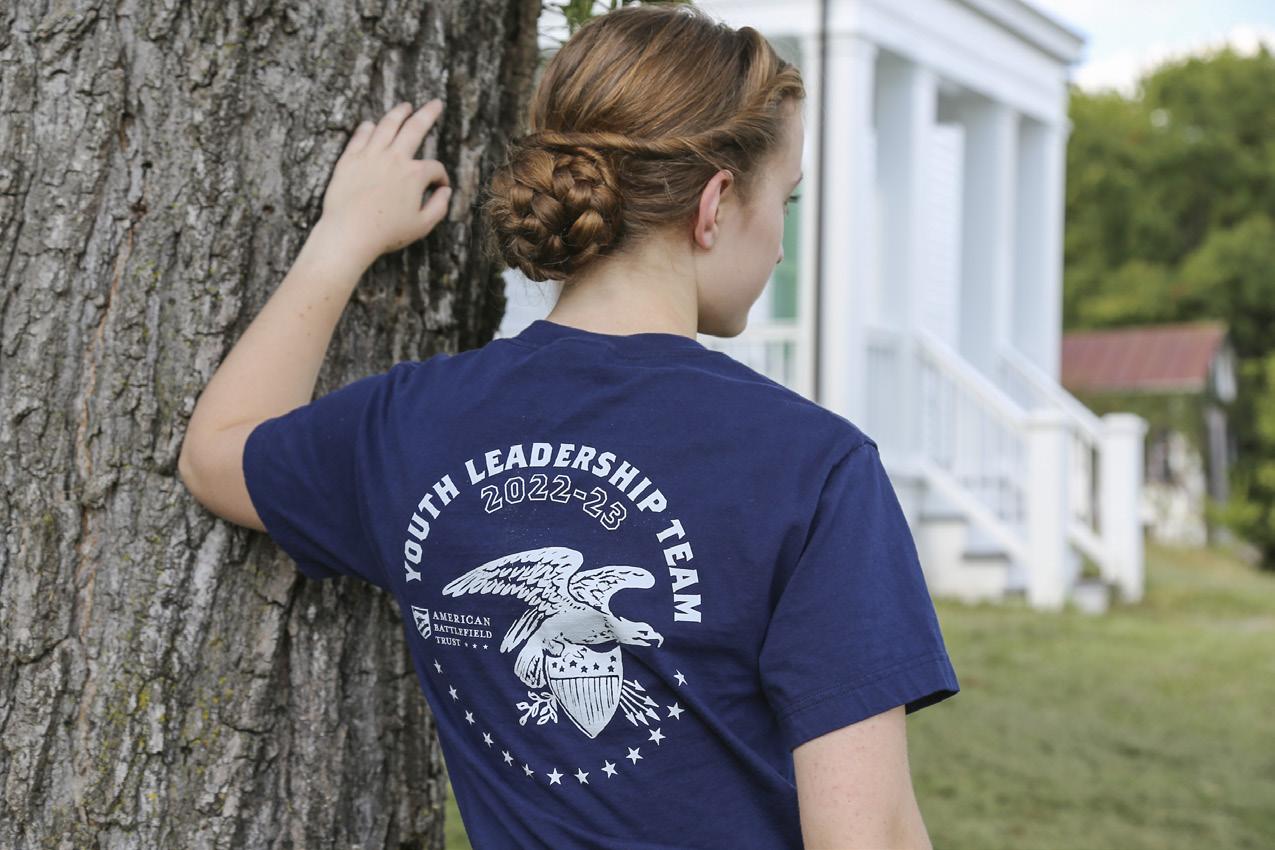
Bring the Revolutionary War to Your Classroom
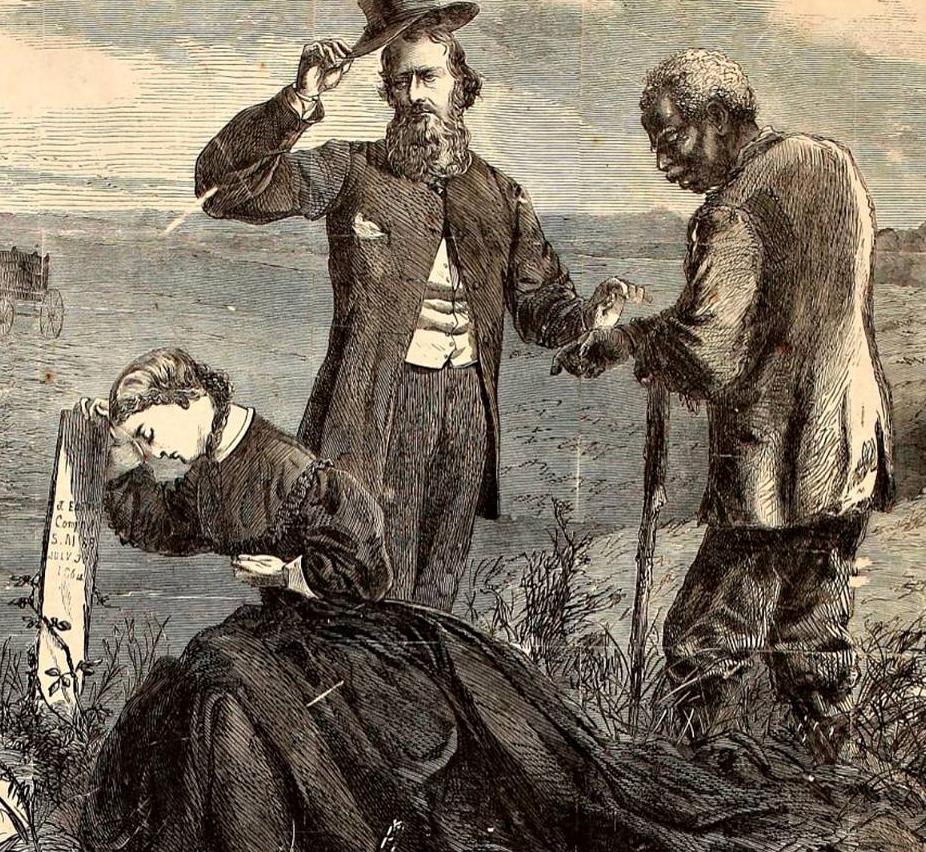
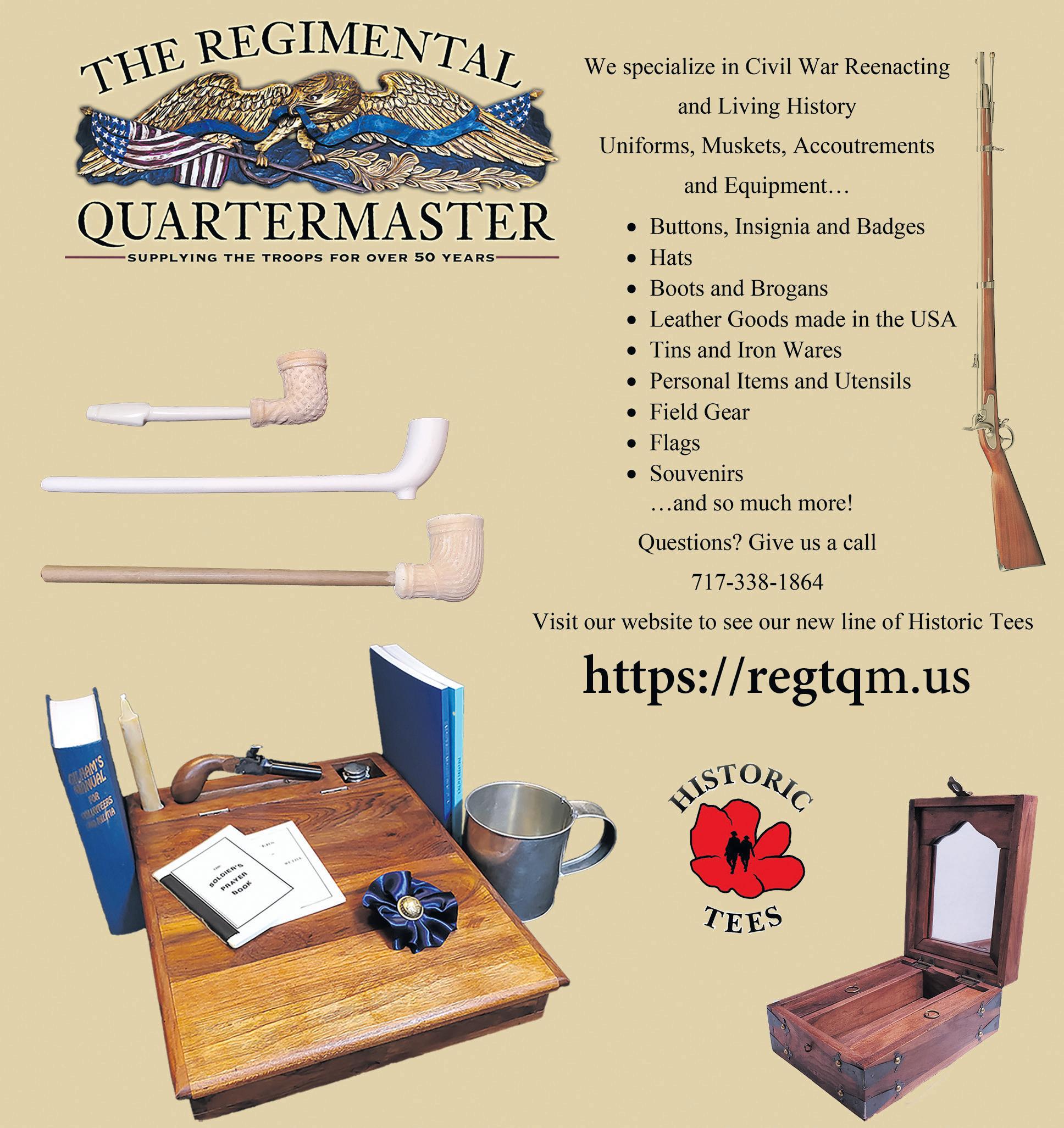
A hit amongst educators, the Trust’s “Traveling Trunk” series is being expanded to include Revolutionary War iterations! The program, which provides a trunk full of reproduction artifacts, clothing, and documents, is completely free and provides a handson experience for students in the classroom.
When applying for the trunks for the upcoming school year, teachers may choose between the Revolutionary War Traveling Trunk or the Civil War Traveling Trunk, which provide more than 30 items for students to delve into during the school week.

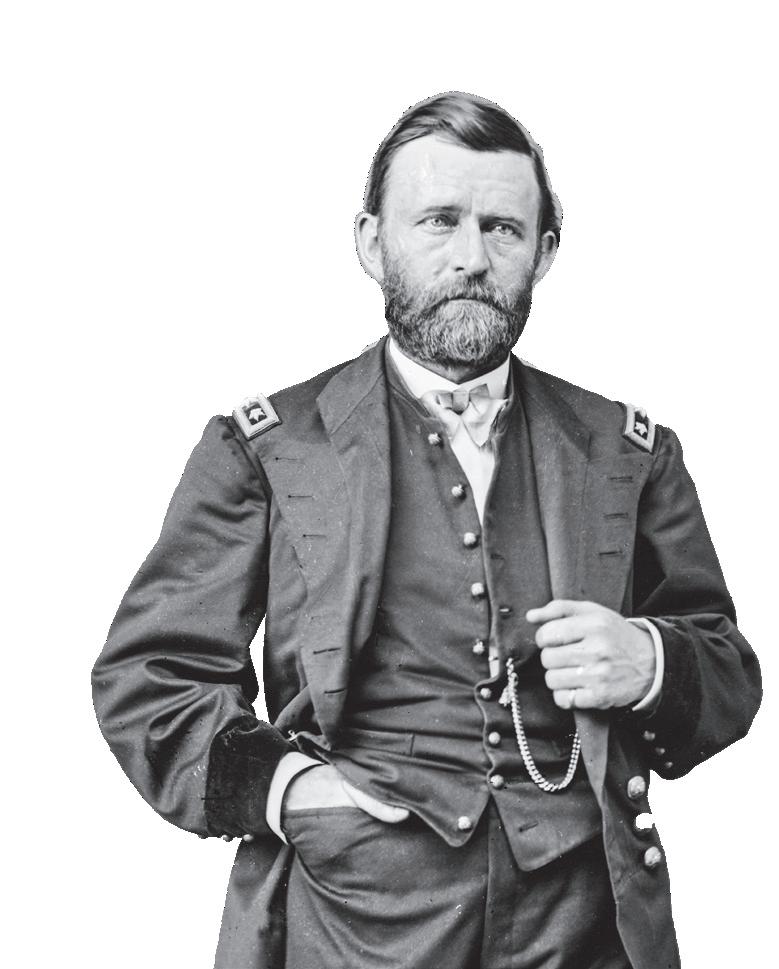
As one of the Trust’s longest standing programs, the Traveling Trunks have been popular for more than a decade, bringing new life to history on a nationwide scale. Trust President David Duncan similarly has his own take on the program: “Their ongoing popularity is a testament to the very human desire to touch the past and find tangible connections to the generations that came before us.”
To learn more about the Traveling Trunks, visit https://www.battlefields. org/learn/educators/resources/ traveling-trunks.
19 October 2023 19 October 2023 CivilWarNews.com CivilWarNews.com
Member of 2022-23 Youth Leadership Team sports her team member t-shirt. Photo by Laurel Roots Photography.
48 E. Patrick St., Frederick, MD. 301-695-1864 / civilwarmed.org Divided by Conflict. United by Compassion. Ulysses S. Grant Portrayed by E.C. Fields Jr., Ph.D. HQ: generalgrantbyhimself.com E-Telegraph: curtfields@ generalgrantbyhimself.com Signal Corps: (901) 496-6065 Facebook@ Curt Fields
First Army Medal of Honor Awarded in Civil War
By Joan Wenner, J.D.
Army Private Jacob Parrott was born in 1843 at Fairfield County, Ohio. He enlisted in the Union’s 33rd Ohio Volunteer Infantry, Company K, during April 1862. Soon after, he and nearly twodozen other volunteers were given orders to travel deep into enemy territory and destroy bridges and railroad tracks between Chattanooga and Atlanta. Near Atlanta they boarded a train heading north. When the train stopped at Big Shanty, Ga., passengers and crew got off for breakfast, but the Union raiders stay aboard, “beginning their covert mission by uncoupling the engine, fuel car and three boxcars and steaming out of the station.”
Jacob Parrott and his fellow compatriots were able to gain a little distance and damage a few bridges, but the Confederate pursuit, including railroad men and soon, soldiers commandeered another train and went in hot pursuit. The Union men uncoupled some cars but this move was said to have had little effect. When arriving at the Georgia-Tennessee border, and out of fuel, they tried to escape from their pursuers on foot, but

all were captured. After being a prisoner and allegedly severely beaten numerous times, Jacob Parrott was eventually returned to Union authorities in a prisoner exchange in March 1863. Newly promoted 1st Lieutenant Parrott, and five other raid survivors, were awarded the first Army Medal of Honor for their part in the southern raid on March 25, 1863.
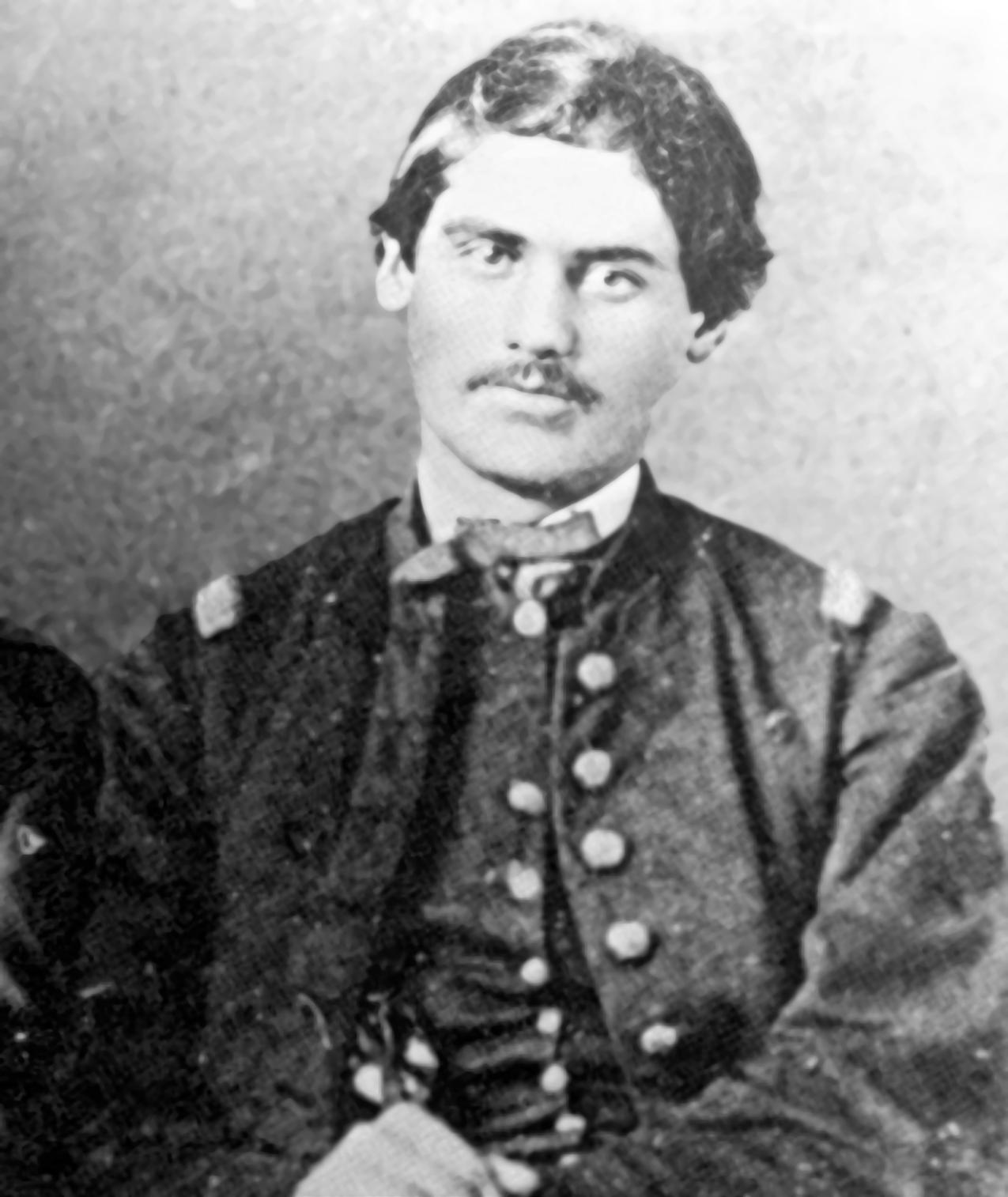
Medal of Honor

The award was created on December 21, 1861, when President Lincoln signed into law a bill providing for a medal for enlisted U.S. Navy and U.S. Marine Corps personnel “to be bestowed upon such petty officers, seamen, landsmen, and Marines as shall most distinguish themselves by their gallantry and other seaman-like qualities. On July 12, 1862, a similar award was created for soldiers and noncommissioned officers of the U.S. Army.

Throughout the war and for decades thereafter, the Medal was awarded quite freely; ;some after an individual’s personal written request, and sometimes
with no notable acts of bravery mentioned in the citation. One certain way to earn the medal was to capture a flag. In 1897, President McKinley enacted reforms tightening the criteria to include eyewitness testimony attesting to a service member’s “gallantry and intrepidity” above and beyond the call of duty.
In 1905 Theodore Roosevelt ordered that, if at all possible, the award should be presented to the recipient by the president on behalf of congress.
In 1963, the US Air Force medal of honor was created and Congress clarified the criteria further.
In the years since the Civil War, some 4,000+ service members of many different backgrounds and branches have earned it. For additional information, see the U.S. Army Department of Defense News, Katie Lange, 2017 and the Congressional Medal of Honor Society website: cmohs.org

Joan Wenner, J.D. with a law degree is a longtime contributor to CWN and other historical publications and has a special interest in maritime and courts martials. Comments are welcomed at: joan_writer@ yahoo.com
Rank: Private (Highest Rank: First Lieutenant)
Conflict/Era: U.S. Civil War
Unit/Command: Company K, 33d Ohio Infantry
Military Service Branch: U.S. Army
Medal Of Honor Action Date: April 5, 1862
Medal Of Honor Action Place: Georgia
CITATION
One of 19 of 24 men (including two civilians) who, by direction of Gen. Ormsby M. Mitchell, penetrated nearly 200 miles south into enemy territory and captured a railroad train at Big Shanty, Ga., in an attempt to destroy the bridges and track between Chattanooga and Atlanta.
Accredited To: Kenton, Hardin County, Ohio
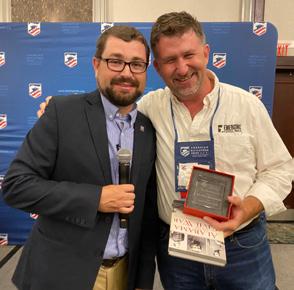
Awarded Posthumously: No
Presentation Date & Details: March 25, 1863
Washington, D.C., Presented By Sec. Of War Edwin M. Stanton
Born: July 17, 1843, Fairfield County, Oh, United States
Died: December 22, 1908, Buck, Oh, United States
Buried: Grove Cemetery (Mh), Kenton, Oh, United States
Location Of Medal: West Point Museum (1863 Design), West Point, Ny ; Hardin County Museums (1904 Design), Kenton, Oh
Loyal Legion of the Confederacy
CSA
cwmedals@yahoo.com
1 Smithbridge Rd., Unit 61, Chester Heights, PA 19017
20 CivilWarNews.com October 2023 20 October 2023 CivilWarNews.com Want To Advertise In Civil War News? Email us at ads@civilwarnews.com Call 800-777-1862 48 Pages, September Bonaventure University’s Jandoli focused on the protection of Through educational programs of our nation’s history. 2022, Mobile, Ala. collaborator with Mackowski, teacher workshops to his tours to Mackowski Receives Outstanding Service Award from American Battlefield Trust and unexpected honor for me,” there for those opportunities. It’s celebrated its 20th year 2022, days workshops, battlefield and pivotal conflicts of America’s the trust spearheaded the creation At this year’s in-person presented workshop on the teaching Civil War controversy Battlefield Trust from the trust’s Deputy Director of Education Kristopher D. White at “virtual field trip” for the trust on trust in Charleston, S.C. He has authored, co-authored, or appeared in all the major Civil Trust, regional battlefield Congress property on the Spotsylvania Subscribe online at CivilWarNews.com
National Defense Medals & other banned internet items Civil War Recreations WWW.CWMEDALS.COM
Original Medal of Honor.
Medal of Honor recipient Jacob Parrott.








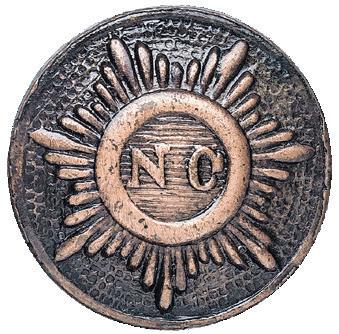
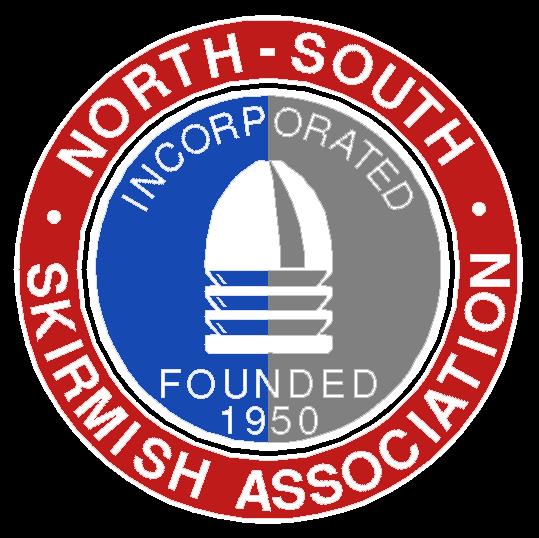

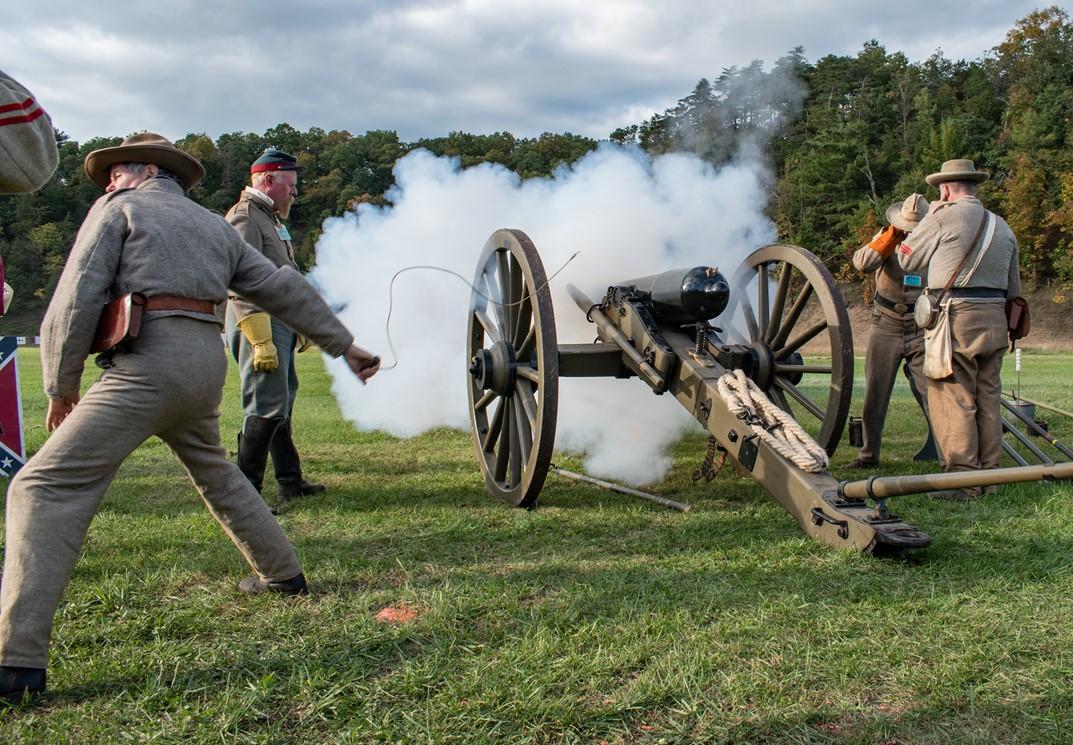



21 October 2023 21 October 2023 CivilWarNews.com CivilWarNews.com Publishers/Authors Send your book(s) for review to: Civil War News 2800 Scenic Dr, Suite 4 PMB 304, Blue Ridge, GA 30513 Contact Mike at: 910-617-0333 • mike@admci.com Provenance a Must! Fort Fisher items wanted The N-SSA is America’s oldest and largest Civil War shooting sports organization. Competitors shoot original or approved reproduction muskets, carbines and revolvers at breakable targets in a timed match. Some units even compete with cannons and mortars. Each team represents a specific Civil War regiment or unit and wears the uniform they wore over 150 years ago. Dedicated to preserving our history, period firearms competition and the camaraderie of team sports with friends and family, the N-SSA may be just right for you. For more information visit us online at www.n-ssa.org – MAKER –LEATHER WORKS (845) 339-4916 or email sales@dellsleatherworks.com WWW. DELLSLEATHERWORKS.COM Join the Crew! civilwarnavy.com 1 Year—4 Issues: $37.95 Subscribe Now at civilwarnavy.com Or send a check to: CSA Media, 29 Edenham Court, Brunswick, GA 31523 International subscriptions subject to postage surcharge. Master Distributor for GOEX POWDERS GOEX l SCHUETZEN SKIRMISH l KIK l SWISS We ship mixed 5, 10 & 25 lb. cases Cap and Ball Pistol Loaders RWS Musket, #11 caps, Schuetzen musket caps and Friction Primers WWW.POWDERINC.COM jerry@powderinc.com toll-free (877) 833-1799 Powder Inc., 1861 North College Ave., Clarksville, AR 72830
Confederate Centennial Studies
Preparing for the Civil War centennial, Dr. William Stanley Hoole, a distinguished historian, and educator, accepted the position as series editor for a planned set of books focusing on Confederate topics from the American Civil War. The first volume, in what would eventually result in a series of 28 narratives, appeared in 1956. Subsequent books released throughout the centennial years, 1961-65, and the final volume, 28, a fitting tribute to Hoole, rolled off the press in 2001. The Confederate Publishing Company in Tuscaloosa, Ala., printed the first 27 volumes. Broadfoot Publishing reprinted the set in 2000 and the Hoole narrative in 2001.

Lending their respective writing and editorial skills to the project, various historians contributed to the series. Many of these works contain primary source material—letter excerpts, journals, diaries, etc.—and each volume provides illustrations, images, citations, a bibliography, and an index. Researchers should check https://www.worldcat.org/ title/742236166 to locate this set in a local library. Several websites offer the collection for purchase, along with the availability of select titles from the series. A complete listing of the Centennial Studies appears on the next page. Good luck in researching the American Civil War!

Michael K. Shaffer is a Civil War historian, author, lecturer, and instructor who remains a member of the Society of Civil War Historians, Historians of the Civil War Western Theater, and the Georgia Association of Historians. Readers may contact him at mkscdr11@gmail.com or request speaking engagements at www.civilwarhistorian. net. Follow Michael on Facebook, www.facebook.com/ michael.k.shaffer, and Twitter @ michaelkshaffer.
Cover of volume 28.
Advertisement in Nov. 1955 The Journal of Southern History, vol. 21, No. 4.

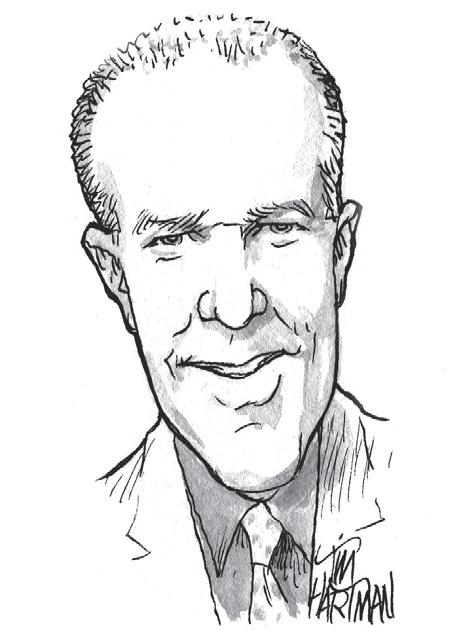
Visit our website at: HistoricalPublicationsLLC.com

The Elite Civil War Collectors The Elite Civil War Collectors Elite Collectors Civil War

7thAnnual
Military Collectors Show & Sale

October 7 & 8, 2023
Show Hours:
October 7, Saturday: 9 a.m. – 4 p.m.
October 8, Sunday: 9 a.m. – 2 p.m.
Sponsored by Fort Donelson Relics & Fleischer’s Auctions.

Admission:
$5 Admission Per Person, Kids Under 12 Free
Come see some of the finest Civil War displays in the country hosted by The Elite Civil War Collectors Facebook Group. Collectors from all over the mid-South will be on hand to discuss and share their collections and history.
Show location:
Stewart County Visitors Center 117 Visitors Center Lane
Dover, TN 37058
For information contact john@fortdonelsonrelics.com
22 CivilWarNews.com October 2023 22 October 2023 CivilWarNews.com
Confederate Centennial Studies set.
1956 1 E. Merton Coulter Lost Generation: The Life and Death of James Barrow, C.S.A.
1956 2 Jay Monaghan Swamp Fox of the Confederacy: The Life and Military Services of M. Jeff Thompson
1957 3 James W. Silver Confederate Morale and Church Propaganda
1957 4 W. Stanley Hoole Vizetelly Covers the Confederacy
1957 5 James L. Nichols Confederate Engineers
1957 6 John Q. Anderson A Texas surgeon in the C.S.A.
1958 7 Weymouth T. Jordan Rebels in the Making: Planter's Conventions and Southern Propaganda
1958 8 Richard E. Yates The Confederacy and Zeb Vance
1958 9 Captain Justus Scheibert Seven Months in the Rebel States During the North American War, 1863
1959 10 Horace Montgomery Howell Cobb's Confederate Career
1959 11 Wm. Stanley Hoole, ed. Reconstruction in West Alabama: The Memoirs of John L. Hunnicutt
1959 12 Mary Sharpe Jones and Mary Jones Mallard Yankees A'Coming: One Month's Experience During the Invasion of Liberty County, Georgia, 1864-1865
1960 13 William B. Hesseltine Lincoln's Plan of Reconstruction
1960 14 John Preston Moore, ed. My Ever Dearest Friend: The Letters of A. Dudley Mann to Jefferson Davis, 1869-1889
1960 15
Alfred Jackson Hanna and Kathryn Abbey Hanna Confederate Exiles in Venezuela
1960 16 Wm. Stanley Hoole Alabama Tories: the First Alabama Cavalry, U.S.A., 1862-1865
1961 17 Charles S. Davis Colin J. McRae: Confederate Financial Agent
1961 18 Jesse L. Keene The Peace Convention of 1861
1961 19
1962 20
1962 21
1962 22
1963 23
Civil War Artillery Book
392 page, full-color book, Civil War Artillery Projectiles – The Half Shell Book. For more information and how to order visit the website www. ArtillerymanMagazine.com or call 800-777-1862.

$89.95 + $10 media mail for the standard edition.
1963 24
Wilbur Devereux Jones The Confederate Rams at Birkenhead: A Chapter in AngloAmerican Relations
William C. Harris Leroy Pope Walker: Confederate Secretary of War
Charles Girard A Visit to the Confederate States of America in 1863: Memoir Addressed to His Majesty Napoleon III
William W. White The Confederate Veteran
Paul Pecquet du Bellet The Diplomacy of the Confederate Cabinet of Richmond and Its Agents Abroad: Being Memorandum Notes
Taken in Paris During the Rebellion of the Southern States from 1861 to 1865
Richard Harwell, ed. The Confederate Marine: A Sketch of Henry Lea Graves with Excerpts from the Graves Family Correspondence, 1861-1865
1963 25 Dwight Franklin Henderson, ed.
The Private Journal of Georgiana Gholson Walker1862-1865 with Selections from the Post-War Years 1865-1876
1964 26 Wm. Stanley Hoole Lawley Covers the Confederacy
1965 27 Charles Grayson Summersell The Cruise of C.S.S. Sumter
2001 28 Martha Dubose Hoole William Stanley Hoole: Student, Teacher, Librarian, Author
The complete listing of the Centennial Studies.
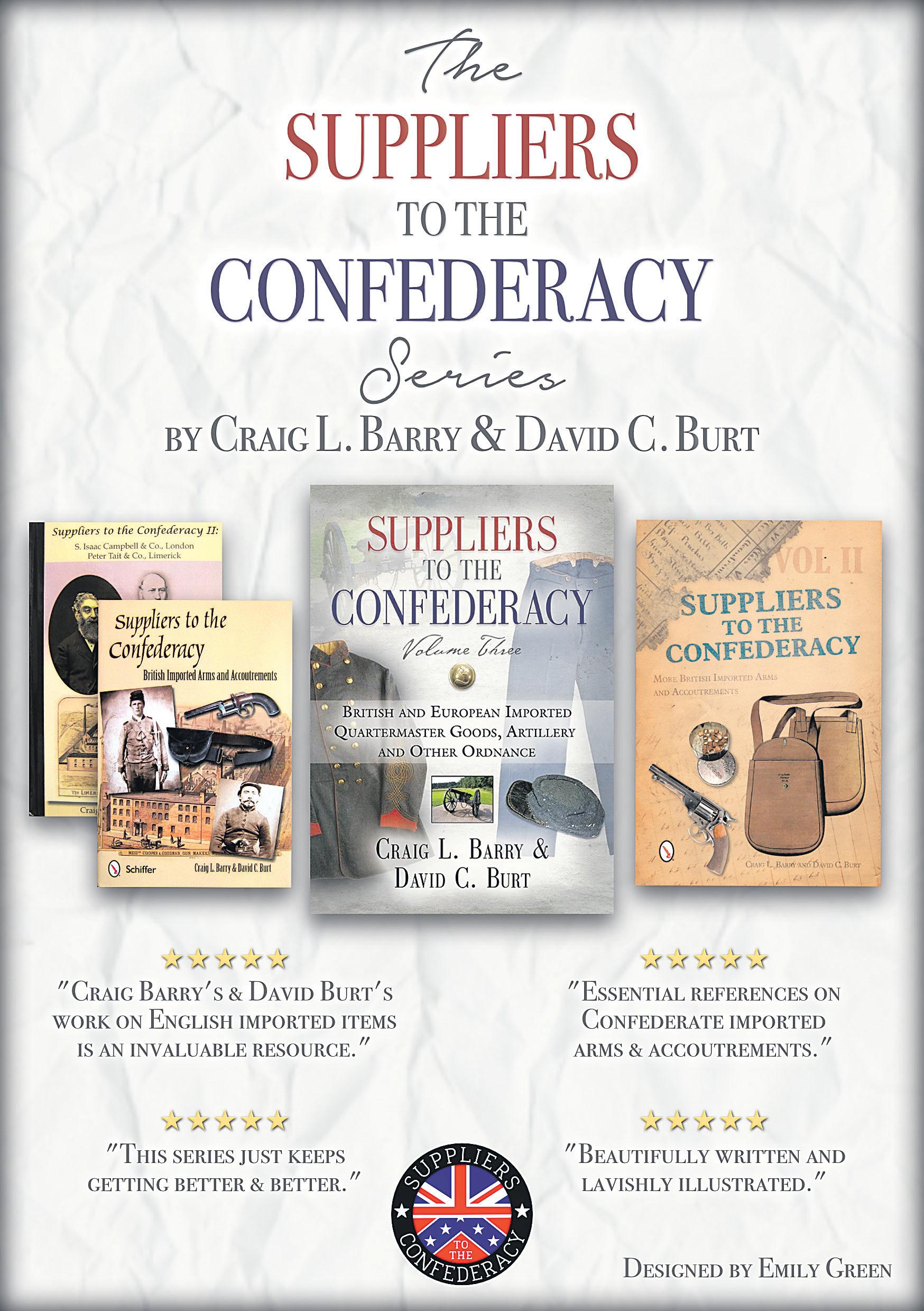

Until now, a daily account (1,630 days) of Georgia’s social, political, economic, and military events during the Civil War did not exist.
In Day by Day through the Civil War in Georgia, Michael K. Shaffer strikes a balance between the combatants while remembering the struggles of enslaved persons, folks on the home front, and merchants and clergy attempting to maintain some sense of normalcy. Maps, footnotes, a detailed index, and bibliographical references will aid those wanting more.
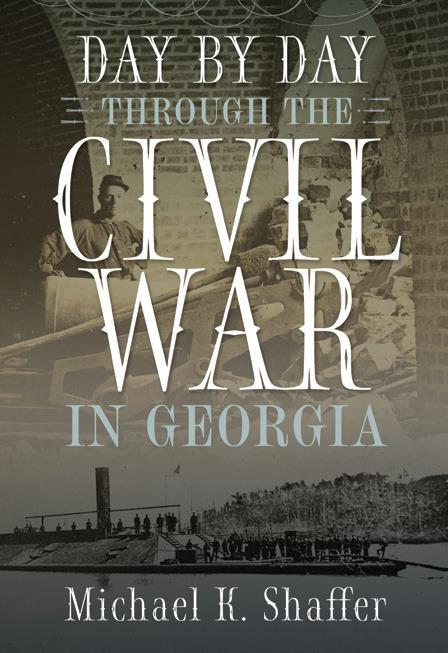
February 2022 • $37.00, hardback
Michael K. Shaffer is a Civil War historian, instructor, lecturer, newspaper columnist, and author. He is a member of the Society of Civil War Historians, Historians of the Civil War Western Theater, and the Georgia Association of Historians. Contact the author: mkscdr11@gmail.com
www.mupress.org
• 866-895-1472 toll-free
23 October 2023 23 October 2023 CivilWarNews.com CivilWarNews.com
Series
Year Published
# Author(s) Title
Day by Day through the Civil War in Georgia
The War Before the War, Part 4: The Reflections of Ulysses S. Grant
This column, the final of a four-part series, will look at the Mexican War from the perspective of Ulysses S. Grant. In his memoirs, written nearly four decades after the events, Grant narrated the military action and reflected on the causes and results of the war. Ron Chernow’s 2017 biography of Grant supplements the recollections of the 62-yearold general and president with letters from the time and other contemporary documents.

In September 1843, newly commissioned with the rank of brevet second lieutenant, Grant was posted to Jefferson Barracks,
Missouri, where he served in the 4th Infantry Regiment. While there he met Julia Dent, to whom he became engaged. It was to be a long-distance romance, however, conducted via the post.
Lieutenant Grant was going to war.
The regiment was transferred to Louisiana, then Texas. Forces were being put in place, preparing for a war that loomed as the U.S. considered annexing Texas. Grant wrote: “I was bitterly opposed to the measure, and to this day regard the war, which resulted, as one of the most unjust ever waged by a stronger against a weaker nation.” This sentence was written by a mature man with much experience in war and politics. Chernow’s biography casts some doubt as to whether Grant had the same views in the
1840s. Chernow wrote: “If Grant thought this way at the time – and some contrary evidence exists –he certainly was not outspoken about it.”
As expressed in the 1880s, Grant’s views were firm; Texas statehood meant an additional slave state; the vast expansion of the nation’s territory in the southwest could mean the further expansion of slavery. A tragic concatenation of events ensued.
“The Southern rebellion was largely the outgrowth of the Mexican war,” Grant wrote. “Nations, like individuals, are punished for their transgressions. We got our punishment in the most sanguinary and expensive war in modern times.”
Whatever his opinions, the lieutenant was an officer in the United States Army. The
country was going to war and, consequently, so was he. In March 1846, the 4th Infantry was part of a force of 2,500 led by Maj. Gen. Zachary Taylor from Corpus Christi to the Rio Grande. “We were sent to provoke a fight,” Grant wrote,” but it was essential that Mexico should commence it.”
Grant’s description of the 150mile march tells of a region with few people but large herds of wild horses and some buffalo. Water was sufficient for the army’s needs, but just barely, so “the marches had to be regulated by the distance between water supplies.” Mules needed to pull the army’s wagons were bought locally, from American traders and Mexican smugglers. His Whig commander, according to Grant, was not enthusiastic about the Democrats’ war. Grant speculated that Taylor “looked upon the enemy as the aggrieved party and was not willing to injure them further than his instructions from Washington demanded.” Strict orders against plundering were issued and, per Grant’s account, obeyed.
The first action came at Palo Alto on May 8, 1846. Something over 2,000 Americans faced a larger Mexican force in a fight that lasted most of the afternoon. The infantrymen on both sides were armed with flintlock muskets. “At the distance of a few hundred yards,” Grant wrote,
“a man might fire at you all day without your finding out.”
The Americans’ superior artillery determined the battle’s outcome. The Mexicans retreated in the night. Even though the Mexican artillery was inferior, capable of throwing only solid shot, Taylor’s men knew they had been in a fight. Grant saw an enlisted man decapitated by an enemy round, which then struck an officer. Grant described the gruesome episode in a letter: “The underjaw is gone to the windpipe and the tongue hangs down upon the throat. He will never be able to speak or to eat.”
The next day, with Grant in temporary command, his company fought at the Battle of Resaca. The unit’s role was a minor one. Grant joked that the battle “would have been won, just as it was, if I had not been there.”
Taylor’s army then moved upstream on the Rio Grande, most troops going by steamer, some, including Grant’s regiment, marching overland. For the overland march, “pack mules were hired, with Mexicans to pack and drive them.” As there is nothing in Grant’s account that implies this service was compelled, one gets the impression that the Mexicans in the area lacked enthusiasm for their own government’s cause.
Grant was serving as his regiment’s quartermaster the following September, when American and Mexican forces met in battle at Monterrey. The lieutenant was not content with his desk job, however, and he rode to the front and charged with his regiment. When the 3rd and 4th regiments were pinned down in the urban battle-scape and were running short of ammunition, Grant volunteered to ride for help. “My ride was an exposed one,” he wrote. The young horseman adjusted himself on the side of his mount and raced away. With the equine shield between him and the enemy he “got out safely without a scratch.”

Taylor would win another battle at Buena Vista in February 1847, but much of his force, including Grant’s regiment, had by then been transferred to participate in Maj. Gen. Winfield Scott’s campaign. At this point in his memoirs, Grant focused his attention on politics. Scott, like Taylor, was a Whig. President Polk, a Democrat, wanted to annex Texas and win the war, but he feared one of his Whig generals would win the White House on the strength of his battle laurels. “The administration indeed had a most embarrassing problem to solve,” wrote Grant. An account
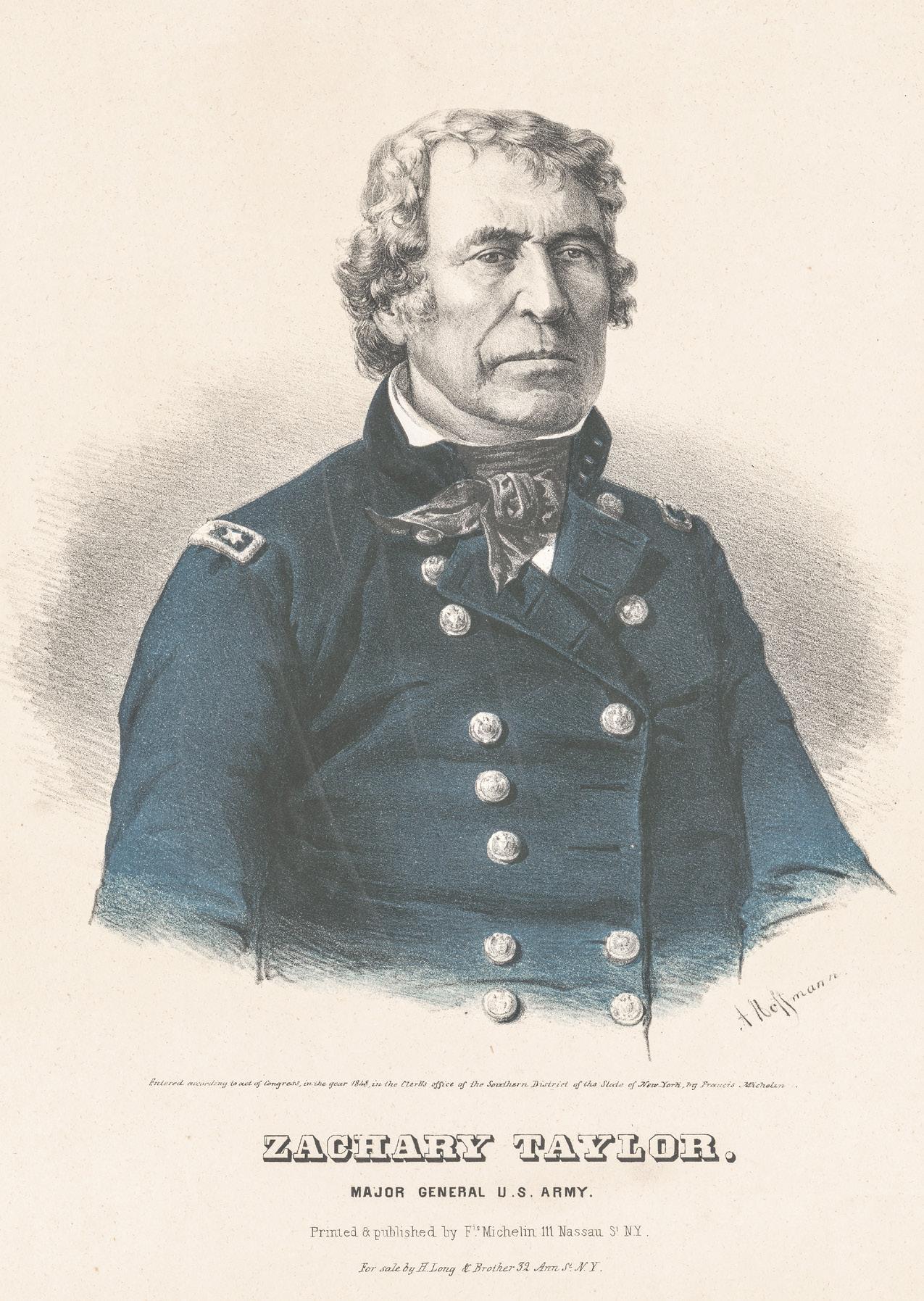
24 CivilWarNews.com October 2023 24 October 2023 CivilWarNews.com
Major General Zachary Taylor. (Library of Congress)
Youngest photograph of Ulysses S. Grant taken October 1861, Cairo, Ill. (Library of Congress)
of the political maneuvering is beyond the scope of this brief column, but it is an interesting story that readers may want to learn more about. We turn instead to Scott’s landing at Veracruz and to Grant’s activities there and on the march to Mexico City.
Lieut. General Winfield Scott. (Library of Congress) one side or the other, in the great conflict for the preservation of the unity of the nation.” In his memoirs Grant was reticent about his own actions in Mexico, devoting space instead to the larger picture. He wrote nothing about what he did at Veracruz. Of his own actions at Cerro Gordo, he again was silent.
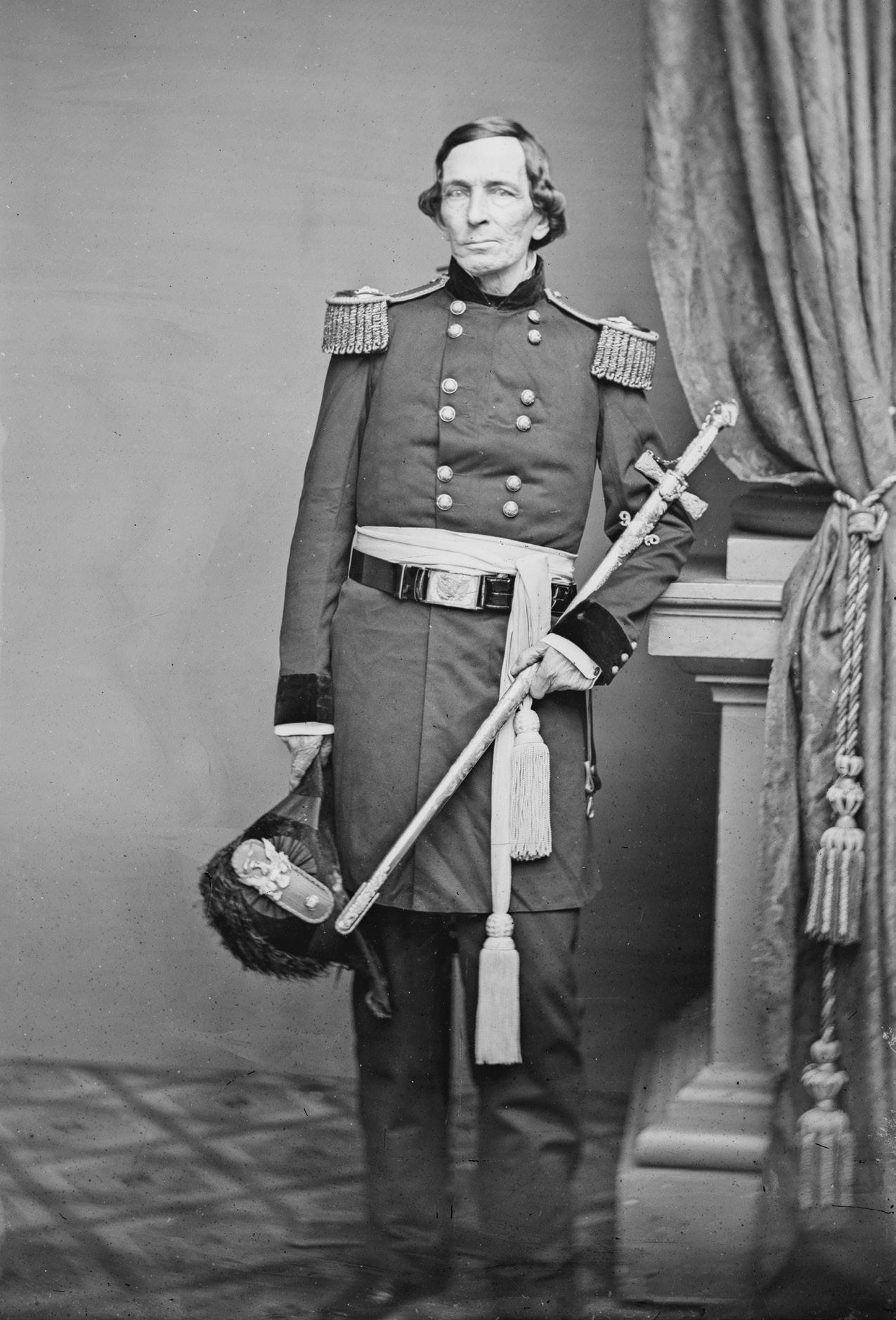

Everyone knows the outcome of the Mexican War, and in retrospect it seems inevitable. Grant’s memoirs, however, remind us that the victory was far from certain. Landing at Veracruz with a force of 10,000 to 12,000 men, Scott undertook “to invade a country with a population of seven or eight millions, a mountainous country affording the greatest possible natural advantages for defence.” Scott was far from help if he got into trouble. The Duke of Wellington, when he heard of the landing and march inland, declared that “Scott is lost…. He cannot fall back upon his base.”
The landing was unopposed; the fortified city was besieged; American artillery was put into place; Veracruz surrendered after a brief bombardment; and Scott headed west.
The next obstacle was at Cerro Gordo, where the forces of Manuel López de Santa Anna held mountain passes with infantry and artillery. Grant wrote that a direct assault was “an impossibility.” Moreover, on the enemy’s flanks were “deep chasms or mountainous walls.” A route around the Mexican left was found, and a road cut, by Robert E. Lee and others in the corps of engineers. These engineers, Grant wrote, were “all officers who attained rank and fame, on
On a much higher level, he pointed out how Taylor, far to the north, contributed to Scott’s success in the south. Taylor’s advance on Buena Vista forced Santa Anna to personally lead troops to face the threat. After the battle he marched his defeated army back over the thousandmile route to face Scott in the mountains at Cerro Gordo. “Had the battle of Buena Vista not been fought Santa Anna would have had time to move leisurely to meet the invader further south and with an army not demoralized or depleted by defeat.”
After Cerro Gordo, Scott’s army moved toward the capital and faced more obstacles created by nature and the Mexican forces. The only approaches to the city were causeways along narrow passages running between several lakes. The brigade of Col. John Garland, to which Grant was attached, moved along one of these causeways, “every inch of which was commanded by the enemy’s artillery and infantry.” The brigade held in place while the bulk of the army moved around the Mexican right flank. This movement followed a road cut through the Pedegral lava field, allowing the army to move closer to the city on roads less well defended.
This flanking maneuver succeeded. In a series of three
quick battles, the American attackers forced the Mexican defenders to retreat. Garland’s brigade moved forward as the Mexicans in their front pulled back. The opposing generals agreed to a truce following these engagements, during which time an American envoy discussed a treaty with Gen. Santa Anna, who, according to Grant, was “practically The Government.”
Violations of the agreement led Scott to declare an end to the truce and commence the final advance to the Mexican capital.
Scott’s Sept. 8 attack at Molina del Rey was a success, but a costly one that achieved little. Here Grant’s memoirs offer one of the rare accounts of his own involvement. He was with the troops which first entered the mill who led a small detachment up a makeshift ladder to a rooftop occupied by a few Mexican soldiers. Upon reaching the roof, Grant found a single private “guarding the prisoners he had surrounded, all by himself.”
On Sept. 12, artillery opened on Chapultepec Castle, which fell to American infantry the next day. The fall of Chapultepec opened the way for the assault on the city’s fortified gates. Grant participated in this advance, leading the effort to flank a troublesome artillery piece blocking the way to the San Cosme gate. He then oversaw the dismantling of a howitzer so that it could be hauled into a church’s belfry. Grant knew enough Spanish to explain to the priest that he, the padre, had no say so in the matter. The piece was reassembled and placed into firing position. “The shots from our little gun dropped in upon the enemy,” Grant wrote, “and created great confusion.”
That night, as the American forces prepared to renew the
attack, Santa Anna evacuated the city. A delegation of citizens informed Scott of Santa Anna’s departure and told him there would be no further resistance. The capital of Mexico was Scott’s to possess and, indeed, to govern.
The army occupied Mexico City and environs while the Treaty of Guadalupe Hidalgo was negotiated. As their duties were not onerous, Grant, by then a brevet captain, and other officers had time for various extra-curricular activities. Grant’s excursions took him to a bullfight, a gigantic volcano, and a vast cavern.
When the treaty was ratified Grant returned home to his newly enlarged country and soon married Julia Dent. He stayed with the army for several years, attaining the rank of captain. He resigned from the army in 1854. His time in civilian life was marked with little success. His fortunes changed in 1861, when (in Chernow’s words) war rescued him “from a dismal record of antebellum business failures.” In June 1861, Grant, commissioned as a colonel, took command of the 21st Illinois Infantry.
His subsequent career is well known.
Gould Hagler is a retired lobbyist living in Dunwoody, Ga. He is a past president of the Atlanta Civil War Round Table and the author of Georgia’s Confederate Monuments: In Honor of a Fallen Nation, published by Mercer University Press in 2014. Hagler speaks frequently on this topic and others related to different aspects of the Civil War and has been a regular contributor to CWN since 2016. His email is gould.hagler@gmail.com.
Gould B. Hagler, Jr.
This unique work contains a complete photographic record of Georgia’s memorials to the Confederacy, a full transcription of the words engraved upon them, and carefully-researched information about the monuments and the organizations which built them. These works of art and their eloquent inscriptions express a nation’s profound grief, praise the soldiers’ bravery and patriotism, and pay homage to the cause for which they fought.
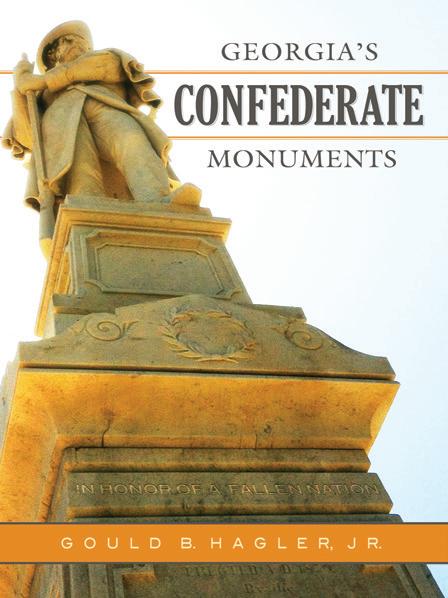
25 October 2023 25 October 2023 CivilWarNews.com CivilWarNews.com
Col. John Garland, 8th US Infantry (Library of Congress)
www.mupress.org 866-895-1472 toll-free
GEORGIA’S CONFEDERATE MONUMENTS In Honor of a Fallen Nation
COLLECTION
Edward A. Cary, Company I, 44th Virginia infantry, in uniform with sister Emma wearing fashion of the day posed for this ambrotype by Charles Rees in Richmond in 1861. Edward was 18 years old when he entered service May 8, 1861, he was killed at the battle of Port Republic June 9, 1862. His beloved little sister was 16 when this photograph was taken. Edward served with his older brother William who was sergeant in same unit and survived the war. Emma Judson Cary Garland (1845–1918) inked an inscription identifying her and brother in back of case late in her life preserving identification of her treasured memento that otherwise would be lost to history. This image was retained in the Garland family and luckily Emma inscribed a note placed in the case identifying her long deceased brother. Rarely did such mementos ever have a written description as they were so personal to the owners only, and rarely did anyone think of identifying them for future generations. Liljenquist Family collection (Library of Congress)
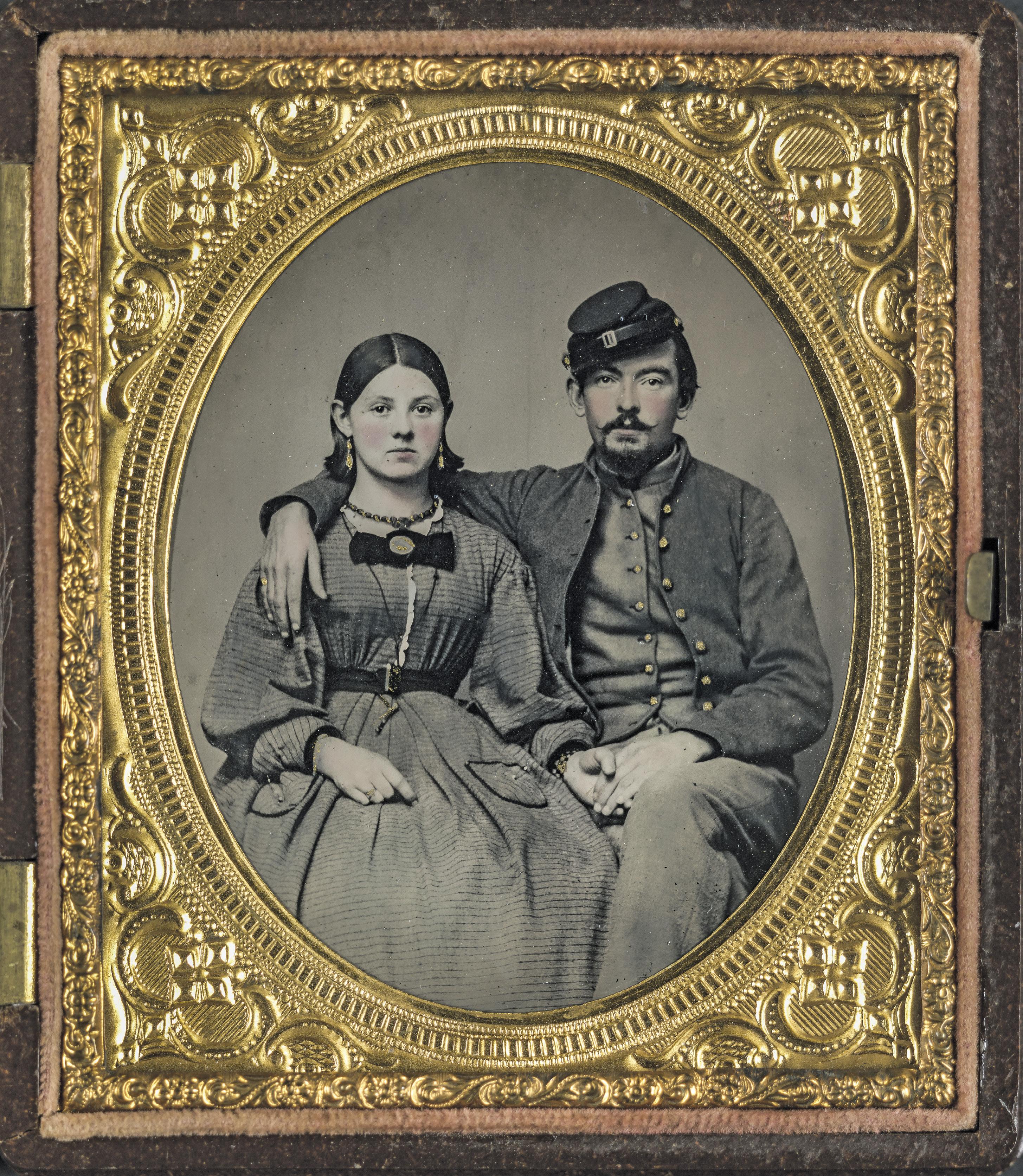
26 CivilWarNews.com October 2023 26 October 2023 CivilWarNews.com




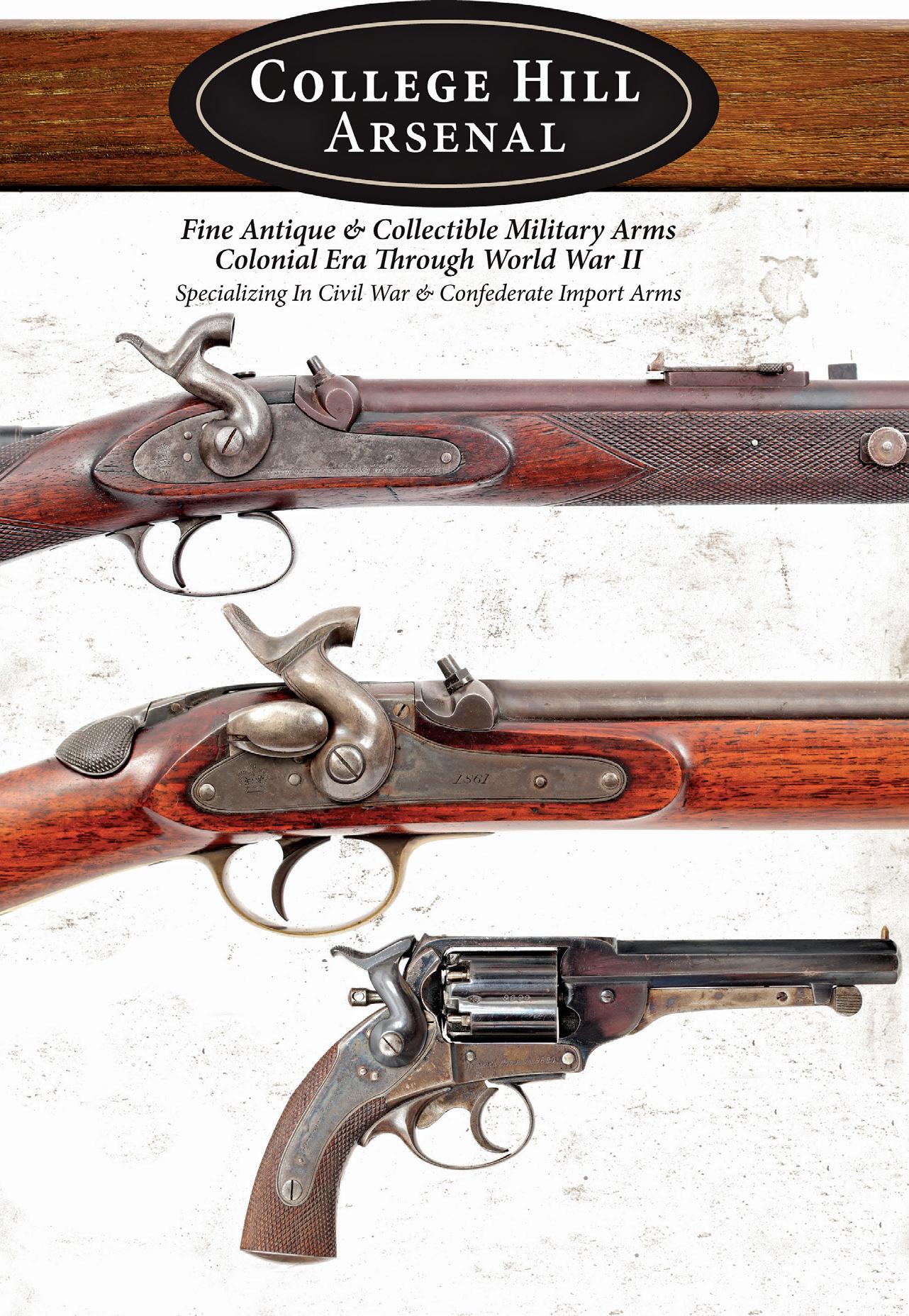


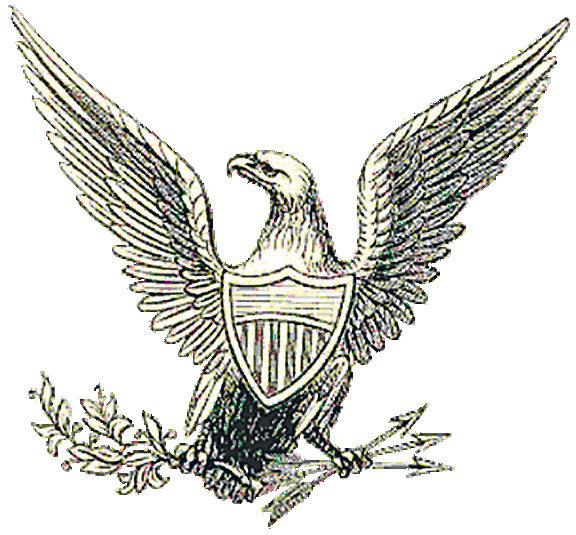
27 October 2023 27 October 2023 CivilWarNews.com CivilWarNews.com Want to Advertise in Civil War News? call 800-777-1862 or email us at ads@civilwarnews.com Visit our website at CivilWarNews.com and it will take you to HistoricalPublicationsLLC.com. The calendar is online and an updated before the print issue. To submit an event send it to: ads@civilwarnews.com www.CollegeHillArsenal.com Tim Prince College Hill Arsenal PO Box 178204 Nashville, TN 37217 615-972-2418 www.CollegeHillArsenal.com 19th CENTURY LIVING HISTORY! James Country MERCANTILE 111 N. Main Liberty, MO 64068 816-781-9473 • FAX 816-781-1470 www.jamescountry.com Ladies – Gentlemen Civilian – Military • Books • Buttons • Fabrics • Music • Patterns • Weapons Mens, Ladies and Children’s • Civilian Clothing • Military Clothing • Military Accessories • Accoutrements Everything needed by the Living Historian! Our Clothing is 100% American Made! The home of HOMESPUN PATTERNS©
Photographers and Lithographers: A Fragile Co-existence Part II
The Graphic War highlights prints and printmakers from the Civil War discussing their meaning and the printmaker or artist’s goals.
Throughout the last half of the 19th century, printmaking and photography shared the stage of image making in America. As we have seen in the Robert E. Lee
iconography, the two technologies worked hand in glove. Sometimes they acknowledged the “collaborative” efforts; other times they merely “appropriated” images available under loose or non-existent copyright rules.
As we have noted in several earlier columns, printmaking before, during, and after the war was dominated by northern engravers, lithographers, and publishers. Foreign printmakers particularly saw an opportunity in the print market. One prominent European player was the Parisian firm of Goupil & Cie.
Founded in 1850, the company specialized in a worldwide trade in original art, reproductions, and art auctions. It quickly grew to include offices and galleries in London, Brussels, Berlin, and America. In conjunction with his business partner, Theodore Vibert, Jean-Baptiste Goupil established a company branch at 289 Broadway in New York City in either 1846 or 1848 (dates are vague and uncertain). Michael Knoedler, a Goupil employee from Baden-Wurttemberg, Germany, was sent to America to open and operate the branch.
Although he eventually bought out Goupil, Knoedler continued to work with the firm.
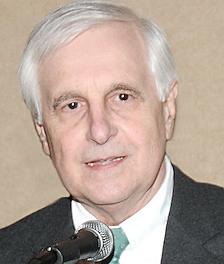
In 1861, they were one of the earliest to produce a Civil War print. Unfortunately, the artist is unknown, but Knoedler and Goupil were listed as the publishers. Entitled Jefferson Davis and his Generals, it is a rare documentation of the brain power of the early Confederacy. (Figure 1). It is also a commentary on the vicissitudes of politics and warfare. Pictured are Jefferson Davis, front and center surrounded by his earliest commanders, “several of whom were soon forgotten.”1
From left to right: Leonidas Polk, John Bankhead Magruder, a General Simmons, George N. Hollins, Ben McCulloch, Davis, Robert E. Lee, P.G.T. Beauregard, Sterling Price, Joseph E. Johnston, and William J. Hardee. As Holzer et. al. revealed, “The likenesses of several of the generals—Johnston, Lee and Hardee…were based on Mexican War era photographs more than a decade out of date.”2
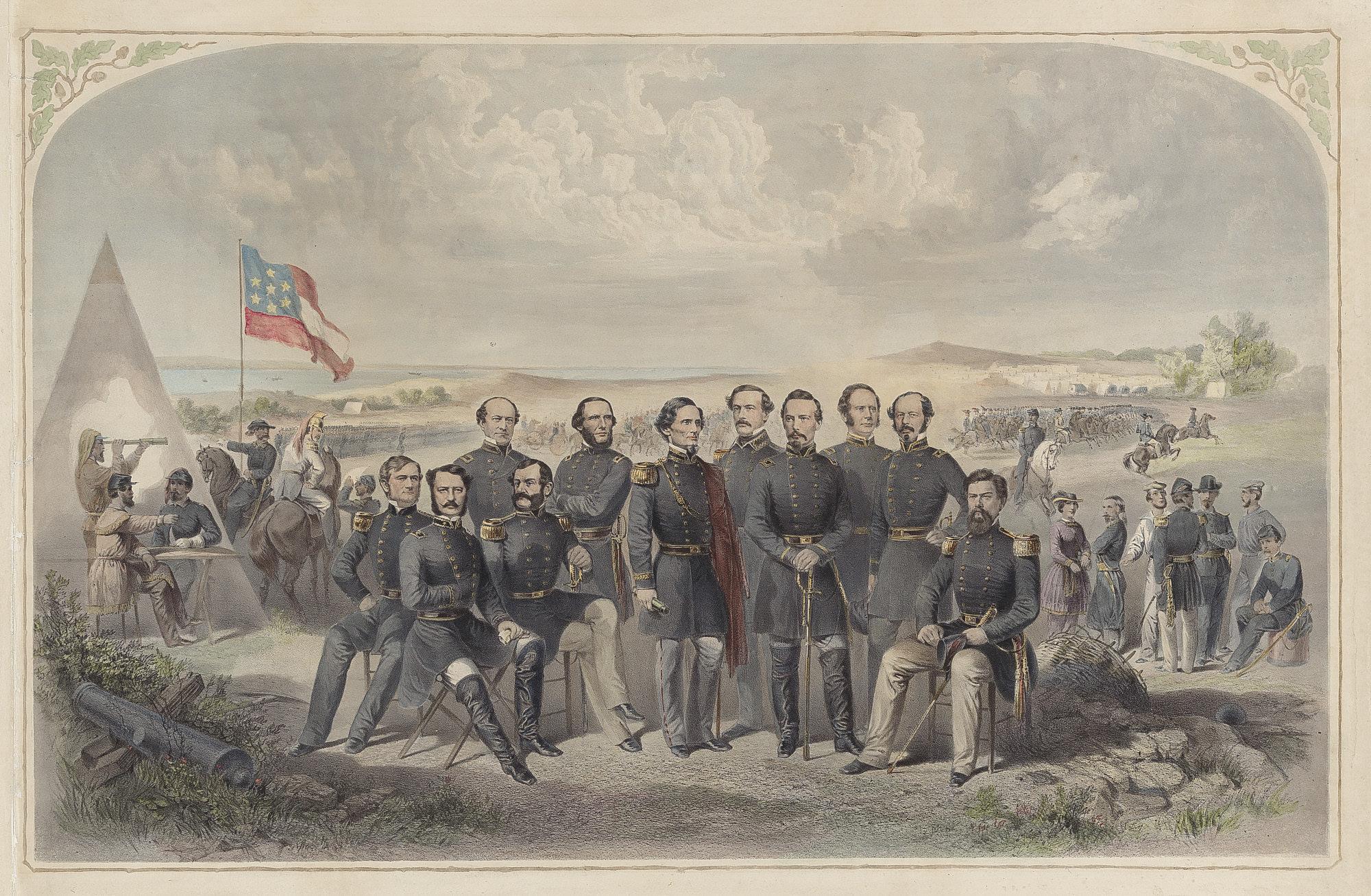
It’s unclear who General Simmons is but he may be South Carolinian James Simons who served “as a brigadier general of
militia commanding on Morris Island during the Fort Sumter bombardment.”3 The National Portrait Gallery, Smithsonian Institution, identifies him as Georgian Thomas Jefferson Simmons (1837–1905).
According to his biography, he saw action in Virginia in A. P. Hill’s Division of Longstreet’s Corps as a colonel from 1862.4 The date of the print may be in error as Lee’s reputation as a “hero” or “leader” was cemented later, after he assumed command of the Army of Northern Virginia following the spring 1862 defense of Richmond. There is no record of Simmons’ promotion to general.
What is most striking about this print and similar other ones is that they resemble a tableau or stage scene. Close examination reveals that it, and those that followed, consists of two major elements. The gathering of heroes in the center front appears to be a set piece plopped into an active scene or scenes of warfare. On the left is the ersatz Confederate flag that seems to resemble the paddle steamer CSS Curlew’s seven star First Naval Ensign.5 It is surrounded with busy officers receiving and dispatching orders.
28 CivilWarNews.com October 2023 28 October 2023 CivilWarNews.com
(Figure 1) Jefferson Davis and His Generals, ca 1861. Goupil Lithography Company, Courtesy, National Portrait Gallery, Smithsonian Institution.
On the right, a cavalry maneuver is executed in the background as staff and other personnel converse in the near foreground. Near the end of the war, Goupil issued a new version of its ca 1861 print. This lithograph, with tinting, featured Robert E. Lee in place of Davis, and included only the best known and most accomplished Southern generals. They are (left to right) Wade Hampton, James E.B.
Stuart, Jubal A. Early, Joseph E. Johnston, John B. Hood, Robert E. Lee, Ambrose P. Hill, Thomas J. Jackson, James Longstreet, P.G.T. Beauregard, and John H. Morgan. It is striking in that it includes Longstreet. These portraits are based on more recent photographs; the central tableau has been replaced by a new one. On the left, the “confederate” flag has been removed and the large tent has been emphasized;
the right background and foreground remain essentially the same. Remarkably, in this black and white edition of Lee and his generals, all are dressed in dark uniforms. In the colored lithograph of Davis and his generals, they are dressed in Federal blue.

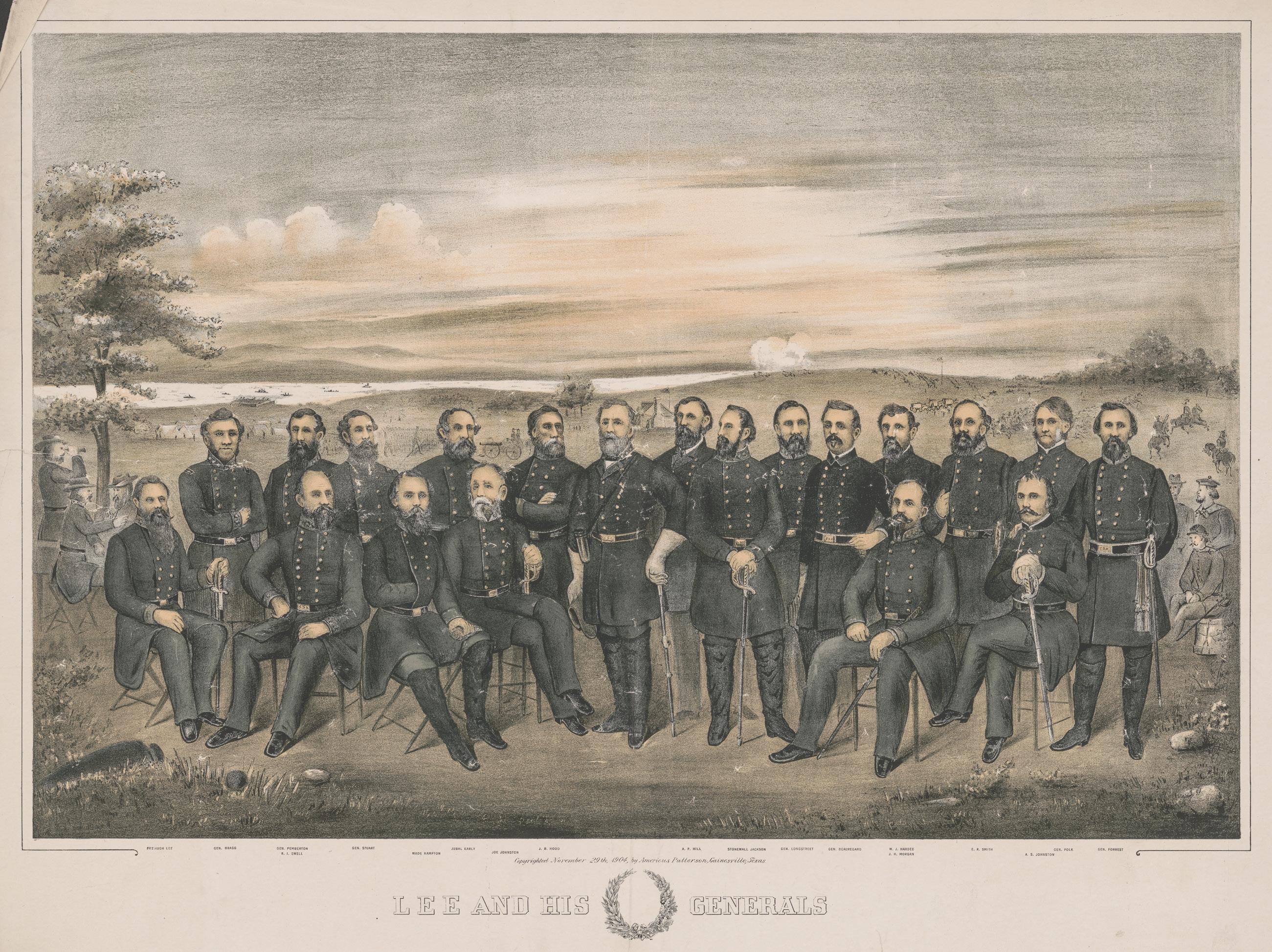
With the war barely over, John Kelly copied earlier Goupil and Knoedler group portraits of Lee and His Generals. They were
issued ca. 1865. (Figure 3). Once again, a tableau shows the Marble Man with 19 of his leading commanders. All the generals are identified in the print’s title margin, except for Lee, who was already immediately recognizable at war’s end. The print includes six who died during the war; J.E.B. Stuart, Stonewall Jackson, A.P. Hill, John Hunt Morgan, Albert Sidney Johnston, and Leonidas Polk. In the landscape, infantry and cavalry regiments are assembled, preparing for battle. An unknown river, perhaps the James, flows in the background. The origin and attribution of this particular image is murky. According to the National Portrait Gallery, this print was designed by John L. Giles a New York artist active from the mid1860s to 1882. He had worked on previous iterations of Lee taken from Minnis and Cowell’s photographs. Lee sports the same pose as earlier photos and prints with the sword in his left hand dropped to the ground. According to the Library of Congress, this print was not produced until 1904 and in Texas by an artist named Americus Patterson; a fact Holzer et. al. call “notable.” They suggest that the portraits are from photographs, however, the facial rendering of every individual is crude and poorly executed; it is
possible none were taken from photographs. Remarkably, all of “Lee’s Lieutenants” are clad in blue uniforms.6 Holzer, et. al. erroneously attribute this print to Thomas Kelly of Philadelphia and New York.7 Thomas Kelly practiced only in New York; John Kelly had establishments in New York and Philadelphia. John Kelly published William Robertson’s Lee and His Generals, which has much more accomplished portraits and lacks the laurel wreath in the title margin. John was known for his Lincoln, Lee, and Davis portraits, and a lithograph depicting the 15th Amendment Print. Thomas Kelly was predominately known for his domestic and horse racing scenes. Historian Harry Peters praised Kelly and his Lee and His Generals for its “very excellent portrait of almost every Confederate leader of major importance.”8
Endnotes:
1. Mark Neely, Harold Holzer, & Gabor Boritt, The Confederate Image: Prints of the Lost Cause, University of North Carolina Press, Chapel Hill, 1987. Plate 2.
2. Ibid.
3. Bruce Allardice, More Generals in Gray, Baton Rouge: LSU Press, 1995, 209.
4. https://prabook.com/ web/thomas_jefferson. simmons/105844.
5. https://en.wikipedia. org/wiki/Flags_of_the_ Confederate_States_of_ America.
6. Ibid., Figure 87 caption, 64.
7. Ibid., 100.
8. Harry Peters, America on Stone, 248. See Plate 118.
After 43 years in the museum field, Cilella devotes his time collecting American prints and maps and writing. His most recent books are Upton’s Regulars: A History of the 121st New York Volunteers in the Civil War (U. P. Kansas, 2009). His two-volume Correspondence of Major General Emory Upton, (U. of Tennessee Press, 2017), received the 2017–2018 American Civil War Museum’s Founders Award for outstanding editing of primary source materials. He has edited Upton’s love letters 1868-70, Till Death Do Us Part: (Oklahoma University Press, 2020). He has edited the Memoirs of Dewitt Clinton Beckwith of Upton’s Regulars (McFarland Press, 2023).
29 October 2023 29 October 2023 CivilWarNews.com CivilWarNews.com
(Figure 3) Lee and His Generals, 1865. J. Kelly & Sons, Courtesy, Library of Congress.
(Figure 2) Robert E. Lee and His Generals, ca 1865. Courtesy, National Museum of American History, Smithsonian Institution.
John Steele, Editor of the Atlanta Intelligencer

When asked by America’s Civil War to write about a littleknown Atlantan, I chose John H. Steele, editor of the Atlanta Daily Intelligencer from March 1863 to his death in January 1871. (The paper folded three months later anyway, victim to the upstart Atlanta Constitution.) Steele is so under-the-radar that after extensive sleuthing, we still don’t know his middle name. (His gravestone in Atlanta’s Oakland Cemetery reads simply, “John H. Steele.”) In early 1864 a fellow newspaperman described
him as “a large, heavy built man, about six feet in height, well proportioned and has a very durable look about him. His head is large and expansive, covered with a great thatch of silver grey.” He was known as a witty raconteur, “inimitable in racy anecdote.” He was therefore in demand at parties, “enjoys the society of the young [and] is popular with ladies.”1
John Steele was a dedicated Confederate propagandist, realizing that a wartime editor’s job was as much to support the cause as it was to report the news. He especially enjoyed vilifying Yankees, whom he characterized as “cerulean abdomens,” possessed of “azure corporations”—highfalutin’ terms for bluebellies, which he regarded as a substandard species of soldiery.
In writing our book, The Atlanta Daily Intelligencer Covers the Civil War (published by the University of Tennessee Press), one of the themes my coauthor Bill Hendrick and I sought to address was how John Steele, an intelligent and thoughtful man, could maintain his hope for Confederate victory until the very end, when the cause was collapsing.

In the ADI of May 7, 1864, for instance, he editorialized at length on Southern prospects: “We hold that the people of the Confederate States,” he intoned, “are the custodians of those great principles for which patriots of all ages have struggled, and for which martyrs have sacrificed
their lives.” Should the enemy somehow prevail and subjugate the South (subjugate was Confederates’ favorite word, meaning put under the yoke) “infidelity, fanaticism in all its hideous forms, licentiousness in all its grossness, and cruelty and rapine, with all their horrors,
will raise their disgusting forms and march boldly throughout our bright and sunny land.”2
It was a chilling prospect, made the more ominous by the manifest signs of a waning war effort, starting with the weakened strength of the armies. At the end of 1863, Adjutant and Inspector
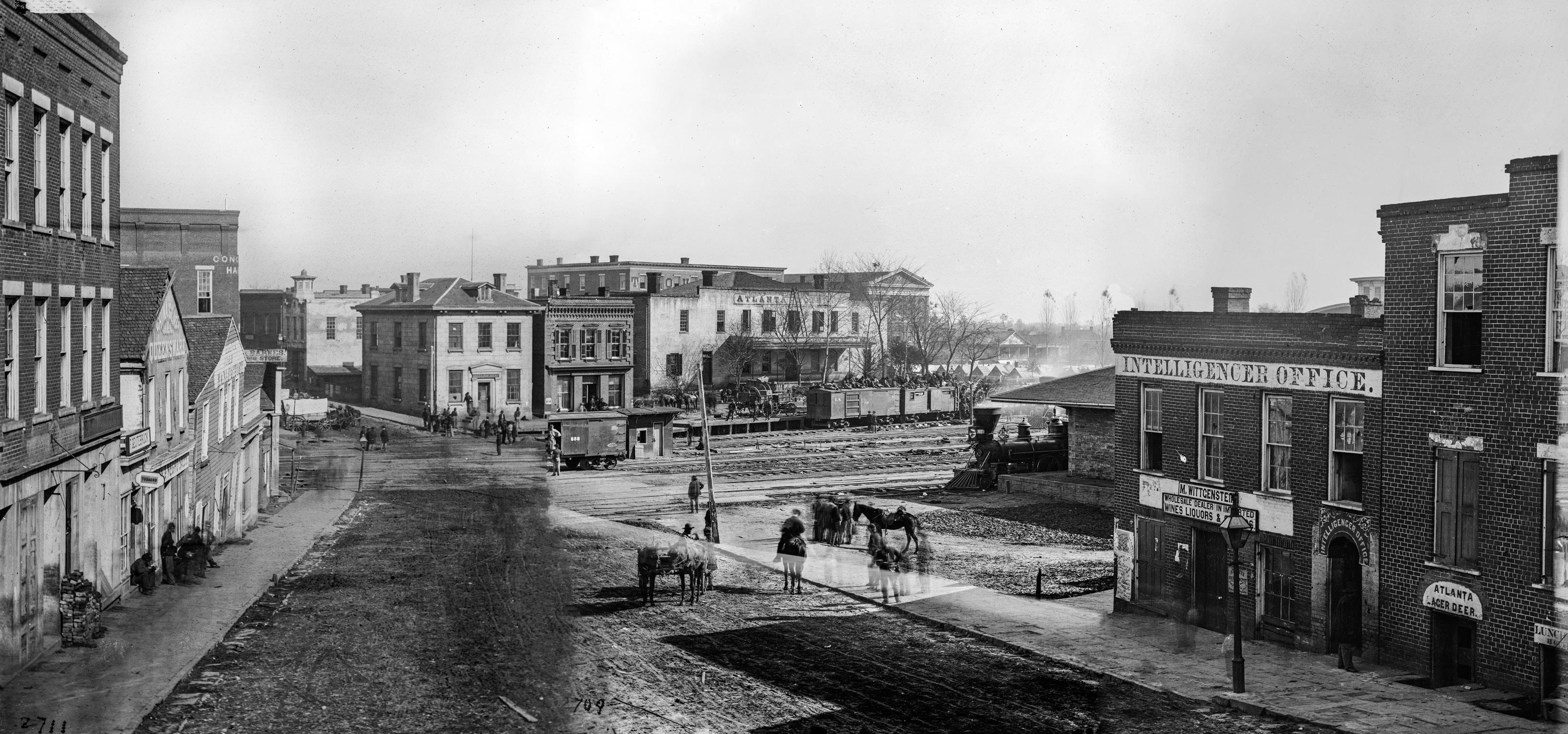
30 CivilWarNews.com October 2023 30 October 2023 CivilWarNews.com
Panoramic view of north end of Whitehall Street, looking across to Peachtree. (Library of Congress)
Intelligencer Office, 1864, by George Barnard, colorized. (Library of Congress)
General Cooper reported to President Davis that he counted 233,586 men present for duty. No one knew the Yankees’ numbers, but they could be guessed as far higher. (They indeed were— 496,783 at the end of ’63.)3
Then there were the casualties. In May 1864 the Intelligencer estimated that during the first two and a half years of war, to September 1863, some 120,000 Confederate soldiers had died of disease, and that just under another 30,000 had been killed— numbers that were well on their way to the estimated 258,000 Confederates who died during the war.4
Loss of territory was another index. At the end of 1863, of the 700,000 square miles of land in the eleven seceded states, perhaps a quarter of it was under Federal control: all of Tennessee, almost all of Arkansas, half of Louisiana, a third of Mississippi and a quarter of Virginia, plus coastal pockets along the entire Southern coast.5
The Confederacy’s travails at the start of 1864 extended from the war front to the home front. Most families were experiencing shortages of essential goods, both agricultural and industrial. Food was being produced in sufficient quantity, but with Southern
railroads worn out or broken by the Yankees, and many Southern rivers under enemy control, distribution of life’s essentials was difficult and uneven.
The Confederacy’s main financial problem was inflation. When goods were available, they were often set at such exorbitant prices as to be unpurchasable. At the start of the war, one could buy a dollar in gold for three Confederate ones. At the end of 1863, one had to pay twenty.6
Vicksburg, Gettysburg, no foreign recognition, Yankee emancipation and slavery’s threatened demise: the list could go on and on. Yet through all of this, John Steele’s gaze was still on peace and Confederate independence. At the time of his writing in early May ’64, the editor exulted in such Confederate victories as Olustee and Mansfield, Forrest’s ride into Paducah, Democratic successes in the North, Yankee soldiers’ unwillingness to re-enlist:
“All of these things indicate, as we think, the beginning of the end of this wicked war, and presage for us a triumphant conclusion of the sanguinary strife.”7
Be of good cheer, then, for though our hearts no doubt
will be made to mourn, in the next few months, for many friends in battle slain, yet, we think it is safe to say, that putting our trust in God for deliverance, we will behold, before another year expires, the rainbow of peace spanning our heaven-blessed land and hear our young men and maidens, and our little ones singing, “This cruel war is over!”
Endnotes:

1. “PRESS ASSOCIATION,” ADI, March 2, 1864.
2. “We are at a loss…” (editorial), ADI, May 7, 1864.
3. Steven H. Newton, Lost for the Cause: The Confederate Army in 1864 (Mason City IA: Savas Publishing, 2000), 1.
4. “LOSSES IN THIS WAR,” ADI, May 4, 1864; Drew Gilpin Faust, This Republic of Suffering: Death and the American Civil War (New York: Alfred A. Knopf, 2008), 257.
5. Charles H. Wesley, The Collapse of the Confederacy (Columbia: University of South Carolina Press, 2001 [1937]), 37; Henry Steele Commager, ed., The Defeat of the Confederacy (Princeton NJ: D. Van Nostrand, 1964), 142.
6. Albert D. Kirwan, ed., The Confederacy (Cleveland: World Publishing Co., 1959), 129; Clifford Dowdey, The Land They Fought For: The Story of the South as the Confederacy 1832-1865 (Garden City NY: Doubleday, 1955), 303.
7. “We are at a loss…,” ADI, May .
Stephen Davis, of Cumming, Ga., is a longtime student of Confederate journalism. His book, The Atlanta Daily
Intelligencer Covers the Civil War, with Bill Hendrick, is one of the few that treats a single Southern wartime newspaper. He has also edited the wartime and postwar journals of Eliza Frances Andrews, who began writing her diary in December 1864 at the age of 24. Today, when evidence of Confederate patriotism is being quashed by the national culture, Miss Andrews’ writings stand out spectacularly.
Eliza Frances Andrews (1840–1931) received a strong education and was a successful writer and educator. Her War-Time Journal of a Georgia Girl surely ranks among the most observant and intelligent wartime memoirs by a Southern woman.
Edited with commentary by Stephen Davis, I Thank the Lord I Am Not a Yankee includes selections of her wartime and postwar journals which are most expressive of her Confederate patriotism and Southern pride.
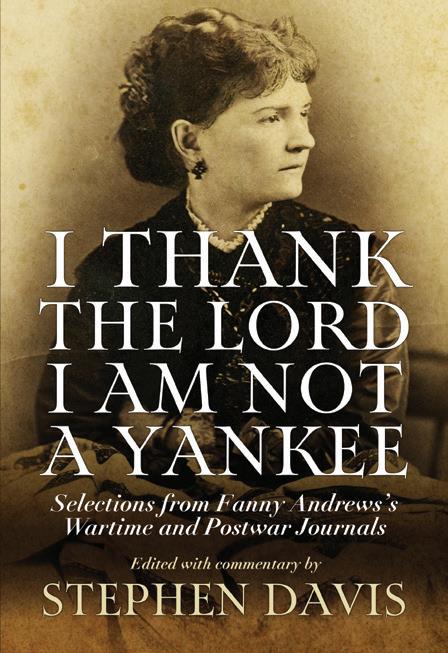
February 2023 • $35.00, hardback
Stephen Davis is author of ten books on the Civil War, most of which treat the Atlanta Campaign. His two recent volumes on Confederate General John Bell Hood have won several prizes, including the Fletcher Pratt Award of the New York CWRT.
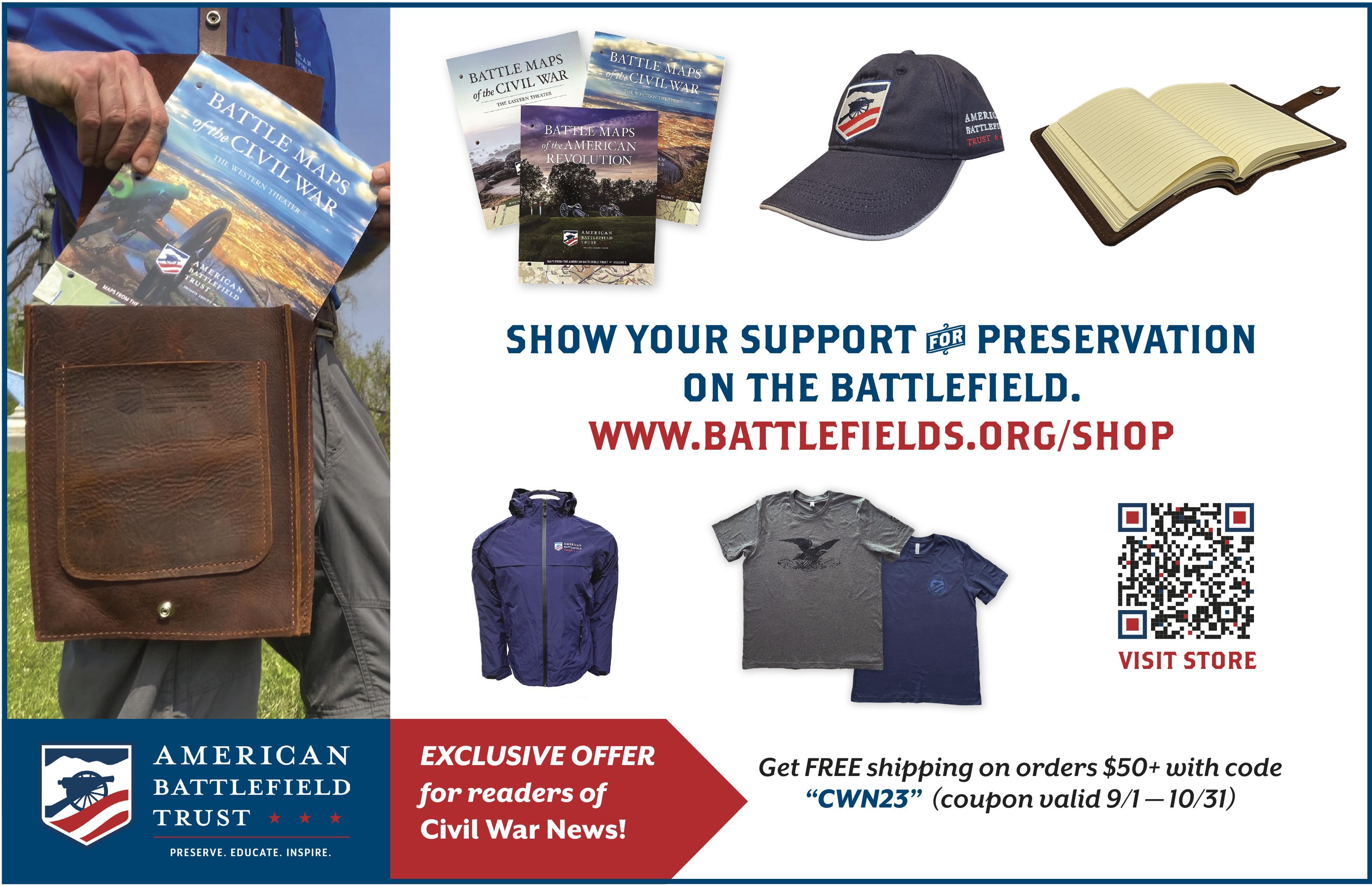
www.mupress.org
866-895-1472 toll-free www.mupress.org
31 October 2023 31 October 2023 CivilWarNews.com CivilWarNews.com
“I Thank the Lord I Am Not a Yankee...”
www.emergingcivilwar.com
From the Editor
Since the summer of 2011, I’ve had the privilege to serve as Emerging Civil War’s editor in chief, which has really just been a fancy title for “chief cook and bottle washer.” In my role as editor, it has been gratifying to help so many other historians, so many emerging voices—find their footing in the public history field. When we founded ECW, we wanted to provide a platform for new writers to share their ideas, practice their writing skills, and build their name recognition. Along the way, ECW has become a wonderful community that includes a great mix of writers and readers with a wide variety of backgrounds. Being part of that community invigorates me. It does take up a great deal of time, too, time I don’t get to spend at my writing desk. Ever since I was a kid, I wanted to grow up to be a writer. I still do! As editor in chief, I devote much of my time to helping other writers achieve their own writing goals, which is something that
has been especially gratifying about my work. But I do admit, I have been feeling a stronger and stronger itch lately to focus a bit more on my own writing, at least for a while.
At our Ninth Annual Emerging Civil War Symposium at Stevenson Ridge in early August, I announced that I will be stepping down as editor in chief at the end of my current term in October. I shared this decision with my ECW colleagues a few months ago, and we have been quietly preparing for the transition. Our managing editor, Sarah Kay Bierle, will be stepping up to fill the role of editor in chief so that I can devote more of my time to my own writing.
Sarah has been with ECW since 2015. As managing editor, she has served as my right hand, overseeing the day-to-day operations of the blog. She likes to think of herself as the Sherman to my Grant, but now it’ll be her turn to be Grant while I go write some books.
I don’t intend to go far, and I won’t completely vanish. Rather, I’ll just sort of hang around as ECW’s “Grand Old Man,” which mostly means telling stories from “back in the day” and telling young kids to stay off ECW’s lawn. I still have the Emerging Civil War book series to manage, and I’ll keep podcasting. But I also have four or five book ideas I’ve been carrying on my back for four or five years, that I’ve been unable to write because of my other duties. I have complete confidence in Sarah‘s ability to take on those duties.
In the meantime, please wish me well as I settle in to write!
— Chris Mackowski, Ph.D. Editor-in-Chief
2023 Symposium
On August 4-6, the 9th Annual Emerging Civil War Symposium
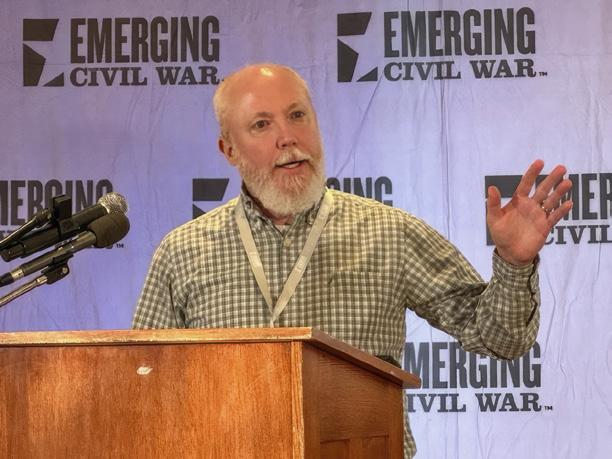

took place at Stevenson Ridge in Spotsylvania, Virginia. We were thrilled to welcome nearly 180 people to the event as we explored the theme “1863: The Great Task Before Us.”
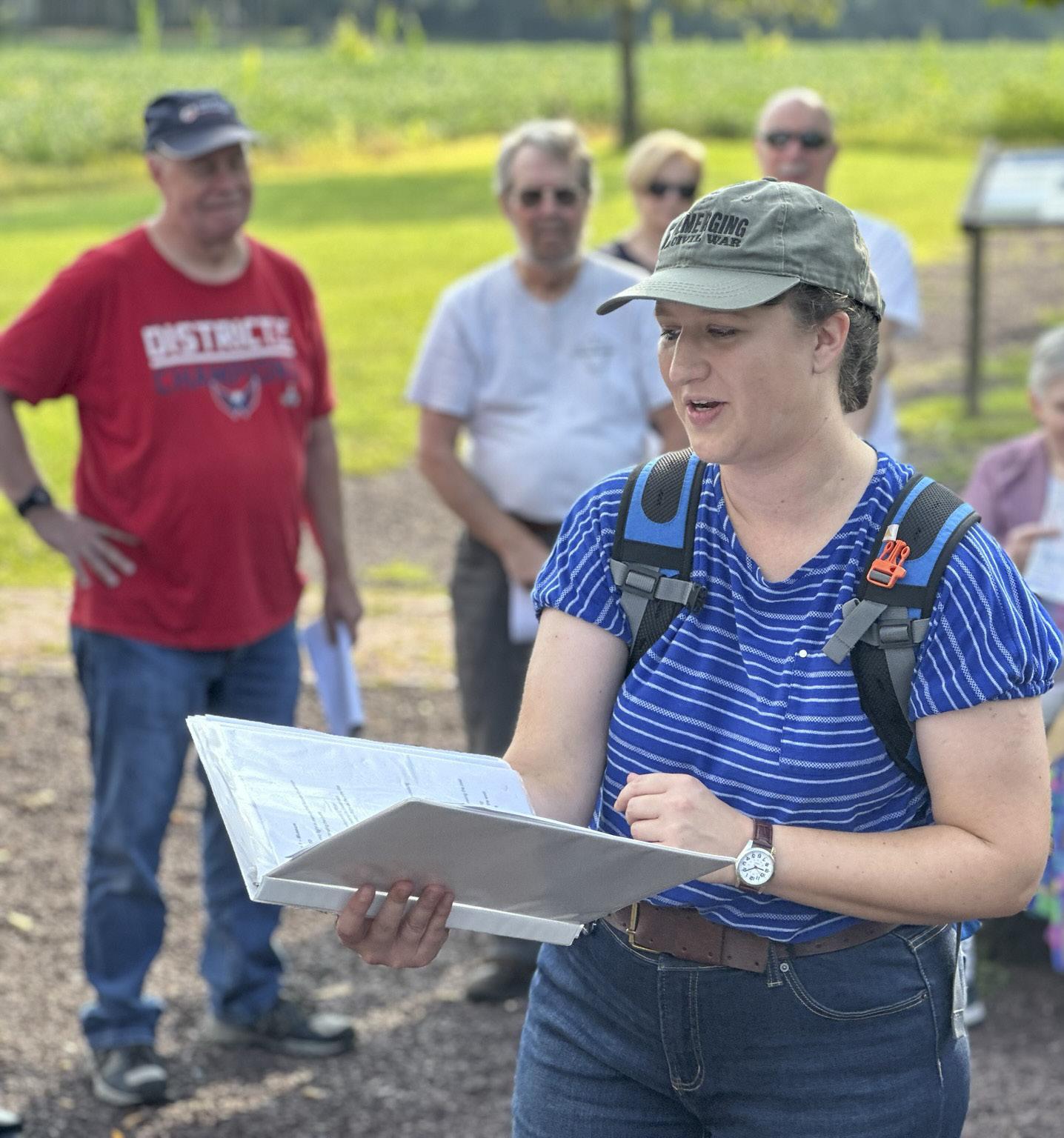
Check out the synopsis of the event and a few of our favorite photos from the weekend: https://emergingcivilwar. com/2023/08/09/symposiumspotlight-2023-photos/.

2023 Emerging Civil War Awards
Each year, Emerging Civil War is proud to present several awards to those who are making a difference in the public history field. We invite you to explore the press releases to learn about each of the awards and this year’s
recipients! Congratulations to all and thank you.
ECW Honors Civil War Trails for Work in Public History https://emergingcivilwar. com/2023/08/07/ecw-honorscivil-war-trails-for-work-inpublic-history/.
ECW Honors Newsome’s Gettysburg’s Southern Front with 2023 Book Award https://emergingcivilwar. com/2023/08/08/ecw-honorsnewsomes-gettysburgs-southernfront-with-2023-book-award/.
ECW Honors Childress Agency with Stevenson Award https://emergingcivilwar. com/2023/08/10/ecw-honorschildress-agency-withstevenson-award/.
ECW Honors Chris Heisey with Upton Award https://emergingcivilwar. com/2023/08/11/ecw-honorschris-heisey-with-upton-award/.
Notes & News
Brian Swartz spoke about his book, Passing Through the Fire, during the Civil War Weekend held July 22-23 at Fort Knox State Park in Prospect, Maine.
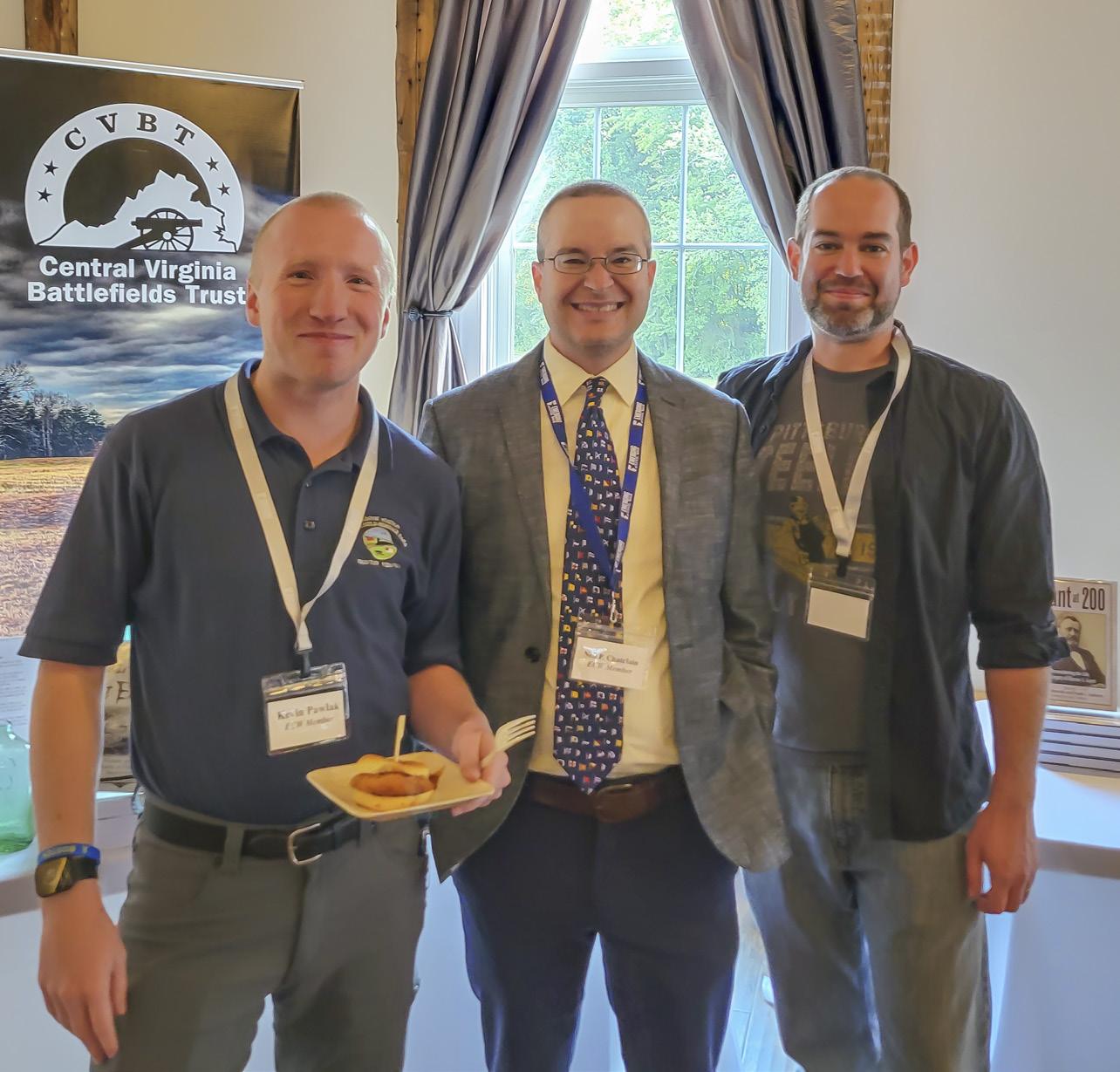
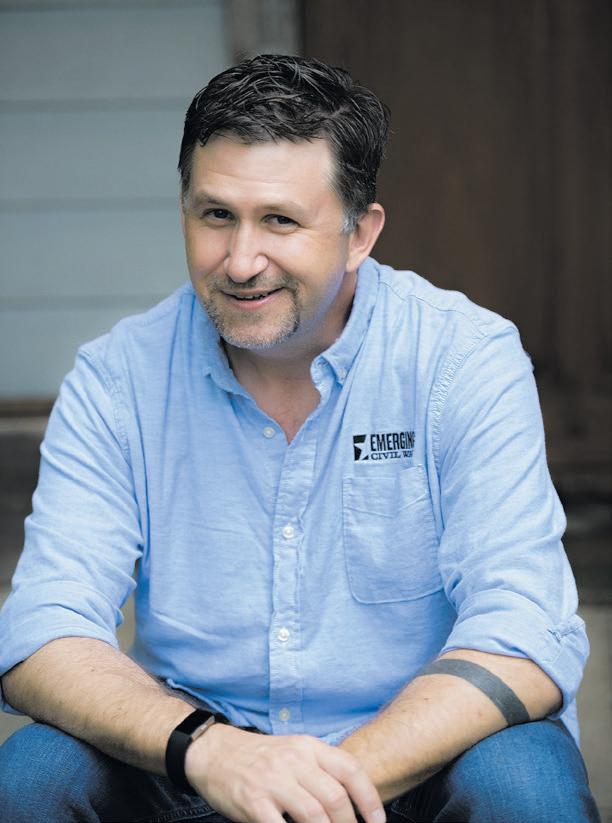
Earlier in August, Chris Kolakowski finished nearfinal proofing and indexing for my next book, Tenth Army Commander: The Writings of Simon Bolivar Buckner Jr., 194445, which brings nearly home a research and writing process that started about five years ago. It is a pleasure and privilege to bring out this too-long-silent voice in the Pacific War. The book is coming out this fall, and is available for pre-order at Casemate Publishers (casematepublishers.com or casematepublishers.co.uk).
Brian Matthew Jordan recorded two interviews for The Civil War Regiments podcast. They are now available on Spotify. His latest book (co-edited with Jonathan W. White), Final Resting Places: Reflections on the Meaning of Civil War Graves, is set to release on September 1. He looks forward to seeing old friends and making new ones at the Savas Beatie author meet up next month.
Frank Jastrzembski recently helped to place a governmentissued veteran headstone at Colonel Peter Edward Bland’s unmarked grave. Read more about it here: https://emergingcivilwar. com/2023/08/17/colonel-peteredward-blands-grave-receives-aheadstone/.
Bert Dunkerly and Caroline Davis are excited about the release of their book, Force of a Cyclone, about the battle of Stones River. Bert has also recently completed his explorations of the Braddock

32 CivilWarNews.com October 2023 32 October 2023 CivilWarNews.com
Chris Mackowski
At the ECW Symposium, Sarah Kay Bierle presented Chris Mackowski with the first of what Chris hopes will be many books in the years ahead.
(L-R) Tim Smith, Chris Kolakowski, Tim Talbott, Cecily Nelson Zander, and Robert Dunkerly spoke about 1863 history during an ECW Symposium Panel Discussion.
Timothy B. Smith (of the West) was the Keynote Speaker at the 2023 ECW Symposium.
Sarah Kay Bierle (pictured) and Daniel T. Davis co-led a Symposium Tour at the First Day At Chancellorsville Battlefield.
(L-R) ECW Members Kevin Pawlak, Neil P. Chatelain, and Patrick KellyFischer at the 2023 Symposium.
and Forbes Roads in western Pennsylvania, for his upcoming book on the French and Indian War (History Press). He was fortunate enough to not run into Jon Erik or any Browns fans.
Doug Crenshaw will be giving a virtual talk top the American Civil War Center on August 29, and has led a number of private tours of Cold Harbor and the Seven Days in recent weeks.
Neil Chatelain had a blast speaking at and seeing the ECW community at the ECW Symposium! It is now back to teaching, with classes already back in session.
Sarah Kay Bierle spoke at the Rohrbach Inn Lecture Series in Sharpsburg, Maryland, on August 16, sharing about John Pelham’s five years at West Point.
Newsletter Exclusive Interview
Moe the Border Collie is one of ECW’s youngest contributors and resides with Chief Historian Cecily Nelson Zander. At 3 and 1/2 years old he is well on his way to becoming one of the top canine historians of the Civil War Era, if he doesn’t keep getting distracted by his need to play fetch 24/7. He was adopted from a Border Collie rescue organization in Fort Worth, Texas, after a rough and tumble start to life in Louisiana and Mississippi. He knows that lots of people think historians like cats, but after spending some time with the good folks at ECW, he’s pretty sure they like dogs, too.
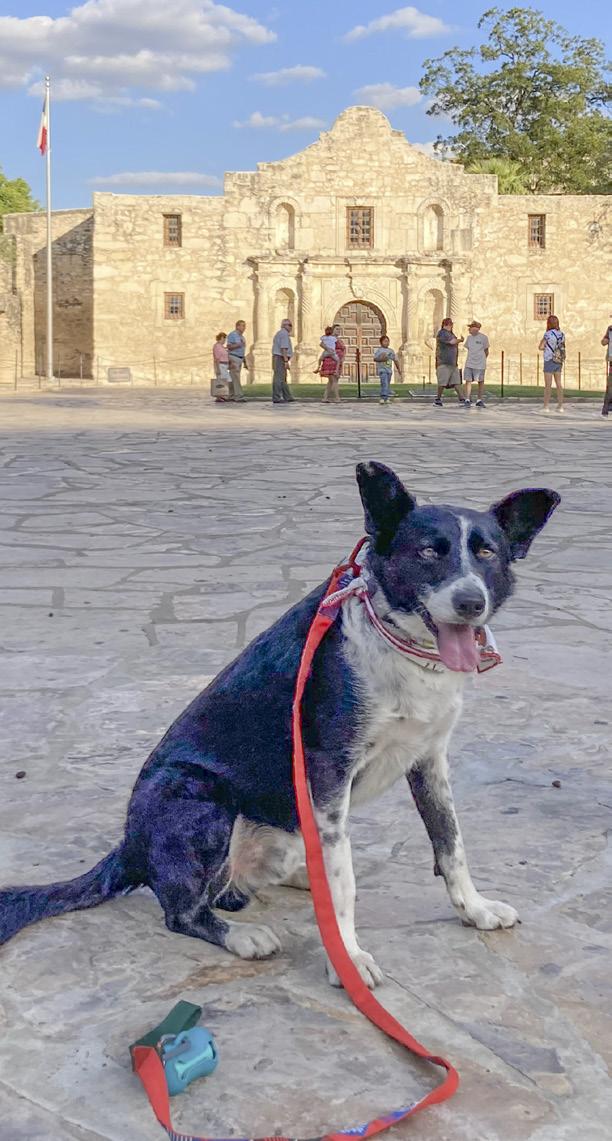
that nobody got lost. But I think the late-night trip to Carl’s Frozen Custard on Saturday with Sarah B., Jon T., and Pat K-F. might have been my favorite thing of all!
2. How many battlefields have you visited?
I got to visit three new battlefields on this trip, Parker’s Crossroads, Chancellorsville, and Antietam! Before that I had only visited a few closer to home, Glorieta Pass, for the Civil War; and I have been to the Alamo twice, like any good Texan Border Collie should. I like that they named that one after me! My mom says many more are in my future, with Shiloh, Chattanooga, and Gettysburg at the top of the list.
I also got to visit Fort Laramie, Wy., for the 4th of July this year. They fired off one of these cannon I keep seeing everywhere, and I did not like it one bit. Porter Alexander and I would not have been Civil War buddies.
3. If you could “play ball” at any historic site, where would that be? Why?
I think I would like it to be somewhere close to water, because I also love to swim. So maybe I would choose Charleston, for the history and the beaches. Maybe I’ll get to see some of these “cannon balls” I keep hearing about. They must be great for fetch.
4. Moment of Truth. Do you eavesdrop during the ECW Board Meetings?
I do, but only to find out if anyone on the board has “dropped the ball” so that I can go fetch it. So far, nobody has, but I’m patient!
5. Do you have a favorite ECW book at the moment?
I very carefully inspect each new ECW book when it arrives at my house to make sure the history smells as good as it looks; but I would say my favorite is
The Great “What Ifs” of the American Civil War. I’d love to see an ECW book about animals, but I don’t have the thumbs to write it.
6. Would you like to meet Kenya? (Ted Savas’s pup) I would really like to smoke some puppy cigars with Kenya and discuss what our pet parents are doing typing on those boxes all day long.
7. What are you looking forward to with ECW in the next 12 months?
I have overheard some talk about planning the 2024 symposium, and am hoping I will be chosen to lead a battlefield tour this time around; I know where to find all the best battlefield smells and always walk right into the poison ivy. I will also happily continue to interrupt board meetings by squeaking my toys as loudly as possible in the background!
8. What history dog would you like to time travel and meet?
I have lots of family in North Dakota who want me to come visit, and I think the most famous dog to go there (so far) was Seaman the Newfoundland, who accompanied Meriwhether Lewis and the Corps of Discovery on their journey to the Pacific Ocean; so I would meet Seaman!

Lightning Rounds:
Favorite treat?
A Dairy Queen Pup Cup or a crunchy salmon skin, which my mom says smells so good.
Favorite toy?
My top three would be:
1. ball; 2. ball; 3. ball
Favorite historian to visit?
I made so many new historian friends at the symposium and I can’t wait to visit them again. I have also visited Dr. Gary W. Gallagher a few times and he gives me the best ear scratches in the world!
ECW Bookshelf
The Emerging Civil War 10th Anniversary Series has two new titles that are hot off the press from Savas Beatie.
Fallen Leaders, a new volume in the Emerging Civil War 10th Anniversary Series, explores the lives and deaths of Civil War commanders.
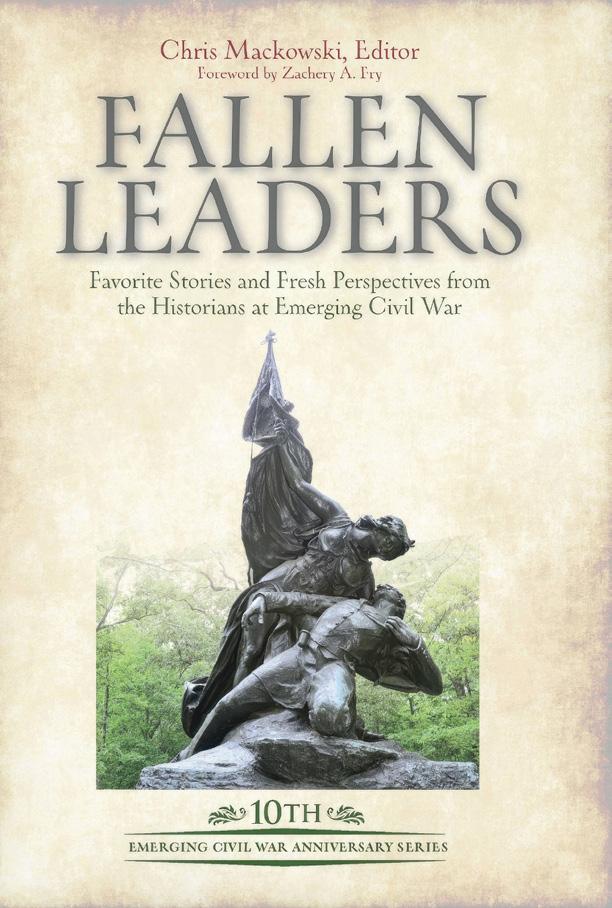
The second, The Civil War and Pop Culture, was co-edited by Mackowski and Jon Tracey. The pair worked together on last year’s Civil War Monuments and Memory, and the new pop culture book serves as a companion volume to that earlier volume. Twenty-seven authors contributed dozens of pieces about favorite movies, novels, TV shows, war games, and more. Read more here: https://emergingcivilwar. com/2023/08/02/the-ecw10series-the-civil-war-and-popculture/.
Symposium Videos Available Soon!
If you missed the 2023 ECW Symposium or want to re-watch a presentation? Saturday’s lectures will soon be available on our Patreon account, sign up today! https://www.patreon.com/ emergingcivilwar.
Battlefield Walking Tour is a Fundraiser for Wreaths Across America

Emerging Civil War is pleased to host its 2nd Annual Fundraiser to benefit Wreaths Across America at Winchester National Cemetery. On Sunday, October 1, 2023, at 2pm to 4pm, ECW Historians Sarah Kay Bierle and Jon Tracey will lead a walking tour at New Market Battlefield. Partnering with the Virginia Museum of the Civil War and New Market Battlefield State Historical Park, this tour will explore key portions of the fighting ground, the battle fought on May 15, 1864, the burials of the fallen, and stories of Union soldiers who fought at New Market and are now interred in Winchester National Cemetery. For more information, please visit: https://emergingcivilwar. com/ecw_event/2023-wreaths/
1. What was your favorite part of your first ECW Symposium?
Getting to help set up at Stevenson Ridge was really fun, mainly because I found a new friend in Maxwell Mackowski, who helped me record more than 40,000 steps on Friday (according to my puppy pedometer). The Sunday battlefield tour was also lots of fun—I got to practice herding all of our attendees so
The first, Fallen Leaders, edited by Chris Mackowski, was inspired by our 2021 Emerging Civil War Symposium at Stevenson Ridge. We interpreted the definition of “fallen” broadly, so it covered leaders who were killed and wounded but also those who “fell from grace.” The book includes 49 contributions by 29 authors and a great foreword by Dr. Zachary Fry. Edward Alexander and Hal Jespersen both contributed maps. Read more here: https://emergingcivilwar. com/2023/07/26/ ecw10-series-fallen-leaders/.
The Civil War & Pop Culture is one of the newest books in the Emerging Civil War 10th Anniversary Series.
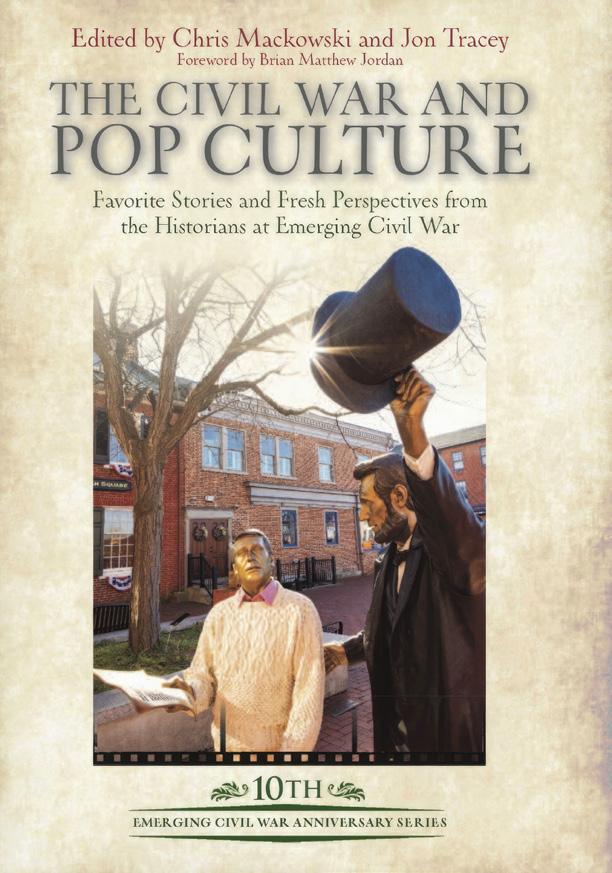
33 October 2023 33 October 2023 CivilWarNews.com CivilWarNews.com
Publishers/Authors Send your book(s) for review to: Civil War News 2800 Scenic Dr, Suite 4-304 Blue Ridge, GA 30513 Subscribe online at CivilWarNews.com
Moe the Border Collie is known for exploring historic sites and inspecting new books!
Emerging Civil War’s fundraiser battlefield tour will support Wreaths Across America.
Civil War News book reviews provide our readers with timely analysis of the latest and most significant Civil War research and scholarship. Contact email: BookReviews@CivilWarNews.com.


Attempts to Redress Weaknesses in Modern Scholarship
More Than Just Grit: Civil War Leadership, Logistics, and Teamwork in the West, 1862, by Richard J. Zimmermann, McFarland & Company Publishers. https:// mcfarlandbooks.com. 2023. 217 pages, 84 photos. Notes, Bibliography, Index. Softcover. $39.95.

Reviewed by John Fowler
leader must master. Likewise, historians, at least those with a clear understanding of military operations and leadership, have made similar statements. Due to two prevailing trends, this truism is lost on most professional historians, even those specializing in the American Civil War and other conflicts.
First, modern scholarship on conflicts such as the Civil War has, over the past decades, moved away from examining combat operations to focus more and more on social and cultural aspects. While social and cultural history is important, it is surely no more important than military history. Second, many historians now choose to produce hagiographical tributes to their favorite generals without fully understanding exactly how military organizations function and without fully acknowledging the need for objective standards by which leadership can be measured.
Zimmermann is in good company with his inquiry. Historian Richard McMurry’s influential Two Great Rebel Armies: An Essay in Confederate Military History (Chapel Hill: University of North Carolina Press, 1996) addressed the issue a quarter century ago.
For McMurry, the central reason behind the Army of Northern Virginia’s success compared with the primary Confederate army in the West, the Army of Tennessee, came down to leadership. The Army of Northern Virginia was stocked with graduates of the U.S. Military Academy, the Citadel, the Virginia Military Institute, and other smaller military schools. Lee, his corps and division commanders, and even the regimental commanders had learned to lead from the best. This thesis has long held sway with Civil War historians. While other factors contributed to the differences between these two primary Confederate armies, leadership is the fundamental one that separated the two.
introduction by Zimmermann, in which he details his thesis and methodology. He correctly surmises that “the idea of singular or solo leadership does not adequately describe the complexities of the art of command during the Civil War. Staff effectiveness, subordinate performance, and logistical expertise must all be considered when determining the ability of an army commander to succeed in combat.” (page 4) For Zimmermann, the art of military leadership is a dichotomy between the individual skill of the commanding general and his relationship with subordinates and staff. He goes on to postulate that the six qualities he mentioned in the preface are the keys to understanding the true quality of military leaders and explaining why the Union was more successful during the 1862 Western campaigns.
attributes such as determination and grit need to be removed from the conversation and analysis and replaced with measurable qualities that will allow an accurate analysis of ability. There are weak points in his examination, such as no tie-in to the U.S. military’s principles of war developed by Carl von Clausewitz. Although he mentions the principles, he does not use them. The principle of security alone would have demonstrated weaknesses in Civil War leaders such as Major General Ulysses S. Grant, who was badly surprised at both Fort Donelson and Shiloh. Still, these are minor quibbles. Zimmermann chose not to include the principles and focused instead on his own interpretation and formula, which I believe is an outstanding achievement.
In a November 11, 1979, interview for the San Diego Union, Marine Corps General Robert H. Barrow repeated the famous quote, “Amateurs talk about strategy and tactics. Professionals talk about logistics and sustainability in warfare.” In other words, there are more significant issues than troop movements and plans of attack that a successful combat
In essence, Robert J. Zimmermann’s More Than Just Grit attempts to redress these weaknesses in modern scholarship and produce a more objective and comprehensive analysis of leadership. In some sense, Zimmermann seeks an explanation for why Robert E. Lee’s Army of Northern Virginia succeeded in the Eastern Theater while Southern generals in the Western Theater did not.
Zimmermann wishes to add to this interpretation by analyzing those factors that made for a great leader. Nevertheless, he focuses solely on the Western Theater and covers both Union and Confederate leadership. He sought the “observable elements” of leadership with the hopes of discerning a pattern. He believes he has found it. He states, “This book suggests that victorious generals were (1) able to achieve attainable objectives, (2) successful in seizing the initiative at the close of the action, (3) sustained by their lieutenants, (4) reinforced by a competent staff that effectively supervised logistical support, (5) skilled at committing all their resources in a timely fashion, and (6) achieved true strategic success by the end of the campaign.” (page 2)
Zimmermann examined the strategic and operational decisions made by Confederate and Union commanders in what he deems the crucial year of 1862. He found that Union commanders won nine of the twelve consequential actions in the Western Theater that year. He states: “This was not an accident, nor was it the simple result of bringing superior forces to bear, but rather the outcome resulting from more effective Northern leadership on and off the battlefield.” (page 3) He posits that the contending forces in the West were near parity in terms of resources. Thus, only poor Confederate leadership propelled the Union to victory more often than not.
The book has an excellent
Zimmermann then delves into each of these elements in greater detail. Finally, he explains that each chapter will cover a particular campaign/battle that he has chosen and will be divided into three parts consisting of an introduction that sets the stage, the engagement’s narrative, and an analysis of how the six factors influenced the battle’s outcome. The final chapter is a summation of the principles and his answer to the question of what observable elements of leadership lead to victory or defeat.
The campaigns and battles covered included Mill Springs, Fort Henrys and Donelson, Pea Ridge, early fighting along the Mississippi River, Shiloh, Richmond (Kentucky), Perryville, Corinth, Prairie Grove, and Stones River. For Zimmermann, it is clear that the generals who integrated all six of the key elements realized decisive victories, while partial achievement resulted in partial victories, and failure to achieve any of the elements resulted in defeat.
Has Zimmermann found the objective formula by which leadership can be measured? Not entirely, but this is a giant leap in the right direction. Zimmermann is totally correct that non-measurable
Overall, his analysis is solid, his methodology is sound, his organization is excellent, and his writing is clear and forceful. This book is an important work for the Civil War and military history in general. While one may disagree with his formula and want to tinker or replace it, the fact that he has offered an honest, objective, concrete methodology for measuring military success is critical to professional history. The military uses objective methodology to train its leaders through a host of training manuals, classes, and field exercises. A military professional knows what a good leader is. Unfortunately, many historians do not. They rely on personal biases, self-serving period memoirs, and modern social and cultural sensibilities to make determinations that should and must be objectively measured. Zimmermann’s work hopefully will find a broad audience because it is a muchneeded call for a redress of Civil War scholarship and focus.
John D. Fowler, Ph.D., is the author of several books and articles on the Civil War Era. He is the author of Breaking the Heartland: The Civil War in Georgia. He is currently a Professor of History at Dalton State College.
34 CivilWarNews.com October 2023 34 October 2023 CivilWarNews.com Publishers/Authors Send your book(s) for review to: Civil War News 2800 Scenic Dr, Suite 4 PMB 304 Blue Ridge, GA 30513 bookreviews@civilwarnews.com
Everything You Always Wanted to Know about Mary Lincoln
Mary Lincoln Demystified: Frequently Asked Questions about Abraham’s Wife. Donna D. McCreary. 366 pp., 2022. Southern Illinois University Press, http://siupress.siu.edu. Softcover. $26.95

Reviewed by Salvatore G. Cilella

lecturer, and performer; this book is a culmination her myriad experiences and talents. Her many enthusiastic audiences prompted her to put pen to paper and lay out in pristine detail everything she could discover about the wife of the 16th president.
McCreary’s knowledge of Mary Lincoln is encyclopedic and deep. The question of Mary’s sanity is covered extensively, encompassing an entire chapter. As sad as her night of horror April 14, 1865 was, her ordeal with her perceived mental issues was equally tragic. She couldn’t understand why her surviving son Robert would label her a lunatic and have her committed to an institution. Was she insane? McCreary comes down on the side of “perhaps” and “perhaps not.” Critics and authors have speculated that Mary suffered from everything from PTSD to syphilis. (138)
The Authenticity of Battle
evening was a political and historical earthquake, “For Mary, it was about the changes in her family, the destruction of her life. She lost her comforter, her lover, her husband, her all.” (110)
The Roads of War. By John Cameron. TouchPoint Press, https://touchpointpress. com/bookstore. 2022, 209 pp., softcover, fiction. $15.99.

Reviewed by Wayne Wolf
In 1972, physician and surgeon with a specialty in psychiatry, Doctor David Reuben published his ground breaking and eyeopening book entitled Everything You Always Wanted to Know
About Sex: But Were Afraid to Ask. It has been followed by imitators with titles such as Everything You Always Wanted To Know About Acting (But Were Afraid To Ask, Dear) [2013]; Everything You Always Wanted to Know about God (But Were Afraid to Ask): The Jesus Edition (2009); and Everything You Always Wanted to Know About Birds …But Were Afraid to Ask (2005). You get the idea.
Now comes Donna McCreary with her Mary Lincoln
Demystified: Frequently Asked
Questions about Abraham’s Wife. It’s a mind-boggling potpourri of important facts and trivia from a woman who has portrayed Mary Lincoln as an interpreter for twenty years. She is an author,
Nothing is left untouched— Mary’s attitudes toward African Americans and slavery is dealt with as are her relationships with her family, what became of the Lincoln family afterward, her love interests before Abraham; her extravagance, her temperament, and her personality. The first five chapters are biographical with chapter five dealing exclusively with the assassination. McCreary fields such questions as who took Mary to the Peterson House; where were Tad and Robert at the time of the assassination; and eventually what Secretary of War Stanton really said. She maintains that whether he said “Now he belongs to the Ages” or “Now he belongs to the angels,” Stanton’s comment “demonstrates the great admiration and respect that Stanton felt for Lincoln.”
(106) The author presents a wellbalanced view of Mary Lincoln, her foibles, her moods, her joys, and her sorrows. Mary wrote of that night and author McCreary points out that although the
One of the “burning questions” often asked by Lincoln scholars and Civil War trivia masters is: Did Lincoln really say that “One ‘d’ was good enough for God, but not for the Todds?” It doesn’t appear that McCreary chose to wade into this historical debate. Perhaps she was comfortable with Stephen Berry’s extensive research revealed in the quote in his House of Abraham: Lincoln and the Todds, a Family Divided by War. Berry maintains that the original line probably came from governor David Tod of Ohio and Lincoln appropriated it and used it when the occasion presented itself. According to Berry, “the gag has existed for as long as there have been Todds and Tods.” (197).
This is not a book for that big lounge chair in your study as a winter fire warms you as you curl up with it and that glass of brandy. But it is one you need to have at the ready to answer all the questions you always wondered about Mary Lincoln, the Todds, and the Lincolns. And admirably, when McCreary doesn’t know the answer, she doesn’t guess but offers the pros and cons of the issue. She has constructed the work so that the reader can dip into the text at any point. It’s probably the best and only accessible resource on Mary Lincoln.
After 43 years in the museum field, Cilella devotes his time collecting American prints and maps and writing. His most recent books are Upton’s Regulars: A History of the 121st New York Volunteers in the Civil War (U. Press Kansas, 2009). His two-volume Correspondence of Major General Emory Upton, (U. of Tennessee Press, 2017), received the 2017–2018 American Civil War Museum’s Founders Award for outstanding editing of primary source materials. Upton’s love letters 1868-70, (Till Death Do Us Part) was published in 2020 by the Oklahoma University Press. His current book, the From Antietam to Appomattox with Upton’s Regulars: A Civil War Memoir from the 121st New York Regiment (McFarland Press) was published May 2023.
Virginia and North Carolina. What must they do to keep their families safe at home? How can they protect themselves from ravaging bands of soldiers? How can they plow fields, pay taxes, and raise crops while their men are away? These concerns forced women to compromise their values, take on male roles, and become mothers, fathers, and breadwinners. They, too, are casualties of war.
John Cameron has penned an engaging novel. Part fact, part fiction, it explores the trials and tribulations of a group of Civil War recruits from the 30th North Carolina Infantry. Louis McCormack, Neil Buchanan, Davey Morris, Tandy Strider, Sam Goodin, and Hardy Graham, all poor farmers, leave home to protect their state from Northern invaders. What they found was a war in which they were faced with decisions that ranged from leaving their families, surviving camp life with its disease, overcoming the temptations of whiskey and women, and reconciling themselves to the loneliness and emptiness of fighting for a lost cause. Neil Buchanan lost both legs and died in a Confederate field hospital. Hardy Thomas must decide whether to return to his unit after recovering from his wounds. Davey Morris meets a widowed woman whom he could desert for, and Louis McCormack thinks only about surviving the war and wondering whether he will have a home or family to return to.
The author also explores the plight of women in war-ravaged
The 30th North Carolina, part of Gen. D.H. Hill’s Division, fought at Malvern Hill, Sharpsburg,, Gettysburg, and several smaller engagements. Here, raw recruits first experienced debilitating wounds, the death of comrades, and the horrors of killing fields, field hospitals, and a ravaged countryside. They questioned the decisions of leaders, including even Gen. Robert E. Lee, on why the war was continuing when all they could see was defeat in the future. How many more young men must die for the wealthy who started the war?
The reader will be treated to the real life of Rebel soldiers, not the glamorous exploits of battles and leaders. Starvation, disease, mental anguish, temptation, and loneliness are all brought to bear on the husbands and sons absent from home for up to three years. This novel is a well-written piece that puts the common soldier’s words, thoughts, and dreams into a story of loss, tragedy, and redemption. For a fictional novel, it is worthy of a place on the shelf of any historian interested in the common soldier’s life.
Dr. Wayne L. Wolf is Professor Emeritus at South Suburban College and the author of numerous books and articles on the Civil War, including Civil War Letters, Heroes and Rogues of the Civil War, The Last Confederate Scout, and Soldiers, Sailors and Scoundrels of the Civil War. He is past president of the Lincoln-Davis Civil War Roundtable and a frequent speaker on the lecture circuit.
35 October 2023 35 October 2023 CivilWarNews.com CivilWarNews.com Loyal Legion of the Confederacy CSA National Defense Medals & other banned internet items Civil War Recreations WWW.CWMEDALS.COM cwmedals@yahoo.com 1 Smithbridge Rd., Unit 61, Chester Heights, PA 19017 Current Event Listings To see all of this year’s current events visit our website at: HistoricalPublicationsLLC.com
Connecticut regiment experienced war’s many faces
The Eighth Connecticut Volunteer Infantry in the Civil War.
By William A. Liska and Kim L. Perlotto. Photos, notes, index, 289 pp., McFarland, mcfarlandbooks.com, Softcover. $45.
Reviewed by Brian Matthew
Jordan
Civil War Renaissance Man
is focusing attention on outfits that experienced the war in more ordinary ways.
Enter William Liska and Kim Perlotto’s history of the 8th Connecticut Volunteer Infantry, well informed by research in diaries, manuscripts, and official records. While the authors do not aim to engage in larger scholarly debates; and they consulted few secondary sources, they have selected a regiment whose wartime service resonates with recent trends in the historiography.
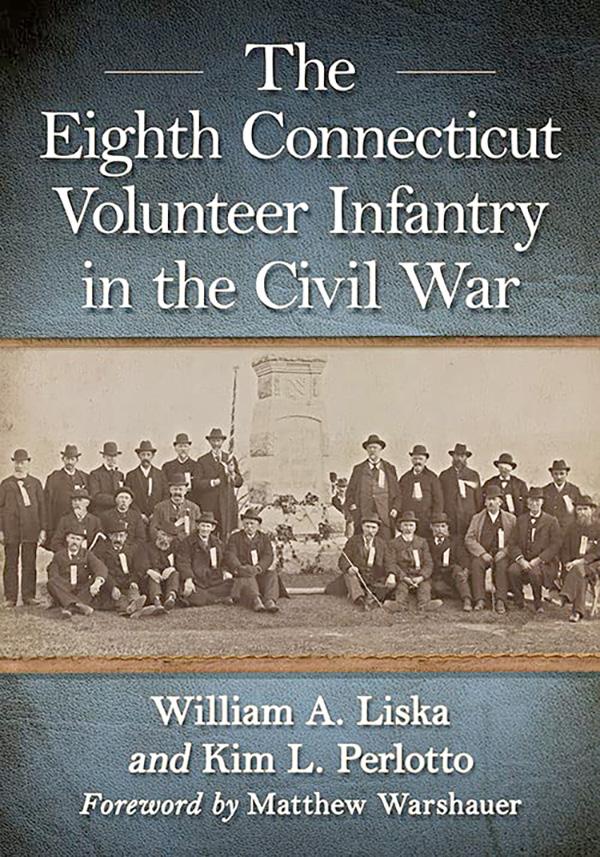
As the authors point out, owing to the length of its service, the regiment sampled virtually every experience the war had to offer. Indeed, this book foregrounds what is too often taken for granted in our military histories: the demands of toggling between camps and campaigns, offensives and occupations, furloughs and front lines.
The 8th Connecticut played a minor part in the fiasco at Fredericksburg, after which they settled into a winter encampment at Newport News. When spring came and temperature rose, they filed into the defensive works ringing Suffolk, a key Union garrison in southeastern Virginia.
After Confederates under James Longstreet lifted their siege, the regiment held the region on occupation duty before taking advantage of a much-needed furlough.
Union General John T. Wilder: Southern Industrialist. By Steven Cox. Illustrated, bibliography, index, Mercer University Press, https://www. mupress.org, 2023, 203 pp., hardbound, $35.00.

Reviewed by Wayne Wolf
Regimental histories have crowded Civil War bibliographies since the conflict itself. In an index of the obligation they felt to history, Union veterans produced more than 700 unique volumes in the late nineteenth and early twentieth centuries. In the centennial era and beyond, the tradition persisted with popular narratives penned by the likes of John J. Pullen, Alan T. Nolan, and Richard Moe.
Modern historians have once more revived the form. The best recent additions to the genre have narrated the conflict from some oblique angles, or else intervened in larger interpretive debates.
Susannah J. Ural’s treatment of Hood’s Texas Brigade, for instance, revealed how families and communities sustained one of the Army of Northern Virginia’s most devoted brigades.
Lesley J. Gordon’s chronicle of the 16th Connecticut asked what happened when a regiment broke in battle. Mark H. Dunkelman studied “esprit de corps” in the 154th New York. Whereas older unit histories tended to privilege the most conspicuous, well-disciplined, and hardfighting regiments, newer work
Harvested from every corner of the Nutmeg State, the 8th Connecticut first stood to attention at Hartford in September 1861. With no more than a month of training under their belt plates, they embarked for Annapolis via New York City. Their first wartime errand was to join Burnside’s expedition along the coast of North Carolina. While the unit met the Confederates in important battles at Roanoke Island, New Bern, and Fort Macon, their deadliest enemy was disease. Unhygienic camps, poor weather, and deficient rations conspired to lengthen the regimental sick rolls well into the summer.
Returning just in time to check Lee’s Maryland invasion in the fall of 1862, the 8th Connecticut was packed off to the Army of the Potomac. Their demanding itinerary during the second week of September supports the contention that McClellan moved into Maryland with great alacrity. The regiment played no significant role in the battle of South Mountain, but it was much less fortunate three days later at Antietam. On the afternoon of September 17, 1862, a daring, forlorn assault on the Confederate right halved the regiment’s strength.
Returning south in the spring of 1864, the men joined Maj. Gen. Benjamin Butler’s Army of the James, which readied an offensive on the Bermuda Hundred south of Richmond. There, the 8th Connecticut saw action at Swift Creek and Drewry’s Bluff. The Bermuda Hundred operations, of course, rather quickly came to grief. The Army of the James, however, would play a key supporting role once the Army of the Potomac battled its way closer to Richmond in the bloody Overland Campaign. Grant summoned the regiment, now part of Baldy Smith’s XVIII Corps, to the crossroads at Cold Harbor, where costly frontal assaults appreciably lengthened Federal casualty registers.
The Eighth continued its supporting role throughout the lengthy siege of Petersburg. Operating north of the James River, it assaulted Fort Harrison in an attack that presaged Grant’s fifth offensive at Peeble’s Farm. It would prove the regiment’s last major action before mustering out in December 1865.
In a brisk final chapter, the authors treat the 8th Connecticut’s regimental association, reunion activities, and commemorative efforts. Still, they have curiously little to say about the lives and struggles of the regiment’s veterans. How did survivors reckon with the meaning of their service? How did the nature of their wartime service shape their experience of veteranhood? Though these and other important questions remain to be answered, Liska and Perlotto have devotedly chronicled the campaigns of the 8th Connecticut.
Brian Matthew Jordan is Associate Professor and Chair of the History Department at Sam Houston State University. He is the author or editor of six books on the Civil War era, including Marching Home, which was a finalist for the 2016 Pulitzer Prize in History.
Samuel Cole Williams wrote the first full biography of General John T. Wilder in 1936. It concentrated eighty percent of its total length on his Civil War years. In order to fully explain the career and influence of Gen. Wilder, Steven Cox has penned this latest biography which traces Gen. Wilder’s early beginnings as an apprentice, millwright, and hydraulics expert, through his military career, to his postwar contributions rebuilding East Tennessee. After the war, Gen. Wilder, through his construction projects, ranging from mills and mines to hotels, railroads, and military parks, never ceased helping rebuild the Chattanooga area where he had fought years earlier.
John T. Wilder fought most of his Civil War career as colonel of the 17th Indiana Volunteer Infantry. This regiment was part of a larger unit, affectionately known as Wilder’s Lightning Brigade. He originally mustered into service as Captain of the 17th Indiana and rose through the ranks to brevet brigadier general by the war’s end. From his first battle experience at Cheat Mountain, through his leadership at the Battles of Munfordville, Tullahoma, Hoover’s Gap, Ringgold, and Chickamauga, he displayed outstanding leadership, resourcefulness, ingenuity, and bravery, earning the genuine admiration of his troops and his commanders. In June 1864, he left field service due to a continuing battle with dysentery.
Briefly returning in October 1864, he served in administrative roles until the war’s end. While garrison duty ended his military service, it did not mean an end to his entrepreneurial contributions to rebuilding the South during Reconstruction. In fact, he was one of the few “carpetbaggers” who genuinely gained the admiration of the people of Eastern Tennessee. In this area he built the first blast furnace in the South, was elected mayor and postmaster in Chattanooga, started a free school system in Chattanooga, opened two hotels on Roan Mountain, served on the Board of Directors of Chattanooga University, and Vice President of the 3C’s Railroad. He additionally operated four mines in the town of Wilder, named after him, promoted the establishment of the Chattanooga and Chickamauga National Military Park, and became the pension agent for Knoxville, Tennessee. While these were his major contributions, smaller endeavors included founding factories, mines, railroads, and social causes. He never stopped until his death in 1917. Two historical lapses appear in the text. Andrew Johnson served as Vice-President in March 1865, not 1864. Moreover, Fort Donelson and Fort Henry were Union victories, not losses. These errors appear to be from confused sentence structure rather than historical inaccuracies. Aside from these errata, the book is very readable, well-researched, and contributes to a better understanding of this remarkable Union leader, Southern industrialist, and devoted husband and father.
Dr. Wayne L. Wolf is Professor Emeritus at South Suburban College and past president of the Lincoln-Davis Civil War Roundtable. He is the author of numerous books and articles on the Civil War, including Civil War Letters, The Last Confederate Scout, Heroes and Rogues of the Civil War (4 Volumes), and Two Years Before the Paddlewheel. He is a frequent speaker on the role of the common soldier in the Civil War.
36 CivilWarNews.com October 2023 36 October 2023 CivilWarNews.com
Subscribe or Renew Online at CivilWarNews.com
To Advertise In Civil War News? Email us at ads@civilwarnews.com
Want
A Primary Source that Reveals Much
I Thank the Lord I am Not a Yankee: Selections from Fanny Andrews’s Wartime and Postwar Journals. Edited by Stephen Davis. Notes, index, 320 pp., 2023. Mercer University Press, www.mupress.org. Hardcover. $35.
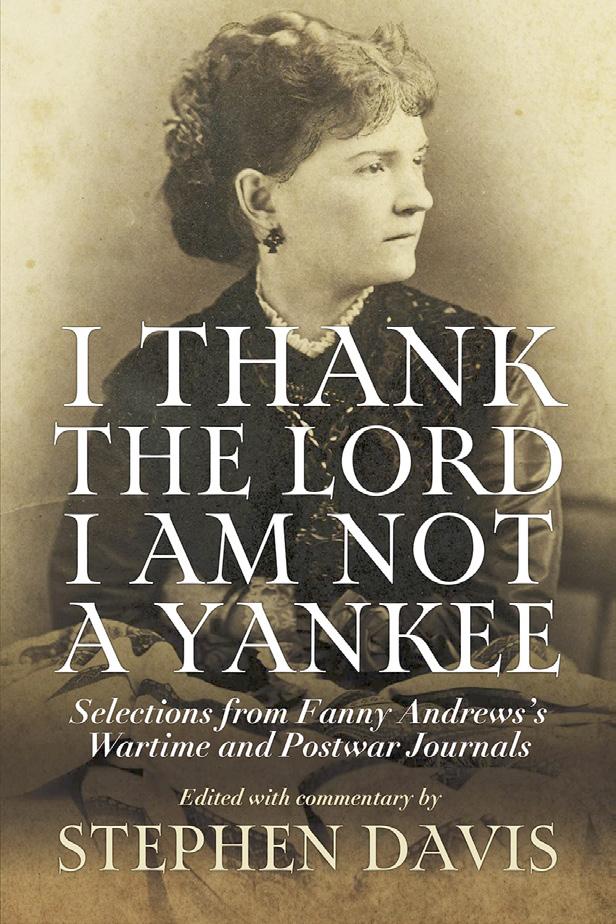 Reviewed
Reviewed
by
Jonathan A. Noyalas
A Worthy Tribute
While Andrews’s journal offers valuable perspectives about wartime devastation in Georgia, the conflict’s economic toll, and the war’s impact on Confederate soldiers, it offers important insight into an array of topics, most notably slavery’s destruction. Since Andrews’s journal straddles the transition period from the Civil War’s final months to the early period of postwar Reconstruction, her musings laced with rhetoric one would expect from an ardent Confederate supporter, exposes some of the struggles freed people confronted in transitioning to freedom. Her writings also illustrate how difficult it was for former enslavers to confront the reality that Union triumph meant slavery’s annihilation.
those who once supported the Confederacy would “suffer some terrible retribution…for letting such things happen.”
The editor’s inclusion of selections from Andrews’s 1870 journal, which includes her thoughts during her travels in New York and New Jersey during the late summer of that year, and eight articles Andrews penned for Scott’s Monthly Magazine about an array of topics including manners, fashion, and judging character further enhance this volume.
Clara Barton: Civil War Humanitarian, edited by Terry Reimer, The National Museum of Civil War Medicine Press, https:// www.civilwarmed.org/shop. 187 pp. $24.95.
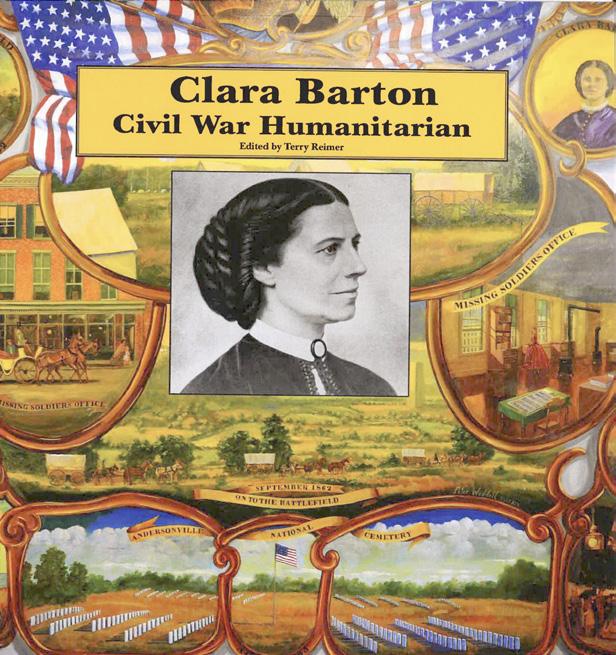
Reviewed by Meg Groeling
Massachusetts Infantry, fresh from being attacked in Baltimore on their way to Washington in mid-April 1861, to an intriguing “thought experiment” concerning the effect her humanitarian efforts might have in outer space.
On November 15, 1908, The Baltimore Sun published an admiring review of Eliza Francis Andrews’s recently released The War-Time Journal of a Georgia Girl. The paper branded Andrews’s book as “truly a fascinating and historically valuable record of events transpiring in Georgia from the fall of 1864 to the beginning of the Reconstruction period.” Since its initial release by D. Appleton and Company in 1908 historians have extensively used Andrews’s diary and numerous publishers have reprinted it. Despite the value of earlier editions, this one, edited by the prolific Stephen Davis, is a masterpiece of editorial scholarship. In addition to extensive annotations and commentary that situate Andrews’s writings within the Civil War era’s broader context, this edition includes a bevy of Andrews’s postwar perspectives which have largely lived in obscurity.
In the final days of 1864, after Union general William T. Sherman’s March to the Sea, twenty-four-year-old Eliza Andrews and her younger sister Metta departed their home in northeast Georgia to visit their sister “in the opposite corner of the state.” Andrews sensed the journey would reveal scenes she had never witnessed and thought it wise to record all she saw. Fortunately for historians, not just those interested in the conflict in Georgia, but those who study the Civil War’s impact on civilians and landscapes, Andrews maintained her journal for the next eight months.
Additionally, this journal provides perspectives about an array of Confederate political and military figures including Jefferson Davis, Zebulon York, and Braxton Bragg. Andrews is even-keeled in her assessment of individuals. For example, although Andrews freely admitted that she “was never a special admirer” of Bragg, she thought him a good disciplinarian. A lack of discipline was certainly something that Andrews witnessed as she encountered Confederate soldiers journeying home after the surrenders of Confederate forces in the spring of 1865. While Andrews did all she could to provide necessities to paroled Confederate veterans, the boldness of some, such as a contingent of troops from a Texas regiment, to take private property bothered Andrews a great deal.
Beyond offering insight into the complexities of the conflict’s final months and the war’s immediate aftermath Andrews’s journal also shows how those who supported the Confederacy struggled with some of the war’s most dreadful legacies. Despite her hatred for “Yankees,” something her postwar journals indicate she maintained until her death in 1931, Andrews seemed bothered by the tragic end suffered by thousands of Union prisoners of war at Andersonville.
Although Andrews believed that the camp’s commander, Captain Henry Wirz, should not be held liable for the horrific conditions at Andersonville and that some culpability for the horrific loss of human life there should be shouldered by the United States government for the transformation of its exchange policy, Andrews sympathized with the prisoners’ plight. Andrews believed that

Smartly edited and wonderfully contextualized Stephen Davis’s edition of Andrews’s writings has wide appeal. For those interested in Georgia’s Civil War era this volume is essential. Historians, students, and buffs seeking an additional voice about war’s tragic consequences and the transition from war to peace will find this book quite useful.
Jonathan A. Noyalas is director of Shenandoah University’s McCormick Civil War Institute in Winchester, Virginia, a professor in Civil War Era Studies at Shenandoah University, and founding editor of Journal of the Shenandoah Valley During the Civil War Era. He is the author or editor of fifteen books including most recently Slavery and Freedom in the Shenandoah Valley during the Civil War Era, published by the University Press of Florida.
What a pleasure to review a book that will appeal to so many. Its excellent writing and historical relevance make it valuable to those who want more information about Clara Barton and the roles she played during her lifetime. In addition, its striking format, compelling illustrations, and readability make it valuable to readers who initially might only have a passing interest in the topic of Barton or Civil War medicine in general. Clara Barton: Civil War Humanitarian is a bookshop winner.
Many of the essays were initially published in Surgeon’s Call: Journal of the National Museum of Civil War Medicine, the magazine of the museum in Frederick, Maryland. They follow Barton from her initial visit to welcome the 6th
The Truth about the Battle of South Mountain
All other authors who have written about Confederate BG John Bell Hood misplaced his location by approximately one half-mile.
Available as an Audible Audiobook, ebook and hardcover on Amazon
There are illustrations on every page. These vary from artifact photographs to letters written to Ms. Barton from mothers and wives asking for help in finding missing loved ones who never returned from the war. Letters, drawings, war photographs, original copies of the Rolls of Missing Men, and portrait photographs of those who supported Clara Barton in her various endeavors can be found sprinkled throughout this beautifully designed book. At the end of each chapter are excellent footnotes and suggestions for “Further Reading.”
Most importantly, this book makes a valuable contribution to Barton’s legacy. Historiography would have one believe that Clara Barton was a nurse during the American Civil War. She did some nursing but was not a member of any nursing corps. Instead, Barton saw her mission through a much larger lens. She worked tirelessly, alone and with the U.S. Sanitary Commission, to gather provisions and medical supplies for the Union Army and provided help wherever needed, battlefield or hospital. Barton began the Missing Soldiers Office at her home in Washington. Her chance meeting with released Andersonville captive Dorence Atwater helped create the Rolls of Missing Men, lists of those who had perished at the Andersonville Prison camp. With his help, Barton increased her efforts to search for soldiers reported missing during the war. She was able to locate over 22,000 of them, living and dead.
Her work with the U.S. Sanitary Commission and the federal government led her naturally to the International Red Cross during the 1870 Franco-Prussian War. Returning home, Barton inaugurated the American Red Cross. She responded in person to the victims of the Spanish American War, the Jonestown Flood, and the Galveston Hurricane in 1900.
This book went to #1 in three Amazon New Releases categories.
“This is a must-read for anyone interested in one of the Civil War’s pivotal campaigns.” – Scott L. Mingus Sr., coauthor of Unceasing Fury
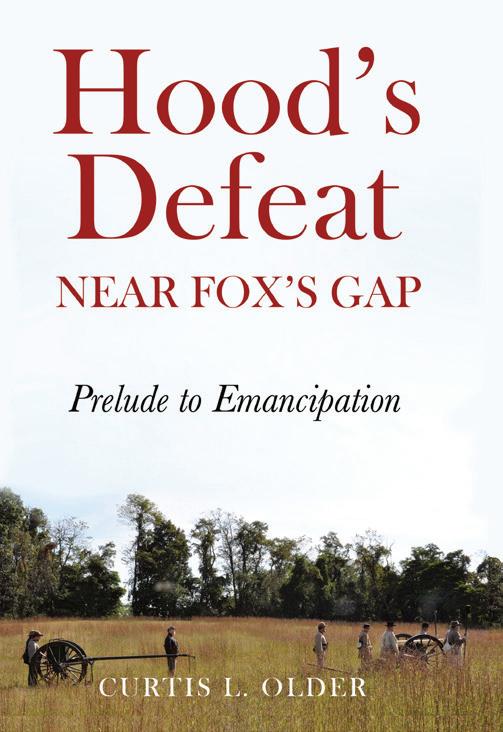
“Curtis Older’s research on the Battle of South Mountain re-examines and reinterprets the Maryland campaign, finally quelling all further discussion on why Lee lost his first major battle action. Highly recommended.” – ARGunners.com
Her home and the Missing Soldiers Office were rediscovered in 1996 and opened as a museum and performance space in 2015. The Washington site is under the auspices of the National Museum of Civil War Medicine in Frederick, Maryland, which is responsible for this book. It is a worthy tribute to Clara Barton, whose life continues to inspire.
The late Meg Groeling was remembered in the September Civil War News
37 October 2023 37 October 2023 CivilWarNews.com CivilWarNews.com
The Artilleryman is a quarterly magazine for collectors, competition shooters and those interested in ordnance from the Revolutionary War to World War II, primarily focusing on cannon, implements, projectiles and related artifacts from the American Civil War. This full color magazine features articles on cannon safety, artillery history, projectiles, fuses, places to visit, book reviews, competition events, and so much more. The annual quarterly subscription price is just $37.95.

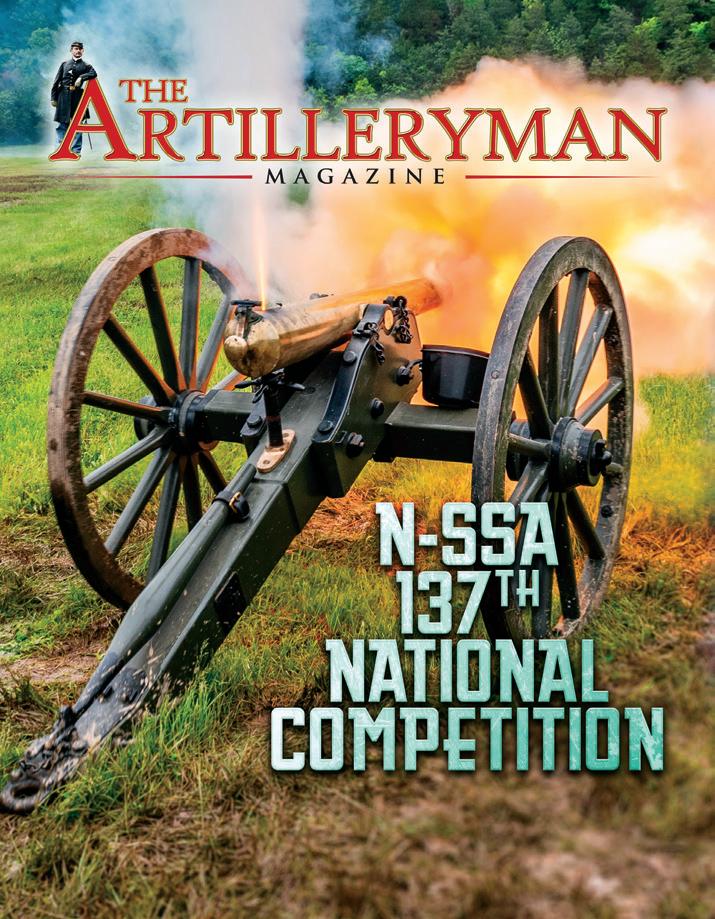

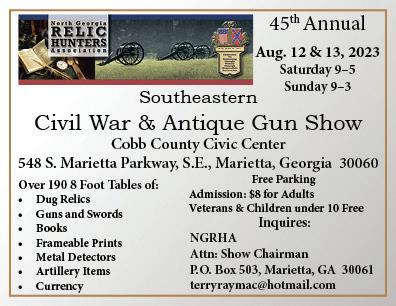
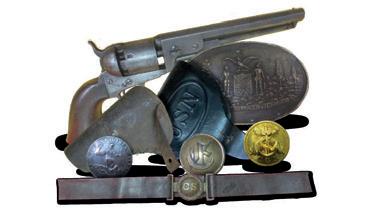


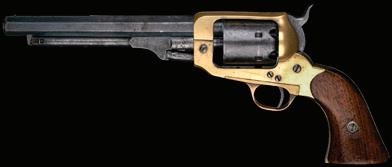


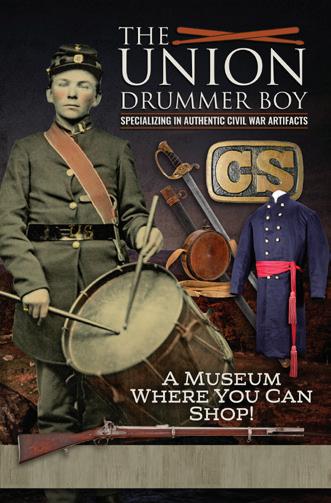





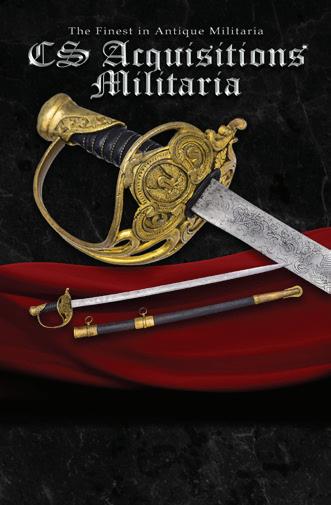



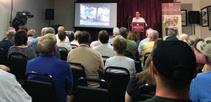

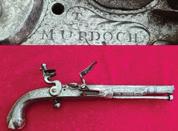



Military Antique Collector is a bi-monthly magazine with detailed high-resolution color photographs of some of the world’s most beautiful and unusual military collectibles. Dedicated to both the expert collector and novice alike, each issue is filled with informative articles written by leading authorities in their fields of expertise, including distinguished well-known authors, along with prominent museum and auction professionals. Issues spotlight rare and unusual military objects, craftsmanship works, and their relationship to historical figures dating from early American and European history to limited coverage of the post-1898 artifact. Priced at only $49.95 for 6 issues. It’s easy to see why Military Antique Collector magazine has become popular so quickly.
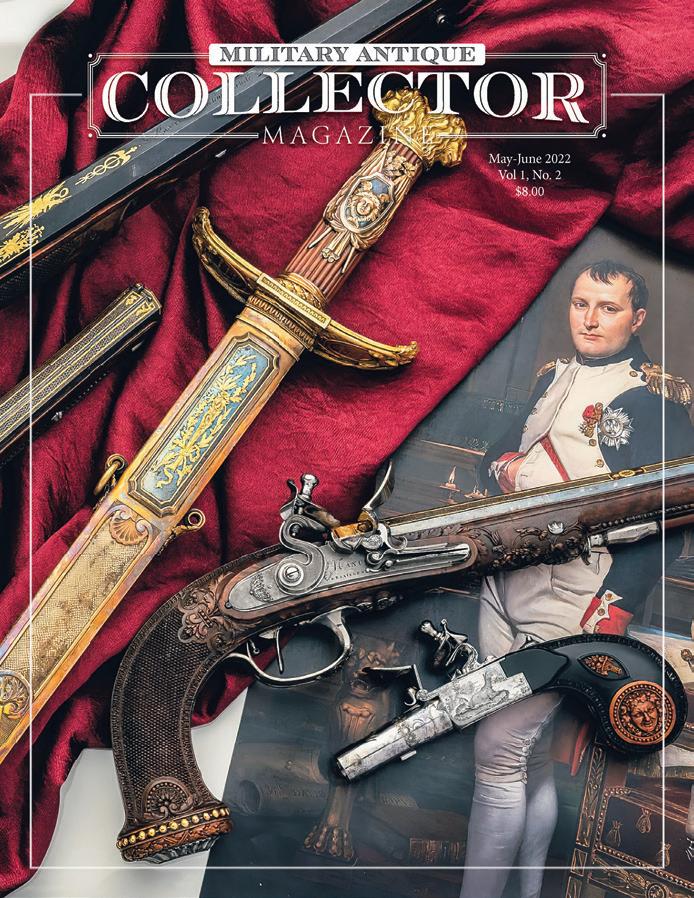

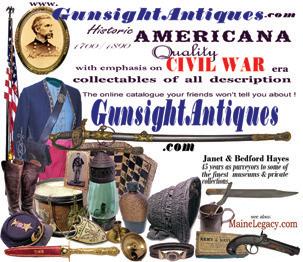



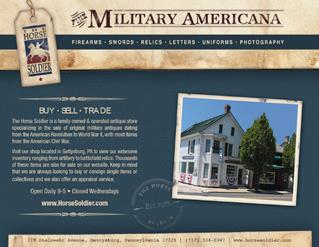










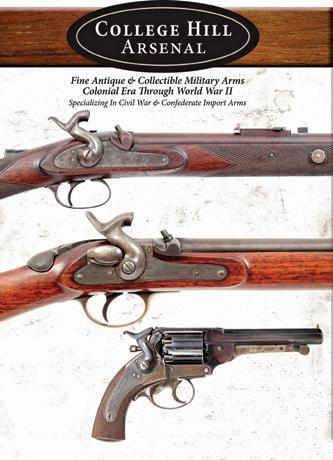
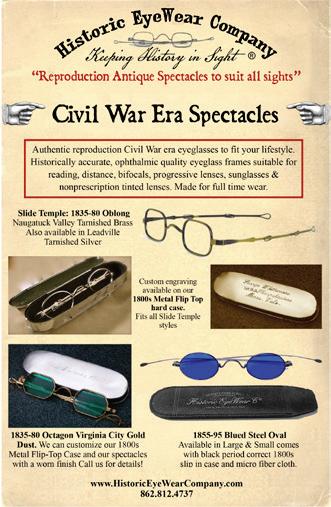
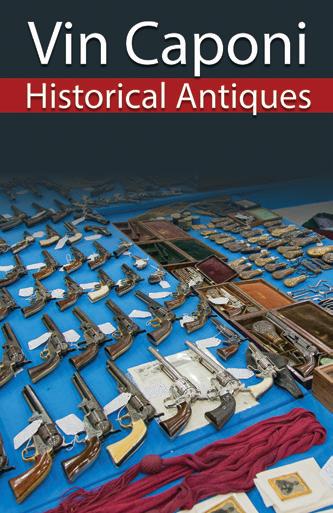












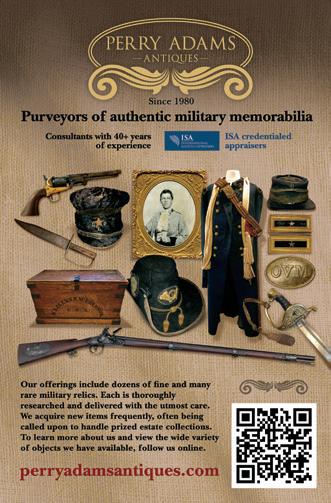













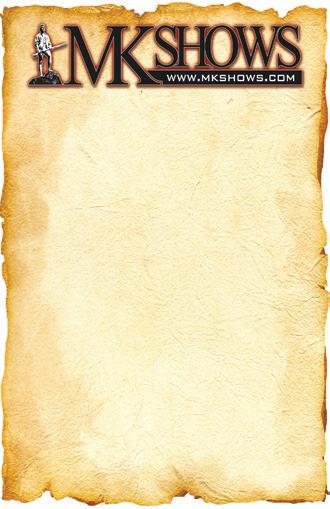










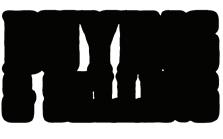

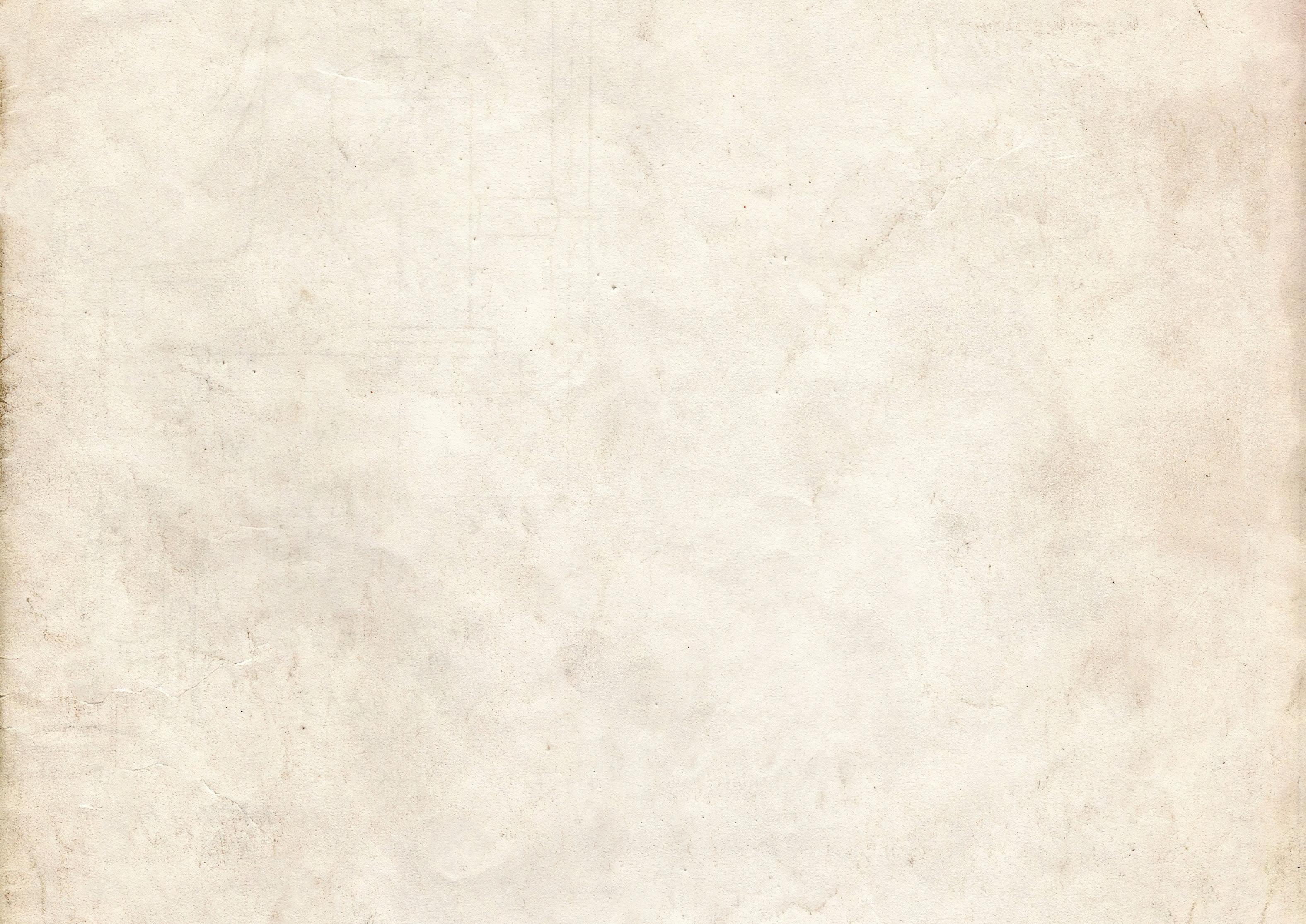
38 CivilWarNews.com October 2023 38 October 2023 CivilWarNews.com Museum Quality Civil War Union & Confederate Artifacts! WE HANDLE THE BEST Antique Bowie Knifes Civil War Swords Confederate D-guards Antique Firearms Dug Relics Buckles & Belts Identified Relics Letters & Documents Images & Currency Flags ALLEN WANDLING 618-789-5751 • awandling1@gmail.com MidWestCivilWarRelics.com CONSIGNMENTS WELCOME Contact Glenn Dutton at: glennjdutton@aol.com or 770-351-7565 BUYING & SELLING Field & Heavy Artillery Cannon, Shells, Fuses & Etc. WE BUY ANTIQUE WEAPONS www.AndrewBottomley.com Mail Order Only Worldwide Shipping Calling the UK from overseas: +44 1484 685 234 Calling our UK cellphone from outside the UK: +44 7770 398 270 email: sales@andrewbottomley.com The Coach House, Holmfirth, England HD9 3JJ English Mortuary British Military Flintlock Your trusted source... ...for BOOKS, year-round author talks & appearances and MORE! www.GettysburgMuseum.com Operated by the nonprofit Gettysburg Nature Alliance Licensed available! 2023 Civil War Dealers Directory To view or download a free copy visit: civilwardealers.com/dealers.htm Promoters of Quality Shows for Shooters, Collectors, Civil War and Militaria Enthusiasts Military Collectible & Gun & Knife Shows Presents The Finest (770) 630-7296 Mike@MKShows.com • www.MKShows.com Northwest Georgia Trade Center 2211 Tony Ingle Parkway Dalton, GA 30720 February 4 & 5, 2023 Chickamauga (Dalton) Civil War Show Williamson County Ag Expo Park 4215 Long Lane Franklin, TN 37064 December 2 & 3, 2023 Middle TN (Franklin) Civil War Show l l app and hover over the image to go directly to the website for current WALLACE MARKERT csacquisitions@gmail.com 16905 Nash Road Dewitt, Virginia 23840 804-536-6413 www.csacquisitions.com Shiloh History@shilohrelics.com owner Rafael Eledge .com Dealing in the Finest Authentic Militaria Since 1995 Pistols, Muskets, Carbines, Rifles, Bayonets, Swords, Uniforms, Headgear, Belt Buckles, Cannon, Buttons, Are you… RebelRelics.com “You gonna check out my website or whistle Dixie?” Brian “Rebel” Akins Call the “Rebel,”and let me show you Greg Ton Buying the Finest in Confederate, Southern States Currency Greg Ton • P.O. Box 9 Franklin, TN 37065 Phone: 901-487-5944 • Email: GTon1@aol.com Since 1978 GregTonCurrency.com We have been a family business since 1965, buying and selling fine antiques. Our collection of antiques ranges from Civil War military to antique military and toys. Vin Caponi Historic Antiques 516-593-3516 516-353-3250 (cell) vincaponihistoricantiques.com 18 Broadway, Malverne, NY 11565 34 York St • Gettysburg, PA 17325 717-334-2350 CIVILWAR@UNIONDB.com www.uniondb .com www.CollegeHillArsenal.com College Hill Arsenal Nashville, TN 37217 615-972-2418 John Sexton ISA-CAPP 770-329-4984 CivilWarAppraiser@gmail.com OVER 40 YEARS EXPERIENCE Is your collection appraised and inventoried for your heirs and family? CONFIDENTIAL APPRAISALS & AUTHENTICATIONS Schedule essential estate planning appraisal today for your valuable collection www.CivilWarBadges.com Everitt Bowles • p: 770.926.1132 c: 678.480.1338 badges@bellsouth.net 1036 Washington Ave. Woodstock, Georgia 30188 The Largest Selection of GAR & UCV Hundreds of Memorabilia Items from Rev War through Vietnam Secure & Easy Guaranteed Authenticity of Every Item Buying and Selling original Civil War Confederate & Union Buttons, Belt Buckles, and Allen Gaskins NC Relics Steve and Melody Strickland 770-633-5034 info@dixierelicsonline.com HTTPS://DIXIERELICS The Maryland Arms Collectors Assoc., Inc. presents The “Original Baltimore” Antique Arms Show Since 1955 Maryland State Fairgrounds Timonium, MD North of Baltimore, York Road, MD. Rt. 45 1,000 8-Foot Tables March 18-19, 2023 Public Hours: Sat. to 5, Sun. 9 to 3. Admission: $10.00 – Modern Handguns are Prohibited –Complete information on web site: www.baltimoreshow.com Known as the “CROWN JEWEL” of Collector’s Shows! Welcoming Consignments Historical Ephemera & Photography complimentary estimate on single item or entire collection. 3910 Highway 70 East, New Bern, NC 28560 civilwarshop@gmail.com WE BUY! WE APPRAISE! www.civilwarshop.com Federal Firearms Licensed Dealer National Rifle Association (NRA) Life Member, Sons of ConfederateVeterans
Vol. 39, No. 4 Fall 2018 $8.00 ArchaeologicalExcavationsataConfederateBattery•HistoricalArtilleryofLeHôpitaldesInvalides Coastal Artillery at Fort Moultrie • 100-Pounder Navy Parrott Shells Confederate 2.25-Inch Projectile Identified • The Evolution of Brooke Sabots Also in is issue: HistoricalPublicationsLLC.com
Before making plans to attend any event contact the event host.
Sept. 23, Illinois. Civil War & Military Extravaganza
Zurko Promotions presents The National Civil War Collectors Fall Show and Sale which will be held at the DuPage County Fairgrounds, 2015 W. Manchester, Wheaton, Ill. Hours: 9 a.m. to 4 p.m. Admission is $10, Early Admission $25. Free parking. For more information visit www. chicagocivilwarshow.com or call Zurko Promotions at 715-526-9769.
Oct. 6-8, Virginia, Annual Conference
Central Virginia Battlefields Trust hosts its 2023 annual conference, “1863: Chancellorsville-The Crossroads of Fire.” This year’s conference features a Friday tour of Moss Neck, Gen. “Stonewall” Jackson’s 1862-63 winter headquarters with historian Frank O’Reilly. That evening the President’s Reception will be at the Sentry Box, one of Fredericksburg’s most historic homes. Saturday features a tour of the Chancellorsville battlefield with historians Chris Mackowski and Kris White. Saturday evening includes a banquet and the annual meeting with a keynote address by Kris White at historic Belmont in Falmouth. Sunday brunch at Stevenson’s Ridge includes a panel discussion about “Chancellorsville as the Prelude to Gettysburg” with historians Sarah Kay Bierle, John Hennessey, Robert Lee Hodge, Scott Walker, and others. The weekend registration is $260 per person. More information and online registration are available at: https://www.cvbt.org/ cvbt-annual-conference.
Oct. 6-8, Virginia. Period Firearms Competition
The North-South Skirmish Association 148th National Competition near Winchester. Over 3,000 uniformed competitors in 200 member units compete in live-fire matches with muskets, carbines, revolvers, mortars and cannon plus costume competitions and historical lectures. The largest Civil War livefire event in the country. Free admission, large sutler area, and food service. For more information visit the N-SSA web site: www.n-ssa.org.
Oct. 21-22, Virginia. Reenactment
The 159th Anniversary Reenactment of the Battle of Cedar Creek recreating the last major battle in the Shenandoah Valley will be held the weekend of Oct. 21-22 at 8437 Valley Pike in Middletown, Va. See cavalry, artillery, and infantry soldiers in action and in camp. Battle scenarios, music, symposia, and medical, military, and civilian demonstrations are scheduled each day. Fundraising raffles, period merchants, and food vendors onsite. Don’t miss the Evening Candlelight Tour Program. 1-day, 2-day, and discount options available! Children 6 and under are free! For more information; 540-8692064, info@ccbf.us or www.ccbf.us.
Nov. 4, Virginia. Civil War Books, Relics and Memorabilia Show
The show will be held on Saturday November 4 from 10-4 at the Elks Lodge on Rt. 50 In Fairfax, Va. Admission is $5 per person. Vendors are welcome. Information and vendor registration may be obtained at mayo5304@cox.net or 703-389-1505.
Nov. 4, Virginia. Seminar & Tour
Shenandoah University’s McCormick Civil War Institute annual fall seminar and tour with Prof. Jonathan A. Noyalas, “Breaking the Shenandoah Valley’s Gibraltar: Battle and Reunion at Fisher’s Hill.” $25 registration fee covers morning lecture at Shenandoah University (1460 University Drive, Winchester, VA), lunch at SU, and vehicle caravan of sites. Event begins at 10:30 a.m. and concludes at 4:30 p.m. To register visit www.su.edu/mcwi. Questions: jnoyalas01@su.edu or 540-665-4501.
Nov. 10, Pennsylvania. US Marine Corps Birthday Observance
Join us at the Laurel Hill Cemetery, 3822 Ridge Ave, in Philadelphia at 11 a.m. at the grave of General Jacob Zeilin, 7th Commandant of the Marine Corps during the Civil War. A special ‘Veterans’ Day tour of heroes ‘killed in action’ and buried at Laurel Hill Cemetery will follow. Sponsored by: The Legion Post 405; MOLLUS; General Meade Society. For information; 215-2288200, awaski01@gmail.com, 215-423-3930 or www.thelaurelhillcemetery. org.
Nov. 18, Pennsylvania. Remembrance Day in Gettysburg
General Meade & his Generals and the veterans of the Battle of Gettysburg Honor/Dedication Ceremonies during the Remembrance Day Observance. Honoring all commanders and veterans of the Battle. Meet at the General Meade Equestrian Monument at 10 a.m. For information; Jerry McCormick at 215-848-7753 or gedwinmc@msn.com.
Nov. 18, Pennsylvania. Remembrance Day Parade in Gettysburg
67th Annual Remembrance Day Parade sponsored by the Sons of Veterans Reserve, the Military Department of the Sons of Union Veterans of the Civil War. Parade briefing on Nov. 18 at the Unity Park Monument located on Lefever Street at 12 noon. Units form up at Noon on Lefever Street between Baltimore Street and East Confederate Avenue Parade will step off at 1 p.m. For information, contact: Major David Hann, Provost Marshal SVR, 440 Clark Drive, Hammonton, NJ 08037. Email: majorsvrprovost@gmail.com, Cell 609-816-2012. Website: suvcw.org/ remembrance-day.
Nov. 18, Pennsylvania. Civil War Ball
Ball will be held at the Eisenhower Hotel & Conference Center. Music by the Philadelphia Brigade Band. Dances led by the Victorian Dance Ensemble. Period dress is encouraged, but not required. Door prizes, plus prizes for Ladies Cake Walk. Cash Bar. Time: 8 p.m.-Midnight. $20 per person in advance, $25 per person at the door. Make check payable to “SVR Remembrance Day Ball.” Include stamped, self-addressed envelope for tickets. Mail to: Col. Steve Michaels SVR, 6623 S North Cape Rd, Franklin, WI 53132-1227. Cell 414-712-4655. Email: Lt.col.sm@gmail.com. Ticket orders received after Nov. 12 will be distributed at the Ball. Ball proceeds are donated to the Gettysburg National Military Park for monument preservation.
Nov. 18-19, Pennsylvania. Civil War Ball
The Eighteenth Annual President’s Remembrance Day Dinner & Ball will once again be held at the Hotel Gettysburg. Music by Fleeting Moments Orchestra, instruction by dance mistress Susan de Guardiola. Period attire is required for both events. Ticket prices include a three-course dinner each evening. For information, www.remembrancedayball. com or call John Newbold at 717-420-5145 for full details.
Nov. 18, Virginia. Civil War Show
In conjunction with the Central Virginia Civil War Collectors Association, Bullet and Shell is proud to present the 42nd Annual Central Virginia Military Antique Show (formally Mike Kent’s Capital of the Confederacy Civil War Show). This year, the show is moving to a new location at Meadow Event Park, 13191 Dawn Blvd, in Doswell, Va. The show will host vendors and displays of American military history from the Revolutionary War through WWII. Bring your relics for appraisal or to sell. Over 300 tables! There will be many historical items to add to your collection. Show hours are 9-5 on Saturday, vendor setup on Friday. Parking is free and admission is only $10/adults with children under 12 free. For more information; www.MilitaryAntiqueShow.com.


Dec. 3-4, Tennessee. Civil War Show and Sale
MK Shows presents the 36th annual Middle Tennessee Civil War Show and Sale at the Williamson County Ag Expo Park, 4215 Long Lane in Franklin. The nation’s largest Civil War show, featuring 750 tables of antique weapons, artifacts and memorabilia from top dealers and collectors around the country and encompassing all eras of military history from the Revolutionary War through World War II. Appraisers are always on hand to help you identify and value your military collectibles at no cost. Hours are 9-5 on Sat., 9-3 on Sun. Free Parking. Admission is only $10/ adults and children under 12 are free. For information; www.MKShows.com or Mike@MKShows.com.
Dec. 31, Pennsylvania. Annual General Meade Birthday Celebration
This year will mark the 208th annual anniversary of the birth of General George G. Meade. The General Meade Society of Philadelphia will celebrate his birthday at Historic Laurel Hill Cemetery, 3822 Ridge Ave. at noon. A champagne toast and reception will follow the program. For information; 215-228-8200 Laurel Hill Cemetery. https://www.historicalpublicationsllc.com/site/eventlistings.html for all 2023 events.
l39 October 2023 39 October 2023 CivilWarNews.com CivilWarNews.com
lPromoters of Quality Shows for Shooters, Collectors, Civil War and Militaria Enthusiasts Mike Kent and Associates, LLC • PO Box 685 • Monroe, GA 30655 (770) 630-7296 • Mike@MKShows.com • www.MKShows.com December 2 & 3, 2023 Middle TN (Franklin) Civil War Show
Mike@MKShows.com • www.MKShows.com Admission Coupon To Any MKShows Event $1 Off 770-630-7296
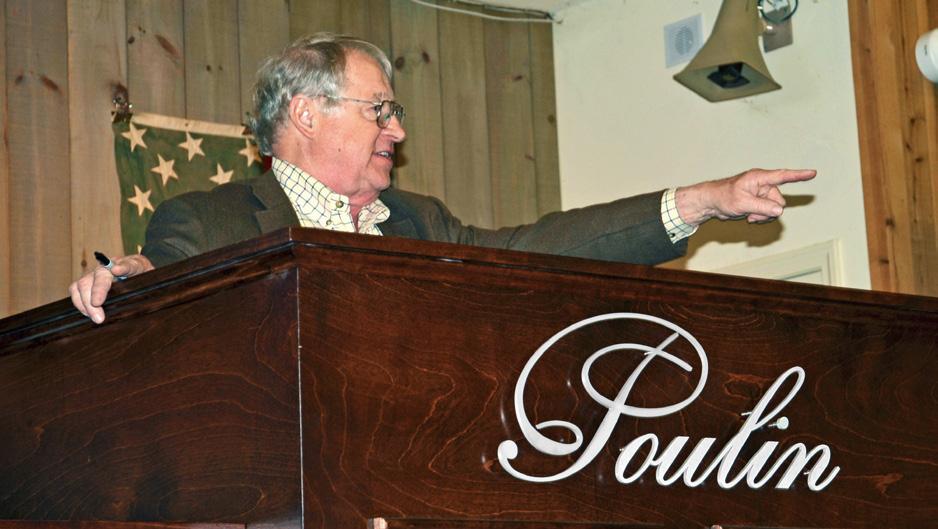


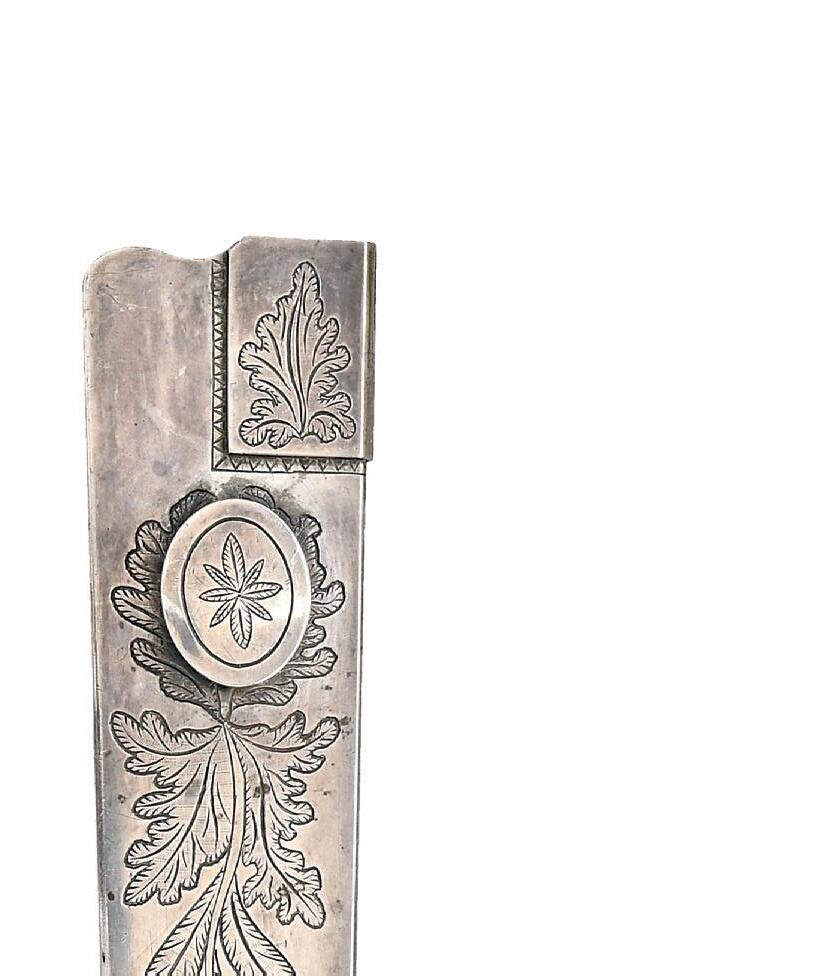

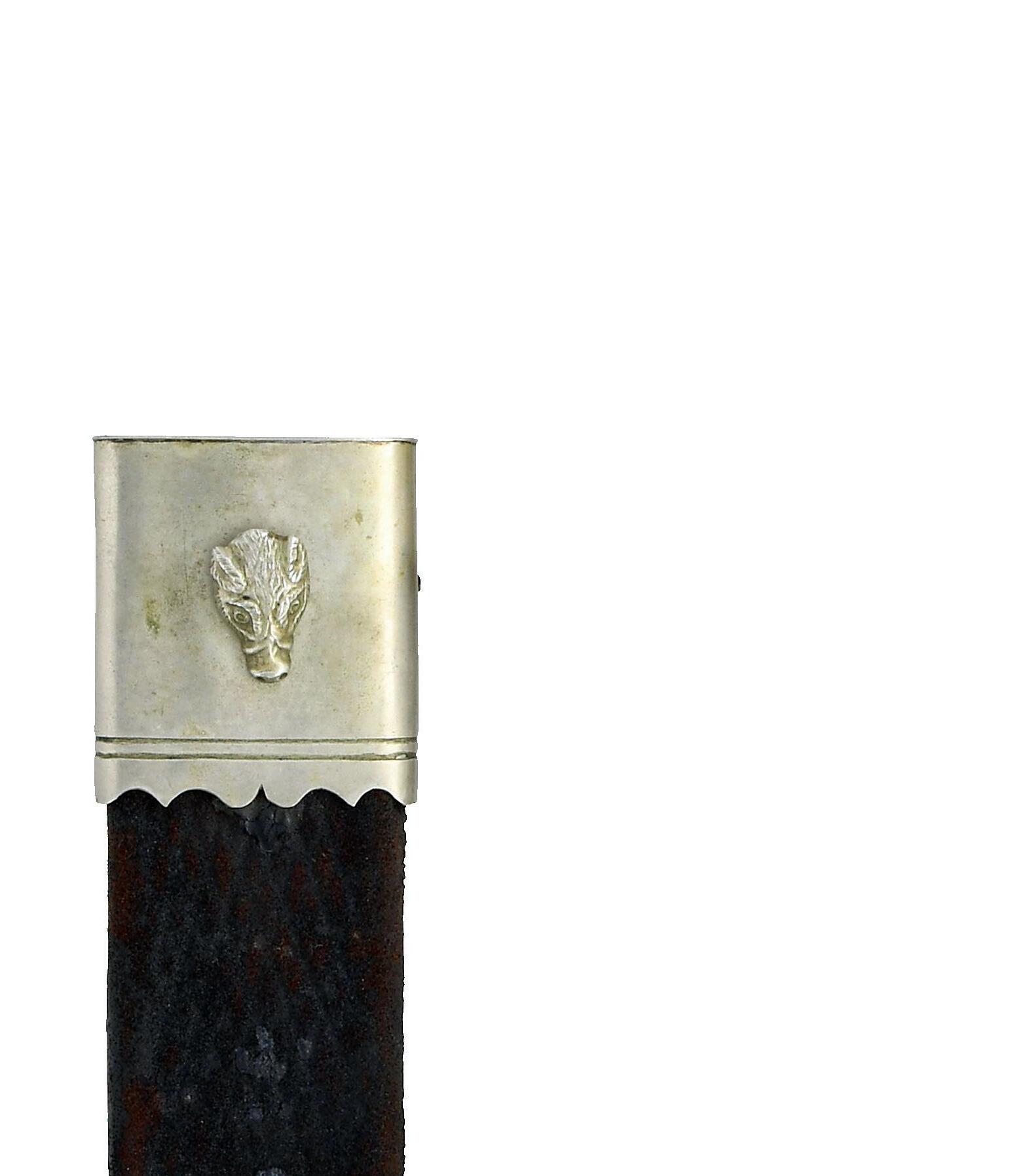


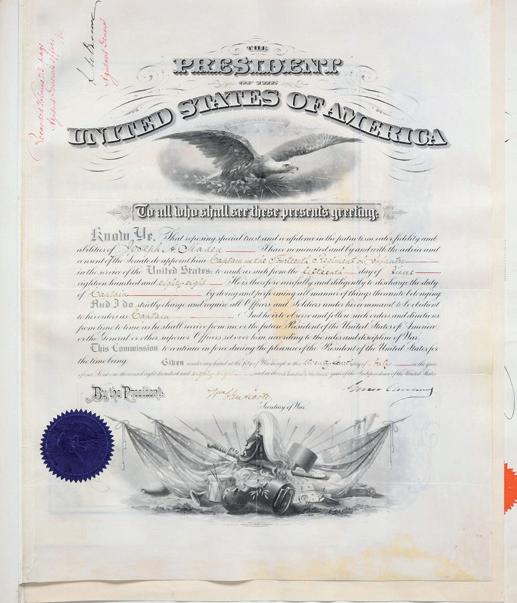
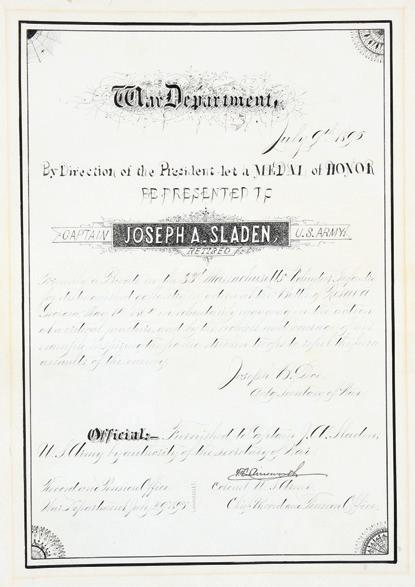



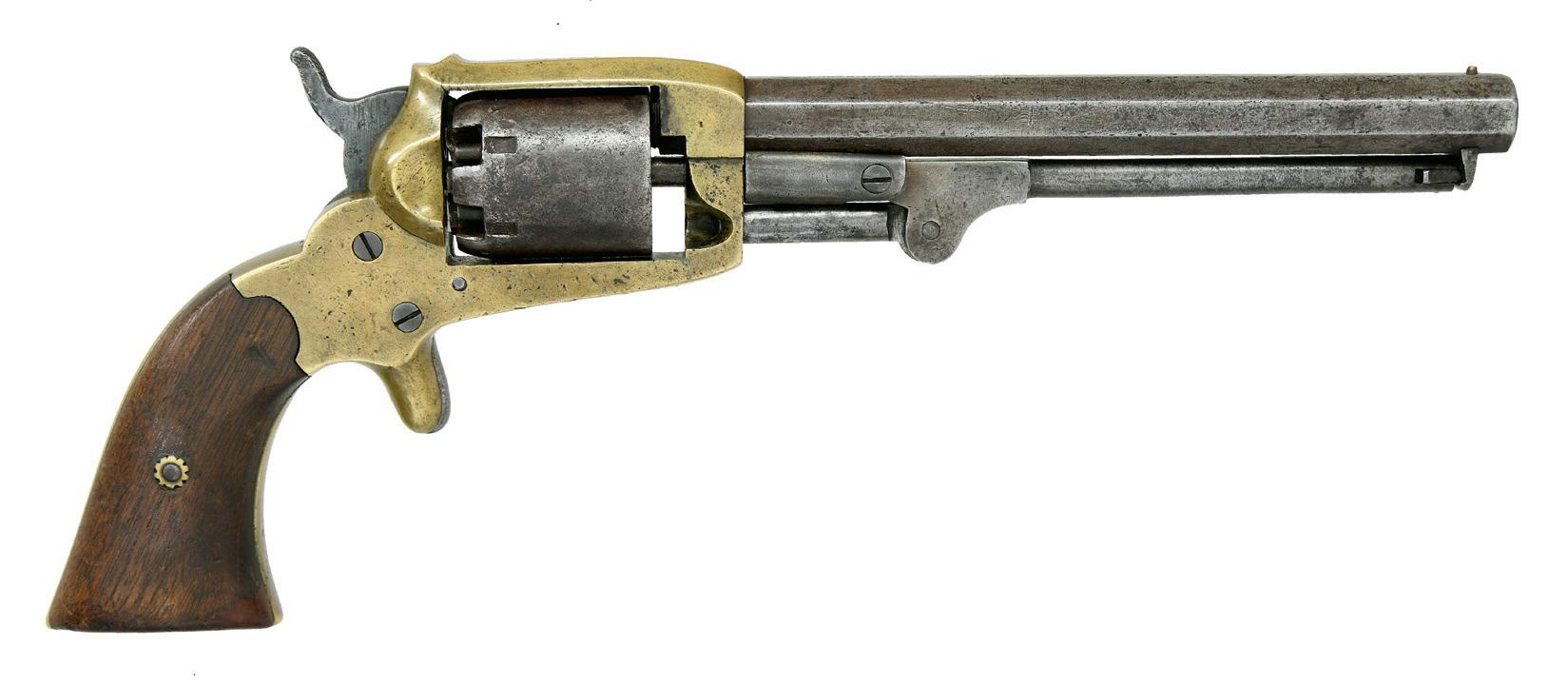
poulinauctions.com | 199 Skowhegan Rd, Fairfield, ME 04937 | Stephen Poulin, ME Lic # 1115 • Reputation - Sterling reputation for honest, straight forward business relationship with both buyers and sellers alike. • The Best Rates In The Industry - The Poulin & Julia family provides the most competitive commission rates in the industry. Including 0% or better seller’s commission on expensive items and valuable collections. • Finest Expertise - We utilize over 250 years of combined professional consultant experience and an additional three-generations of marketing expertise of nearly $1 BILLION in combined total sales experience by the Poulin & Julia Family. • Unique Auction Description Guarantee - We utilize honest, knowledgeable and detailed descriptions with the most comprehensive guarantee, building the highest level of confidence from bidders and generating the greatest return for consignors. • Presentation - Building interest and enthusiasm from potential bidders is crucial for achieving the maximum value for our consignors. Utilizing the finest detailed photography, catalog design and state of the art auction facility generates the highest level of excitement from potential bidders & the best results for your collectibles. • Additional Poulin & Julia Family Benefits - Fully insured, numerous bidding options available, complimentary consignment pick up for expensive items and valuable collections, massive client base of international and domestic clientele & extremely aggressive marketing campaign. Nearly IN COMBINED TOTAL SALES EXPERIENCE Contact Jim for a free consignment consultation at (207) 742-0007 or email jamesjulia@poulinauctions.com $1 BILLION His expertise and experience in marketing and achieving the best results for high end quality firearms & collectibles will help continue to grow our firm into the leading specialty firearms auctioneer in the world. We are pleased to announce the renewed partnership with the world-famous auctioneer... D. Julia! 0% Or Better! Seller’s Commission On Expensive Items & Valuable Collections THE POULIN & JULIA FAMILY DIFFERENCE If you are interested in more information about consigning a single item or an entire collection, we would very much like to discuss with you the methods and strategies to generate you, the consignor, the greatest return. Contact James Julia for a free consignment consultation at: or by email: (207) 742-0007 jamesjulia@poulinauctions.com THE TRADITION CONTINUES... FAMILY REUNION! Visit Poulin Auctions YouTube.com to view a large variety of in-depth videos! Reconstruction Era Archive Rare Large Silver & Ebony Mounted Samuel Bell Bowie Knife, Knoxville, Tennessee Circa 1840 Rare & Fine English & Hubers #2 Philadelphia Bowie Knife Important Confederate Presentation Dufilho Staff Officer Sword FALL 2023 PREMIER FIREARMS & MILITARIA AUCTION November 3rd, 4th, 5th, & 6th, 2023 | Fairfield ME Antiques & Auctions Inc. To view additional highlights from our upcoming Fall 2023 Premier, please visit: www.poulinauctions.com




























































































































































 Reviewed
Reviewed





























































































